Sites: news | india | latam | brasil | indonesia
Feeds: news | india | latam | brasil | indonesia
topic: Lemurs
Social media activity version | Lean version
Beyond the myths: Anthropologist Alison Richard on Madagascar’s environmental realities and future
- Madagascar is celebrated for its extraordinary biodiversity, characterized by remarkably high rates of endemicism. However, Madagascar is also synonymous with loss, particularly the extinction of its largest animal species and the degradation of habitats.
- The conventional wisdom holds that the island was entirely forested before human settlement, with early settlers decimating most of these forests. Alison Richard, a distinguished anthropologist, has challenged this traditional narrative of Madagascar’s environmental history by leveraging a growing body of research that suggests a more nuanced reality.
- In “The Sloth Lemur’s Song,” Richard weaves a captivating story covering the island’s geological past to its current conservation challenges. Her work critically assesses the narratives of blame, stemming from colonial history, that have influenced perceptions of Madagascar’s environmental issues.
- In a recent interview with Mongabay, Richard discussed her research and conservation efforts in Madagascar and beyond.
Some tree-dwelling primates may adapt more easily to life on the ground, massive study shows
- As deforestation and climate change alter rainforest habitats, monkeys and lemurs that normally live in trees are risking encounters with predators to spend time on the ground.
- Species with diverse diets, smaller body masses, and larger group sizes may adjust to terrestrial life more successfully than others.
- The huge international study drew from more than 150,000 hours of observations of 47 species in Madagascar and Central and South America.
World’s smallest primate is fading into extinction, scientists fear
- The Madame Berthe’s mouse lemur (Microcebus berthae) could soon disappear as the human imprint on its forest habitat in western Madagascar grows.
- Another team of researchers warned that the Milne-Edwards’s sifaka (Propithecus edwardsi), a species native to the tropical rainforests of eastern Madagascar, could vanish in 25 years.
- “The risk of extinction accelerates dramatically when we take into account deforestation and climate extremes,” said Eric Isai Ameca y Juárez, a specialist in biodiversity loss and climate change at Beijing Normal University, but added that deforestation alone could wipe out the sifaka.
- About a third of the tree cover inside Menabe Antimena National Park, where the Madame Berthe’s mouse lemur is found, has disappeared since 2015.
‘Unprecedented’ fires in Madagascar national park threaten livelihoods and lemurs
- Ankarafantsika National Park protects an oasis of dry forest in northern Madagascar, providing vital habitat to critically endangered lemurs and other wildlife.
- In September and October, fires raged across the southern portion of the park, burning more than 40 square kilometers (15 square miles).
- While fire is a natural part of Ankarafantsika’s ecosystems, researchers say fire on this scale is “unprecedented” and amounting to a “conservation crisis.”
- The fires are also drying out the landscape and reducing neighboring communities’ crop yields, which conservationists warn could have knock-on effects for nearby forests as people turn to natural resources to survive.
After a pandemic reprieve, loggers return to a unique Madagascar forest
- Vohibola forest is one of the last primary forests standing in eastern Madagascar, and home to the world’s tiniest frogs and other rare and endangered creatures.
- For a time, in the quiet imposed by COVID-19 pandemic lockdowns, Vohibola got a reprieve from some of the difficulties that have long plagued it, including deforestation, fires, and timber and charcoal trafficking.
- Local people banded together to plant thousands of trees, and the forest and its wildlife seemed to be relaxing and recovering.
- Now, however, Vohibola, a community forest under the management of an underresourced group of volunteers, appears to be returning to its old normal, with incidents of illegal logging ticking back up.
World Lemur Day celebrated in Madagascar with new postage stamps
- To mark World Lemur Day, the Madagascar Post Office has announced six new lemur stamps, including the recently described mouse lemur, at a ceremony in the capital, Antananarivo.
- The country is known as the home of these iconic animals, many of which are threatened with extinction.
- Mongabay Kids is also celebrating lemurs by providing an array of lemur-themed news and activities.
For Malagasy trapped in poverty, threatened lemurs and fossas are fair game
- Half of nearly 700 households surveyed in a recent study in Makira National Park in Madagascar reported eating lemur meat and a quarter had consumed fossa meat.
- The research conducted by the Wildlife Conservation Society relied on indirect questioning and revealed unusually high levels of consumption of meat from the fossa, Madagascar’s top predator.
- Hunting pressure combined with shrinking habitats could lead to the local extinction of the indri, a critically endangered species and the largest living lemur, along with three other lemur species in the park.
- WCS’s current research will feed into a “behavior change campaign” to promote alternatives to hunting like poultry and fish farming, and harvesting of edible insects.
Podcast: It’s an ‘incredibly exciting’ time for the field of bioacoustics
- On this episode of the Mongabay Newscast, we look at why it’s such an “incredibly exciting” time to be involved in the field of conservation bioacoustics — and we listen to some new and favorite wildlife recordings, too.
- Our guest is Laurel Symes, assistant director of the K. Lisa Yang Center for Conservation Bioacoustics at Cornell University’s Lab of Ornithology. Symes tells us about how a new $24 million endowment will allow the center to expand its support for bioacoustics research and technology around the world and why this field is poised to make a huge impact on conservation.
- After our conversation with her, we listen to some of the most interesting bioacoustics recordings we’ve featured on the Mongabay Newscast, including the sounds of elephants, lemurs, gibbons, right whales, humpback whales, and frogs.
Slash-and-burn farming eats away at a Madagascar haven for endangered lemurs, frogs
- The Ankeniheny-Zahamena Corridor (CAZ), a protected area in Madagascar, has experienced a surge in deforestation in the past five months, driven largely by slash-and-burn agriculture.
- The loss of forest threatens rare and endangered wildlife found nowhere else, including lemurs and frogs and geckos, conservationists say.
- Other factors fueling the deforestation include mining for gemstones and cutting of trees to make charcoal.
- The problem in CAZ is emblematic of a wider trend throughout the central eastern region of Madagascar, in both protected and unprotected areas, where 1.5 million hectares (3.7 million acres) of tree cover has been lost since 2001.
Top 15 species discoveries from 2020 (Photos)
- In 2020, Mongabay and others reported on several announcements of species new to science.
- Snakes, insects, many new orchids, frogs, and even a few mammals were named in 2020.
- In no particular order, we present our 15 top picks.
A Madagascar forest long protected by its remoteness is now threatened by it
- Satellite data show an increase in deforestation in Tsaratanana Reserve and the neighboring COMATSA protected area in northern Madagascar in recent years, and an uptick in the last few months.
- Though many of the island’s forests have been extensively cleared, these northern forests were relatively well protected until recently.
- The loss of these forests to make way for the illegal cultivation of marijuana, vanilla and rice threatens the region’s rich biodiversity and high endemism, conservationists say.
- Some experts argue that the legalization of marijuana would make it less likely that people would grow the crop in the remote forests of Tsaratanana.
As minister and activists trade barbs, Madagascar’s forests burn
- Forest fires are blazing across Madagascar, including in its protected areas, home to some of the world’s rarest species, from critically endangered lemurs to hundreds of endemic snails.
- In Manombo Special Reserve, known for sheltering more than 50 species of snails found nowhere else on Earth, woodland the size of 800 Olympic swimming pools went up in smoke last month.
- In nearby Befotaka-Midongy National Park, one of the largest stretches of evergreen forest in Madagascar, more than 1,000 fires were reported this year.
- A heated debate has erupted online about the fires, with some activists criticizing the environment ministry, while the ministry says the blame is shared by NGOs that manage most of the country’s protected areas.
Bug bites: Edible insect production ramps up quickly in Madagascar
- In the last two years, two insect farming projects have taken off in Madagascar as a way to provide precious protein while alleviating pressure on lemurs and other wild animals hunted for bushmeat.
- One program, which promotes itself with a deck of playing cards, encourages rainforest residents in the northeast to farm a bacon-flavored native planthopper called sakondry.
- Another program focuses on indoor production of crickets in the capital city, Antananarivo.
- Both projects are on the cusp of expanding to other parts of the country.
Podcast: Lemur love and award-winning plant passion in Madagascar
- We’ve got recordings of indri lemurs and the architect of 11 new protected areas that aim to protect Madagascar’s rich biodiversity of plant life on this episode of the Mongabay Newscast.
- We’re joined by Jeannie Raharimampionana, a Malagasy botanist who has identified 80 priority areas for conservation of plant life in her country and has already turned 11 of those areas into officially decreed protected areas.
- We’re also joined by Valeria Torti, who uses bioacoustics to improve conservation of critically endangered indri lemurs in Madagascar’s Maromizaha forest. She plays for us a number of recordings of the primates’ songs.
Lemurs might never recover from COVID-19 (commentary)
- This World Lemur Day, it is worth pointing out that the Covid-19 pandemic poses a threat to Madagascar’s endemic primates, which are some of the planet’s most endangered species.
- Almost all 115 species of lemurs are threatened with extinction and their habitats are rapidly disappearing on the island nation.
- The pandemic and the resulting economic crisis has emerged as a moment of reckoning for conservation efforts, exposing the risks of relying heavily on foreign revenue and not focusing enough on communities at the frontline of safeguarding biodiversity.
- This post is a commentary: the views expressed are those of the author, not necessarily Mongabay.
How do red-fronted lemurs behave? Candid Animal Cam is in Madagascar
- Every Tuesday, Mongabay brings you a new episode of Candid Animal Cam, our show featuring animals caught on camera traps around the world and hosted by Romi Castagnino, our writer and conservation scientist.
Say hello to Madagascar’s newest mouse lemur, a pint-sized primate
- A new species of mouse lemur, considered the tiniest primates in the world, has been described from Madagascar.
- Microcebus jonahi is named for prominent Malagasy primatologist Jonah Ratsimbazafy, who has dedicated his life to studying and protecting Madagascar’s endemic lemurs.
- Scientists fear the species is already at risk of disappearing like almost all of the 107 other species of lemurs, primates that are native to Madagascar.
- Jonah’s mouse lemurs are found in an area half the size of Yosemite National Park, in a region where forests are fast disappearing.
Endangered and endemic: Madagascar’s lemurs susceptible to coronavirus infection
- Certain species of lemurs in Madagascar share a similar enzyme receptor to humans that could make them susceptible to contracting SARS-CoV-2, the virus that causes COVID-19, a study shows.
- Following calls from the scientific community both on the island and abroad, an emergency unit is being set up to strengthen the protection of lemurs in the face of the virus.
- To date, there are no confirmed COVID-19 cases in lemurs.
- The possibility of the virus spreading among lemurs, most of which are endangered species, worries researchers.
A third of Madagascar’s lemur species on the brink of extinction, IUCN warns
- Of the 107 lemur species, iconic primates that are endemic to Madagascar, 103 are threatened, with 33 of them now recognized as critically endangered on the IUCN Red List.
- Among those now considered critically endangered are the tiniest primate in the world, the Madame Berthe’s mouse lemur (Microcebus berthae), and the Verreaux’s sifaka (Propithecus verreauxi), a creature known for its peculiar sideways hop that gives the impression it is dancing.
- Half of the primate species of Africa are also under threat, including the eastern gorilla (Gorilla beringei), the largest living primate.
- Also in danger of extinction: one of the largest whales species, the North Atlantic right whale (Eubalaena glacialis), the European hamster (Cricetus cricetus) and the world’s most expensive fungus, the caterpillar fungus (Ophiocordyceps sinensis).
In Madagascar’s dry forests, COVID-19 sparks an intense, early fire season
- Though Madagascar officially has just under 1,800 reported infections and 16 deaths from COVID-19, the pandemic’s socioeconomic effects will be catastrophic for the country, the U.N. has warned.
- One tangible impact has been the fire season, which has started early and is likely to be fiercer this year as rural residents deprived of tourism revenue, employment opportunities and access to food markets turn to the forest to survive.
- The environment ministry registered 52,000 forest fire incidents from January until the start of June, with the western flank of the country, which hosts its unique dry forests, being the worst-affected.
- A reduction in NGOs’ and state agencies’ field activities has made forest patrols more challenging and affected the critical task of creating fire breaks.
One-two punch of drought, pandemic hits Madagascar’s poor and its wildlife
- Because of the fallout from the COVID-19 pandemic, for the first time in years poverty is rising in Madagascar, already one of the poorest countries in the world.
- Near Tsimanampesotse National Park in the southwest of the country, the loss of tourists has coincided with a disastrously dry rainy season, and restrictions associated with the pandemic are adding to rural distress; an estimated half a million people will need food aid in the coming months.
- Erratic rainfall patterns and food scarcity don’t just affect humans but also the lemurs living in the park, according to Lemur Love, a nonprofit that works in Tsimanampesotse National Park.
- The hunger crisis created by the drought and compounded by the pandemic could force people to lean even more heavily on nature; to impinge on forests and consume more wild meat to survive.
Marijuana cultivation whittling away Madagascar’s largest connected forest
- Northern Madagascar contains the largest block of connected forest left in the country.
- Tsaratanana Reserve is supposed to protect a large portion of this forest. However, satellite data and imagery show Tsaratanana is being cleared at a rapid rate.
- Local officials say slash-and-burn agriculture for marijuana cultivation is to blame. The Madagascar National Parks agency helped organize military deployments to the Tsaratanana area in 2014 and 2017, and is planning another intervention this year.
- Scientists say that if this deforestation continues, it will fragment the reserve’s well-connected forests and threaten the animals that live there — many of which are found nowhere else in the world.
As visitors vanish, Madagascar’s protected areas suffer a ‘devastating’ blow
- The country has lost half a billion dollars in much-needed tourism revenue since the start of 2020 because of the COVID-19 crisis, according to official estimates.
- Tourism contributes toward funding conservation efforts in Madagascar’s network of protected areas; those protected areas that rely heavily on foreign visitors have been hit worst by the crisis.
- There are also fears that international funding, the primary support for conservation efforts in Madagascar, could be jeopardized as big donors face economic crises in their home countries.
- Greater impoverishment could hurt communities living near the protected areas and lead to even more unsustainable exploitation of forests and natural resources.
Ring-tailed lemurs ‘stink flirt’ (it’s not as bad as it sounds)
- During the mating season, male ring-tailed lemurs rub secretions from glands on their wrists onto their tails and wave them at female lemurs.
- These chemical secretions, identified by researchers at the University of Tokyo, have emerged as the first pheromone candidates to be identified in a primate.
- Pheromones, chemical compounds that animals secrete, can signal more than sexual availability; they can also communicate danger or mark trails.
- For the ring-tailed lemur secretions be recognized as real sex pheromones, the scientists will have to show that they are used to communicate only within the species and that they influence mating behavior.
National parks in Africa shutter over COVID-19 threat to great apes
- Wildlife authorities in some parts of Africa have effectively locked down parks that are home to gorillas, chimpanzees and bonobos, amid concerns that the COVID-19 pandemic could make the jump to great apes.
- Humans and great apes share more than 95% of the same genetic material, and are susceptible to many of the same infectious diseases, ranging from respiratory ailments to Ebola.
- Virunga National Park in the Democratic Republic of the Congo shut its doors to tourists this week, while in Rwanda all parks hosting gorillas and chimpanzees were also shut; Uganda is considering doing the same, with its parks de facto closed because of a drop in tourist arrivals.
- Even if the apes avoid COVID-19, the loss of tourism revenue for the parks and potential loss of income for people who work to protect these species could cause enduring damage to conservation efforts, experts say.
Global consumer demands fuel the extinction crisis facing the world’s primates
- Alejandro Estrada of the Institute of Biology at the National Autonomous University of Mexico and Paul A. Garber of the Department of Anthropology at the University of Illinois-Urbana argue that human consumption patterns are driving primates to the brink of extinction.
- Commodity production, extraction, and consumption are taking a heavy toll on key primates habitats around the world.
- This post is a guest analysis. The views expressed are those of the authors, not necessarily Mongabay.
Madagascar’s bold reforestation goal lacks a coherent plan, experts say
- Madagascar’s president is pushing an ambitious plan to plant trees on 40,000 hectares (99,000 acres) of land every year for the next five years.
- But conservation experts point to shortcomings in the plan, including the use of disincentives and imposition of targets to compel NGOs and other organizations to get on board.
- There’s also the very real risk that in racing to meet the target, fast-growing non-native species will be prioritized, including acacia and pine, over slow-growing endemic species.
- Conservationists have called for a more collaborative approach to the replanting initiative to seek community buy-in and ensure the long-term effectiveness of the program.
What makes community ecotourism succeed? In Madagascar, location, location, location
- For the past two decades, donors and international NGOs have worked with the Malagasy government to create thousands of local associations to manage and conserve parcels of forest.
- Ecotourism ventures, along with farming support, are often presented as an important way to overcome the loss of income that usually accompanies new restrictions on how local people can use their land.
- Successful ecotourism ventures are few and far between, but a common factor is also something that’s hard to replicate: proximity to highways and other tourist destinations.
Study finds lemurs in degraded Madagascar forest skinny and stunted
- In Madagascar’s Tsinjoarivo rainforest, adults of the critically endangered diademed sifakas living in the most degraded of forest fragments tend to be skinnier, and young individuals show stunting, compared to individuals living in more intact parts of the forest, according to a new study.
- Skinny bodies in adults could mean that their nutritional intake is compromised in the disturbed areas, researchers say, while young sifakas could be growing more slowly in the most disturbed areas in response to reduced nutrition in the diet.
- Sifakas living in less-disturbed forest fragments, however, don’t appear to be in poorer health than those in continuous, intact forests. This could be because the long-lived sifakas are likely resilient to moderate habitat changes, the researchers say.
- But threats could add up and cause local populations to disappear, the researchers add.
Eat the insects, spare the lemurs
- To solve the twin challenges of malnutrition and biodiversity loss in Madagascar, new efforts are promoting edible insects as a way to take pressure off wildlife that people hunt for meat when food is scarce.
- Insects are widely eaten in Madagascar. They are also incredibly nutritious and one of the “greenest” forms of animal proteins in terms of their land, water and food requirements and their greenhouse gas emissions.
- One program is testing the farming of sakondry, a little-known hopping insect that tastes a lot like bacon. Another is setting up a network of cricket farms.
- Other attempts to reduce reliance on forest protein include improving chicken husbandry in rural areas.
Food choice leaves some lemurs more vulnerable to loss of forest habitat
- The gut microbes of some lemur species are specialized to help in digesting food found in their habitats, a new study has found.
- Lemurs are only found in Madagascar and the Comoros Islands in the Indian Ocean, and are one of the most threatened primate groups in the world.
- The study suggests the mostly leaf-eating group of lemurs known as sifakas, in the genus Propithecus, host gut microbes that are specialized for their diets and therefore less adaptable to food sources found in other habitats.
- Madagascar reports alarming rates of deforestation, losing 2 percent of its primary rainforest just last year, the highest rate of any country.
Lemur yoga: Fueling the capture of wild lemurs? (commentary)
- In April, the BBC published a fawning article about an English hotel that is offering lemur yoga classes featuring endangered ring-tailed lemurs. Knowing full well that this media coverage would negatively impact lemurs living in the wild, we contacted the BBC, hoping to mitigate the damage.
- In today’s digital age, every lemur kept in captivity, either in Madagascar or abroad, is fueling — directly and indirectly — the illegal extraction of lemurs from the wild.
- Not a week goes by without more news of the precipitous decline of Madagascar’s biodiversity. And while it will take tens of millions of dollars to protect what is left, refusing to engage in exploitative encounters and sharing your lemur selfie online is a good place to start.
- This post is a commentary. The views expressed are those of the author, not necessarily Mongabay.
That Malagasy forest featured in Netflix’s ‘Our Planet’? It’s vanishing fast
- Parts of the Netflix series “Our Planet,” released this month, were shot in Kirindy Forest in the Menabe Antimena protected area in western Madagascar.
- It’s a biodiversity-rich area that supports plant and animal species found nowhere else, including baobabs, lemurs and fossas.
- Between the shooting for the series in 2016 and its release in 2019, a large patch of the forest was lost, including areas where filming took place.
- This reflects a larger trend of deforestation in the area and in Madagascar, which is experiencing massive deforestation pressure.
Viral video of endangered lemur made people want one as a pet: Study
- A viral video of a ring-tailed lemur released in 2016 triggered a common sentiment: hundreds of people tweeted about “wanting to own pet lemurs,” a new study has found.
- Researchers did not find any evidence of people buying or selling lemurs on Twitter. But viral videos like these can reinforce public interest in having wild animals as pets, they say.
- Searches of the phrase “pet lemur” on Google and YouTube also spiked in the weeks immediately after the video went viral, compared to other weeks between 2013 and 2018.
Madagascar’s next president to take office, bears suspect eco record
- Andry Rajoelina is set to be sworn in as president of Madagascar tomorrow, Jan. 19.
- Many conservationists and civil society representatives were disappointed by his election.
- Rajoelina had served as de facto president from 2009 to early 2014 after a coup d’état carried him to power.
- His past administration faced charges of corruption, especially regarding natural resource management. Top officials, including Rajoelina himself, were rumored to be involved in the illegal rosewood trade, which flourished during his time in office.
Photos: Top 10 new species of 2018
- Every year, researchers describe new species of animals and plants, from forests and oceans, after months, or even several years, of trials and tribulations.
- In 2018, Mongabay covered many of these new discoveries and descriptions, some a result of chance encounters.
- In no particular order, we present our 10 top picks.
Wildlife, ecotourism industry at stake in Madagascar’s election, says scientist
- Madagascar’s election on Wednesday could have major implications for the future of the island’s environment and wildlife, says a prominent conservation scientist.
- In an op-ed published this week in Al Jazeera, William F. Laurance, a researcher at James Cook University in Australia, warns that if Madagascar chooses former president Andry Rajoelina, the country’s dwindling natural resources could face renewed assault.
- Under Rajoelina’s previous reign, which followed a 2009 coup, Madagascar’s forests, wildlife, and coastal waters were pillaged.
- Laurance contrasts Rajoelina with his opponent, Marc Ravalomanana, who was lauded by conservationists during his tenure for expanding protected areas, banning commercial logging, and taking steps to reduce deforestation.
The second time couldn’t be worse than the first (insider)
- Mongabay founder Rhett A. Butler writes about his difficult first trip to Madagascar, which eventually inspired the name “Mongabay” and prompted him to start WildMadagascar.org, which showcases the biological and cultural diversity of the island nation.
- On his first night in Madagascar, Rhett was robbed of all his possessions, the first of several unfortunate events that would not diminish his love of the country.
- This post is insider content, which is available to paying subscribers.
The river of blood (insider)
- Mongabay founder Rhett A. Butler’s account of his trip down the Manambolo River in Western Madagascar where he was nearly attacked by bandits.
- This post is insider content, which is available to paying subscribers.
Millipedes might soothe itchy lemurs, research finds
- Scientists have observed red-fronted lemurs in Madagascar biting millipedes and then rubbing themselves with the secretions.
- A team of researchers published their observations in the journal Primates, along with their hypothesis that the lemurs were using the millipede secretions to treat worm infections.
- The study’s lead author also observed lemurs eating the millipedes, which may slow the growth of parasites living in the primates’ intestines.
95 percent of all lemur species face high risk of extinction, experts say
- More than 50 experts in primate conservation from around the world recently convened in Antananarivo to review the conservation status of the 111 species and subspecies of lemurs, all endemic to Madagascar, and provide updated threat assessments for the IUCN Red List.
- They found that 105 lemurs — 95 percent of all known lemur species and subspecies — might qualify as critically endangered, endangered, or vulnerable to extinction in the wild.
- The updated assessments produced by the IUCN Species Survival Commission Primate Specialist Group must still undergo a review process before they are fully validated, but the group’s findings would increase the number of lemurs listed as critically endangered on the IUCN Red List from 24 to 38.
Forest communities pay the price for conservation in Madagascar
- In a two-year investigation of a REDD+ pilot project, a team of researchers spoke with more than 450 households affected by the establishment of a large protected area called the Ankeniheny-Zahamena Corridor, a 3,820-square-kilometer (1,475-square-mile) tract of rainforest in eastern Madagascar.
- The REDD+ project, supported by Conservation International and the World Bank, was aimed at supporting communities by providing support for alternative livelihoods to those communities near the Ankeniheny-Zahamena Corridor protected area.
- They found that the REDD+ project’s preliminary studies identified less than half of those negatively affected by the Corridor’s designation.
- The team also discovered that the value of the one-off compensation, in the form of support to pursue other livelihoods, fell far short of the opportunity costs that the communities are likely to face as a result of losing access to the forest in the coming decades.
Uncertainty around Madagascar mine in wake of cyclone
- The Ambatovy mine complex near Madagascar’s eastern city of Toamasina is a massive operation to extract nickel and cobalt from the country’s rich soil.
- The $8 billion complex represents the largest-ever foreign investment in the country.
- Over the years, local residents have suspected the mine of causing environmental and health problems, including air and water pollution.
- Locals now fear that Tropical Cyclone Ava, which hit Toamasina hard in January, may have exacerbated these problems — fears that Ambatovy and local officials assert are unfounded.
Audio: How soundscapes are helping us better understand animal behavior and landscape ecology
- On today’s episode, we take a look at soundscape phenology and the emerging role it’s playing in the study of animal behavior and landscape ecology.
- The Mongabay Newscast previously looked at how soundscapes are being used in phenological studies when we talked about the great Sandhill crane migration on the Platte River in the US state of Nebraska. Today, we take a deeper dive into soundscape phenology with researcher Anne Axel, a landscape ecologist and professor at Marshall University in the US state of West Virginia.
- Axel tells us all about this new field of study and plays a few of the recordings that have informed her research in this Field Notes segment.
Lessons for developing countries in expansion of Madagascar’s protected area network
- Between 2003 and 2016, protected area coverage in Madagascar was quadrupled, from 1.7 to 7.1 million hectares. Whereas most protected areas (PAs) established in Madagascar prior to 2003 were managed solely by the Malagasy government, post-2003 PAs adopted a variety of new management and governance systems.
- The aggressive growth of Madagascar’s PA system and the diversity of approaches employed make for a particularly poignant case study, according to the authors of a recent paper published in the journal Biological Conservation that looks at what other developed countries can take away from Madagascar’s experience.
- The researchers hope that the successes achieved and the challenges identified via their examination of Madagascar’s efforts to expand its PA system might help inform how global protected area coverage continues to expand.
Sifaka lemurs listed as “critically endangered” amid mysterious die-off
- In the last month and a half, at least 31 Verreaux’s sifakas (Propithecus verreauxi) have died in Berenty Reserve near Madagascar’s southern tip.
- It’s one of the largest lemur die-offs scientists can remember.
- Experts believe that a parasite or tick-borne disease is likely to blame, but the exact cause remains unknown.
- At a large IUCN meeting held last week in Antananarivo, Madagascar’s capital, primate specialists decided to uplist all nine sifaka species from endangered to critically endangered.
Madagascar: Conservation official arrested for killing 11 endangered lemurs
- Two weeks ago, the bodies of 11 critically endangered lemurs were discovered in the Zahamena Ankeniheny Corridor protected area in eastern Madagascar.
- The lemurs were allegedly killed by one of the local officials charged with protecting them, to the dismay of conservation leaders.
- The alleged poacher was arrested on Feb. 27, and this week the police set out to arrest his suspected accomplices.
- The Madagascar government reacted to the poaching incident at the highest level, including pledges by the prime minister and minister of the environment to crack down on poaching.
Audio: David Suzuki on why indigenous knowledge is critical for human survival
- On today’s episode of the Mongabay Newscast we feature a conversation with iconic Canadian scientist, author, television presenter, and activist David Suzuki.
- Mongabay interviewed Suzuki last year about the Blue Dot Movement, which aims to enshrine the right to a healthy environment in the Canadian Constitution, and we thought now, at the start of 2018, would be a great time to check in with him about what progress has been made.
- Suzuki also discusses the environmental issues he thinks are most pressing as we forge ahead into the new year and his plans to convene a gathering of First Nations keepers of traditional ecological knowledge with Western scientists.
There’s a new member of the lemur family
- Grove’s Dwarf lemur (Cheirogaleus grovesi) was discovered in two of Madagascar’s national parks, Ranomafana and Andringitra, both of which are part of the Rainforests of Atsinanana UNESCO World Heritage Site.
- The new lemur is a nocturnal primate that is smaller than a squirrel. The fur on its back, limbs, and head are a reddish-brown in color, and there are brownish-black rings around its large eyes.
- The species was named for British-Australian biological anthropologist and primate taxonomist Colin Groves, who passed away last year.
Photos: Top 20 new species of 2017
- There’s still so much we don’t know about life on planet Earth that scientists discover new species with whom we share this planet nearly every day.
- For instance, this year scientists described a new species of orangutan in Sumatra — just the eighth great ape species known to exist on planet Earth. And that’s just one of many notable, bizarre, or downright fascinating discoveries made this year.
- Here, in no particular order, we present the top 20 new species discovered in 2017.
Do protected areas work in the tropics?
- To find out if terrestrial protected areas are effective in achieving their environmental and socioeconomic goals, we read 56 scientific studies. (See the interactive infographic below.)
- Overall, protected areas do appear to reduce forest cover loss. But other ecological outcomes of protected areas, like biodiversity or illegal hunting, remain extremely understudied.
- The evidence on socioeconomic impacts is very thin. What limited rigorous research exists shows that protected areas do not exacerbate poverty generally, but anecdotal studies suggest that protected areas could be making other aspects of people’s well-being worse off.
- This is part of a special Mongabay series on “Conservation Effectiveness”.
Monkey business: Building a global database of primate conservation studies (commentary)
- While one primate — Homo sapiens — has flourished and spread across the planet, about 60 percent of non-human primate species are threatened with extinction. Conservation of these intelligent, complex creatures can be challenging on many levels.
- Researchers at the Max Planck Institute for Evolutionary Anthropology, together with researchers at the University of Cambridge (where I work), have just published the results of a three-year project gathering the data on how well primate conservation initiatives have worked to conserve species from lemurs to chimpanzees.
- The idea is simple: to present the current evidence for every intervention people might do to conserve primates, so that primate conservationists can learn from the best available data at the click of a mouse. This global database on primate conservation interventions is available to view for free.
- This post is a commentary. The views expressed are those of the author, not necessarily Mongabay.
Here is the most current list of the world’s top 25 most endangered primates
- According to the biennial Primates In Peril report, the latest installment of which was released today at the Primate Society of Great Britain’s 50th anniversary conference in London, 62 percent of the more than 700 known species and subspecies of apes, lemurs, monkeys, and other primates are currently facing serious threats to their survival. Forty-two percent of them are listed as Endangered or Critically Endangered.
- The report lists the top 25 most endangered primate species, and while the list was compiled before the Batang Toru orangutan was described to science, the authors of the report said it would almost certainly appear on the list next year.
- The Bornean orangutan (Pongo pygmaeus), the Batang Toru orangutan’s closest relative, makes its first-ever appearance on the list, however. Eight other species from Asia join the Bornean orangutan on the list, as do five species from the Neotropics, five species from Africa, and six lemurs from Madagascar.
Lemur on the menu: most-endangered primates still served in Madagascar
- Officials in Madagascar’s northeastern Sava region say lemur is served illegally in restaurants.
- One conservationist says people use a code to order lemur meat.
- More than 90 percent of lemur species are threatened, according to the International Union for Conservation of Nature and Natural Resources.
Lemur species losing favorite food to climate change, new study says
- The greater bamboo lemur tends to feed on nutritious bamboo shoots, switching to the woody trunk of the plant only during the dry season.
- A longer dry season due to climate change could force them to subsist on this less-than-optimal food source for more of the year, potentially pushing this critically endangered species closer to extinction, according to a new study.
- This discovery could have implications for other threatened species, like the giant panda, that depend on one type of food.
Can community forestry deliver for Madagascar’s forests and people?
- In recent years “managed resource protected areas”— forests where local people control the use of natural resources — have sprung up across Madagascar, aiming to spark both economic development and conservation, and to include nearby communities in important decision-making.
- But the community groups managing these forests often struggle to exert real control over the landscapes they’ve been asked to protect, and complain that promised development assistance has never materialized.
- Nevertheless, proponents say the approach can succeed with the right project design, and sufficient funding and support.
- This is the first story in Mongabay’s multi-part series “Conservation in Madagascar.”
Ring-tailed lemurs down by 95 percent? Maybe not.
- Two studies published this winter claim that Madagascar’s iconic ring-tailed lemur has suffered a 95 percent decline in its population and that only some 2,400 animals remain alive.
- A new paper published in the International Journal of Primatology claims those studies exaggerate the severity of ring-tailed lemur declines.
- It contends that the other papers have methodological problems, including misinterpretation of existing literature, incomplete sampling of lemur populations, and restricted geographic coverage.
Audio: WildTech covers the high- and low-tech solutions making conservation more effective
- Sue shares with us some of the most interesting technologies and trends that she sees as having the biggest potential to transform the way we go about conserving Earth’s natural resources and wildlife.
- Also on the program, we feature a live-taped conversation with Jonathan Thompson and Clarisse Hart, two scientists with the Harvard Forest, a long-term ecological research project of Harvard University.
- Guest co-host and Mongabay editor Becky Kessler helps lead a conversation about Thompson and Hart’s work, including a study they released looking at multiple scenarios for the future of Massachusetts’ forests that they say changed the way they approach research altogether.
Will Madagascar lose its most iconic primate?
- Ring-tailed lemurs have suffered a drastic population decline in the last 15 years due to habitat destruction, hunting and live capture for the pet trade.
- The ring-tailed lemur is a ‘canary in the coal mine’ for Madagascar’s other lemur species, providing an urgent need for increased conservation capacity on the island.
- Ring-tailed lemurs could recover quickly if threats were removed, given their well-known adaptability.
LemurFaceID: The facial recognition tech helping researchers track lemurs in the wild
- Thanks to threats like hunting and the destruction of their tropical forest habitat by illegal loggers, lemurs — small primates endemic to Madagascar — are generally considered some of the most endangered mammals on Earth.
- Researchers say a new computer-assisted recognition system called LemurFaceID uses facial characteristics of lemurs from photographs taken in the wild to make positive identifications of individual animals.
- Lines of research facilitated by LemurFaceID are manifold: individual lemurs can be tracked over time, records of how many individuals there are in any given population can be compiled, and the social systems of those populations can be more closely examined.
Audio: Naomi Oreskes on what stories we can’t let get lost in the noise of 2017 and why scientists should speak up
- Because there is so much uncertainty around the new Trump Administration, especially around its energy, environment, and climate policies, we decided to dedicate this episode to trying to answer some of those questions.
- We continue to take a look at what this year will bring for energy and the environment under President Trump with Bobby Magill, a senior science writer for Climate Central and the president of the Society of Environmental Journalists.
- We also welcome Jeff Ruch, executive director of the non-profit service organization Public Employees for Environmental Responsibility, to share with us what he’s been hearing so far from employees of the Environmental Protection Agency about their concerns with the Trump Administration’s environmental policies.
New species of dwarf lemur discovered in Madagascar
- The lemur’s body is only about 16 to 17 centimeters long, with an additional 16 centimeters long tail, making it one of the smallest lemurs in its genus Cheirogaleus.
- The lemur has a grey body and a white underbelly, and its tiny hands and feet are lightly colored.
- It is separated from other species of dwarf lemurs both genetically, and geographically, the authors say.
Primates face impending extinction – what’s next?
- Nonhuman primates are on the decline almost everywhere.
- The third most diverse Order of mammals, primates are under the highest level of threat of any larger group of mammals, and among the highest of any group of vertebrates
- 63% of primates are threatened, meaning that they fall into one of the three IUCN categories of threat—Critically Endangered, Endangered, and Vulnerable.
- This post is a commentary – the views expressed are those of the authors.
‘Running out of time’: 60 percent of primates sliding toward extinction
- The assessment of 504 primate species found that 60 percent are on track toward extinction, and the numbers of 75 percent are going down.
- Agricultural expansion led to the clearing of primate habitat nearly three times the size of France between 1990 and 2010, impinging on the range of 76 percent of apes and monkeys.
- By region, Madagascar and Southeast Asia have the most species in trouble. Nearly 90 percent of Madagascar’s more than 100 primates are moving toward extinction.
- Primates also face serious threats from hunting, logging and ranching.
Newscast #8: Top new species discoveries of 2016, and how fig trees can save rainforests
- The new species we discover every year prove that we still aren’t even aware of every creature with whom we share planet Earth, so there’s literally more to protect than we can possibly know.
- We also speak with author Mike Shanahan, whose new book ‘Gods, Wasps, and Stranglers: The secret history and redemptive future of fig trees’ looks at the tropical species’ biology and key ecological role, as well as its deep cultural (and spiritual) place in human history.
- Thanks to everyone who made the launch of the Mongabay Newscast in 2016 such a success!
Study looks at positive and negative impacts of biodiversity offsets on local communities
- Biodiversity offsets enjoy a wide range of support. In 2010, the parties to the Convention on Biological Diversity (CBD) agreed to promote biodiversity offsets as a means for businesses to effectively manage biodiversity issues associated with their development projects, and the IUCN approved a biodiversity offset policy at its World Conservation Congress earlier this year.
- The efficacy of biodiversity offsets in achieving “no net loss” or even “net positive increase” in wild fauna and flora populations has been the subject of much scrutiny, but the same cannot be said of the impacts of biodiversity offsets on local communities.
- New research shows that local people might actually be suffering negative consequences from these offsets, however.
What conservation isn’t: Eating endangered lemurs to save them
- Richard Bangs, Editor-at-Large for Expedia.com and a travel writer for the New York Times, Slate, and the Huffington Post, wrote a detailed account for the Huffington Post in which he described his quest to find and eat a Critically Endangered species, the red-ruffed lemur (Varecia rubra).
- The wildlife trade represents the third-largest illegal trade in the world following the arms and drugs trades, and it threatens to wipe out numerous and diverse species across the globe.
- Lemurs, endemic to Madagascar, now represent the most endangered group of mammals on Earth with more than 90 percent of the 113 species being threatened with extinction. Thus, lemurs are illegal to capture, kill, sell, or eat in Madagascar.
In search of Madagascar’s “marine primates”
- At least 23 species of lemur in five families have been spotted in mangroves, about 20 percent of all lemur species and about half of the species whose range is known to include mangrove areas.
- In Madagascar, mangrove extent declined by 21 percent between 1990 and 2010, according to a study released in January 2016.
- It’s difficult to say how important mangroves are for lemurs without further research, however.
Three new mouse lemurs, which are actually primates, found in Madagascar
- Scientists with the German Primate Center (DPZ), the University of Kentucky, the American Duke Lemur Center, and Madagascar’s Université d’Antananarivo have found three new species of mouse lemurs that live in the South and East of Madagascar.
- Though their name and appearance might suggest that they are rodents, mouse lemurs are in fact primates.
- It was only through the use of advanced methods that allow for more precise measurements of genetic differences that the team of researchers was able to establish the three new species.
Meet the world’s 25 most endangered primates
- International coalition of 63 primate experts has released latest edition of report that highlights the world’s 25 most endangered primates.
- Four primate species have made it to the list for the first time.
- Madagascar tops the list with five most endangered species, followed by Indonesia and Vietnam.
Man starts record-breaking walk to protect one of the world’s rarest primates
- If successful, experienced trekker Ash Dykes will become the first person to walk the length of Madagascar.
- Along the way, Dykes will meet with conservation groups working to protect the island nation’s threatened wildlife.
- Only around 50 northern sportive lemurs are thought to exist, largely due to heavy habitat loss from charcoal production.
Vacationing couple may have discovered a new dwarf lemur species
- A University of Kent conservation researcher and his spouse recently stumbled upon an unusual dwarf lemur on a Madagascar out island.
- The species, possibly new to science, exhibits dwarfism and tameness, characteristics common to remote species inhabiting small isolated islands.
- The discovery will require further investigation by researchers to determine if the lemur is a new species; and if it is unique, to observe and describe it.
Conservation win in Madagascar: 7 new reserves established
- Madagascar gets 7 new reserves located in its eastern rainforests.
- Reserves protect endangered lemurs, herps, and other species.
- Initiative led by Rainforest Trust and its local partner, Madagasikara Voakajy.
Chocolate company, NGO work together to save lemurs
 Chocolate company collaborates with NGO to conserve Madagascar’s iconic wildlife while helping bolster the prospects of a long-overlooked reserve Madécasse produces chocolate bars from cocoa grown and processed in Madagascar. Photo courtesy of Christi Turner. Madécasse (pronounced “mah-DAY-kas”), which brands itself as an eco-conscious and socially responsible company known for its bean-to-bar-in-Madagascar chocolate,, has teamed […]
Chocolate company collaborates with NGO to conserve Madagascar’s iconic wildlife while helping bolster the prospects of a long-overlooked reserve Madécasse produces chocolate bars from cocoa grown and processed in Madagascar. Photo courtesy of Christi Turner. Madécasse (pronounced “mah-DAY-kas”), which brands itself as an eco-conscious and socially responsible company known for its bean-to-bar-in-Madagascar chocolate,, has teamed […]
$7 million could save lemurs from extinction
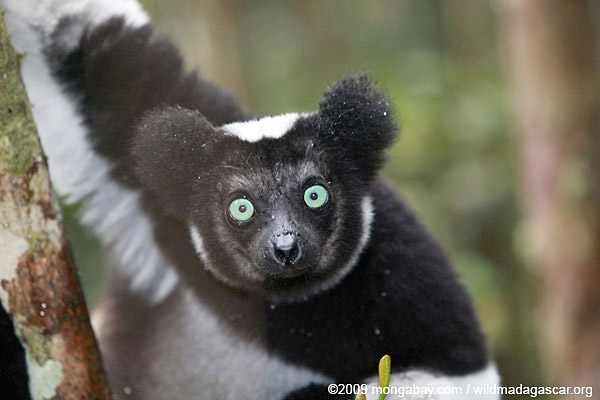 Could a website save the world’s lemurs? Indri lemur (Indri indri). Photo by: Rhett A. Butler. Last year, scientists released an emergency three-year plan that they argued could, quite literally, save the world’s lemurs from mass extinction. Costing just $7.6 million, the plan focused on setting up better protections and conservation programs in 30 lemur […]
Could a website save the world’s lemurs? Indri lemur (Indri indri). Photo by: Rhett A. Butler. Last year, scientists released an emergency three-year plan that they argued could, quite literally, save the world’s lemurs from mass extinction. Costing just $7.6 million, the plan focused on setting up better protections and conservation programs in 30 lemur […]
25 primate pictures for World Primate Day
 Coquerel’s Sifaka (Propithecus coquereli) September 1 is World Primate Day, a designation intended to raise awareness about apes, monkeys, and prosimians like lemurs, lorises, and tarsiers. Many non-human primates are threatened by habitat loss, the pet trade, and hunting. There are more than 440 species of primate worldwide, the majority of which live in the […]
Coquerel’s Sifaka (Propithecus coquereli) September 1 is World Primate Day, a designation intended to raise awareness about apes, monkeys, and prosimians like lemurs, lorises, and tarsiers. Many non-human primates are threatened by habitat loss, the pet trade, and hunting. There are more than 440 species of primate worldwide, the majority of which live in the […]
Next big idea in forest conservation? Rewards for reforestation
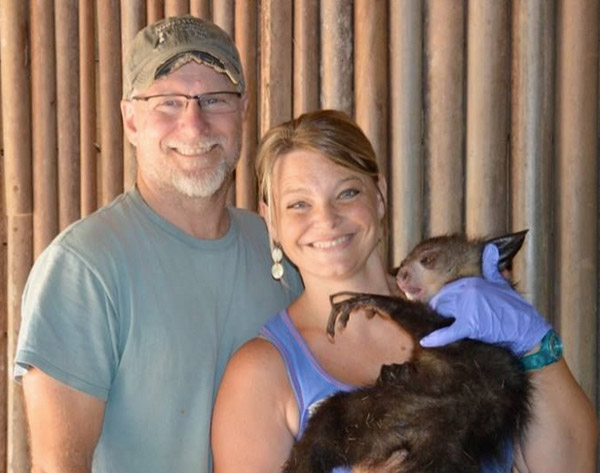 Innovation in Tropical Forest Conservation: Q&A with Susie McGuire and Dr. Ed Louis Jr. Ed Louis (left) and Susie McGuire (right) with aye-aye. Photo courtesy of the Madagascar Biodiversity Partnership and Conservation Fusion. Susie McGuire and Dr. Edward Louis Jr. are the powerhouse team behind the Madagascar Biodiversity Partnership (MBP), an NGO that involves local […]
Innovation in Tropical Forest Conservation: Q&A with Susie McGuire and Dr. Ed Louis Jr. Ed Louis (left) and Susie McGuire (right) with aye-aye. Photo courtesy of the Madagascar Biodiversity Partnership and Conservation Fusion. Susie McGuire and Dr. Edward Louis Jr. are the powerhouse team behind the Madagascar Biodiversity Partnership (MBP), an NGO that involves local […]
Over 800 species added to IUCN threatened list, including 44 lemurs
 The famous ring-tailed lemur (Lemur catta) is now listed as Endangered, one of 90 lemur species currently considered threatened with extinction. Photo by: Rhett A. Butler. Experts have added 817 species to the threatened categories of the IUCN Red List in the latest update. Those added include 51 mammals—mostly lemurs—and over 400 plants. The new […]
The famous ring-tailed lemur (Lemur catta) is now listed as Endangered, one of 90 lemur species currently considered threatened with extinction. Photo by: Rhett A. Butler. Experts have added 817 species to the threatened categories of the IUCN Red List in the latest update. Those added include 51 mammals—mostly lemurs—and over 400 plants. The new […]
Lemur expert becomes first woman to win top conservation prize
 Patricia Wright attends a cocktail reception at the Mission to the UN of Madagascar, May 15, 2014 in New York. INSIDER IMAGES/Gary He. Lemur expert Patricia C. Wright has become the first woman to win the prestigious Indianapolis Prize, an award granted every two years for achievement in wildlife conservation. Wright was selected among six […]
Patricia Wright attends a cocktail reception at the Mission to the UN of Madagascar, May 15, 2014 in New York. INSIDER IMAGES/Gary He. Lemur expert Patricia C. Wright has become the first woman to win the prestigious Indianapolis Prize, an award granted every two years for achievement in wildlife conservation. Wright was selected among six […]
Vazaha is Malagasy for ‘gringo’: Conservation, national identity, and conflicting interest in Madagascar
 Ring-talked lemur: the national animal symbol of Madagascar. Photo by: Rhett A. Butler. In the fight for conservation Madagascar is without a doubt on the front lines. Not only are most of its forests already destroyed—with a mere 10% of intact forest remaining at best—but there’s still much to lose in what remains. Madagascar is […]
Ring-talked lemur: the national animal symbol of Madagascar. Photo by: Rhett A. Butler. In the fight for conservation Madagascar is without a doubt on the front lines. Not only are most of its forests already destroyed—with a mere 10% of intact forest remaining at best—but there’s still much to lose in what remains. Madagascar is […]
Madagascar lemurs share spotlight with primatologist in new IMAX film
 Left to right – Soundtrack artist Hanitrarivo Rasoanaivo, director David Douglas, writer/producer Drew Fellman, narrator Morgan Freeman and Patricia C. Wright greet the gathered crowd outside the California Science Center IMAX Theater in Los Angeles on March 29, 2014. Tomorrow’s opening of the IMAX film Island of Lemurs: Madagascar showcases not only endangered primates, but […]
Left to right – Soundtrack artist Hanitrarivo Rasoanaivo, director David Douglas, writer/producer Drew Fellman, narrator Morgan Freeman and Patricia C. Wright greet the gathered crowd outside the California Science Center IMAX Theater in Los Angeles on March 29, 2014. Tomorrow’s opening of the IMAX film Island of Lemurs: Madagascar showcases not only endangered primates, but […]
Panda lemur making a comeback
 One of the world’s biggest populations of greater bamboo lemurs (Prolemur simus)—sometimes known as the panda lemur—has doubled in just three years, giving conservationists new hope that the species can be kept from extinction. With the recent arrival of twenty babies, a community conservation project run by the Aspinall Foundation has boosted the local population […]
One of the world’s biggest populations of greater bamboo lemurs (Prolemur simus)—sometimes known as the panda lemur—has doubled in just three years, giving conservationists new hope that the species can be kept from extinction. With the recent arrival of twenty babies, a community conservation project run by the Aspinall Foundation has boosted the local population […]
The lemur end-game: scientists propose ambitious plan to save the world’s most imperiled mammal family
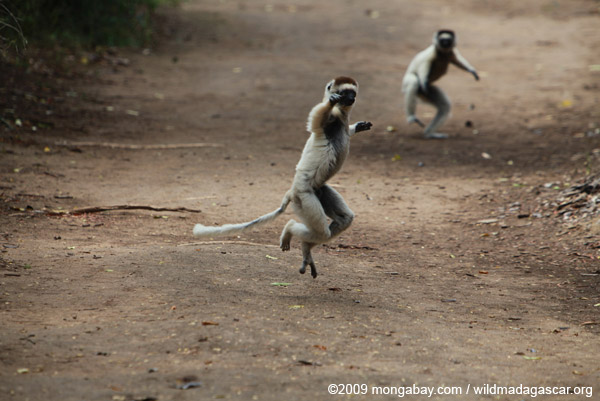 Verreaux’s Sifaka (Propithecus verreauxi), listed as Vulnerable, in a heated chase. Photo by: Rhett A. Butler. Due to the wonderful idiosyncrasies of evolution, there is one country on Earth that houses 20 percent of the world’s primates. More astounding still, every single one of these primates—an entire distinct family in fact—are found no-where else. The […]
Verreaux’s Sifaka (Propithecus verreauxi), listed as Vulnerable, in a heated chase. Photo by: Rhett A. Butler. Due to the wonderful idiosyncrasies of evolution, there is one country on Earth that houses 20 percent of the world’s primates. More astounding still, every single one of these primates—an entire distinct family in fact—are found no-where else. The […]
Madagascar’s most famous lemur facing big threats
 The ring-tailed lemur (Lemur catta), perhaps the most well-known of Madagascar’s endemic animals, is facing a “very high” risk of extinction in the wild. The Madagascar Section of the IUCN Primate Specialist Group reassessed the Red List status of ring-tailed lemurs and upgraded the species from Near-Threatened (2008) to Endangered (2012). Ring-tailed lemurs are facing […]
The ring-tailed lemur (Lemur catta), perhaps the most well-known of Madagascar’s endemic animals, is facing a “very high” risk of extinction in the wild. The Madagascar Section of the IUCN Primate Specialist Group reassessed the Red List status of ring-tailed lemurs and upgraded the species from Near-Threatened (2008) to Endangered (2012). Ring-tailed lemurs are facing […]
Like ancient humans, some lemurs slumber in caves
 Lemurs in a cave in Madagascar. Photo by Rhett A. Butler After playing, feeding, and socializing in trees all day, some ring-tailed lemurs (Lemur catta) take their nightly respite in caves, according to a new study in Madagascar Conservation and Development. The findings are important because this is the first time scientists have ever recorded […]
Lemurs in a cave in Madagascar. Photo by Rhett A. Butler After playing, feeding, and socializing in trees all day, some ring-tailed lemurs (Lemur catta) take their nightly respite in caves, according to a new study in Madagascar Conservation and Development. The findings are important because this is the first time scientists have ever recorded […]
The evolution of cooperation: communal nests are best for ruffed lemurs
 Raising young lemurs in communal crèches benefits both mothers and offspring, a new study has found. Andrea Baden and colleagues, of Yale University, studied a group of black-and-white ruffed lemurs (Varecia variegata) in Ranomafana National Park, Madagascar. This is the first study to examine the consequences of different parenting strategies in the ruffed lemur. By […]
Raising young lemurs in communal crèches benefits both mothers and offspring, a new study has found. Andrea Baden and colleagues, of Yale University, studied a group of black-and-white ruffed lemurs (Varecia variegata) in Ranomafana National Park, Madagascar. This is the first study to examine the consequences of different parenting strategies in the ruffed lemur. By […]
Scientists map plan to save lemurs
 Primatologists and researchers have devised a wide-ranging plan to protect Madagascar’s most endangered lemurs from extinction. The plan, produced by the IUCN/SSC Primate Specialist Group, aims to reverse declining population trends among lemurs, 94 percent of which are considered at risk of extinction due to habitat loss and hunting. Strategies outlined in the report including […]
Primatologists and researchers have devised a wide-ranging plan to protect Madagascar’s most endangered lemurs from extinction. The plan, produced by the IUCN/SSC Primate Specialist Group, aims to reverse declining population trends among lemurs, 94 percent of which are considered at risk of extinction due to habitat loss and hunting. Strategies outlined in the report including […]
Does size matter (for lemur smarts, that is)?
 Does size matter? When referring to primate brain size and its relation to social intelligence, scientists at Duke University do not think the answer is a simple yes or no. In the past, scientists have correlated large brain size to large group size. However, in a new study published in PLoS ONE, scientists at Duke […]
Does size matter? When referring to primate brain size and its relation to social intelligence, scientists at Duke University do not think the answer is a simple yes or no. In the past, scientists have correlated large brain size to large group size. However, in a new study published in PLoS ONE, scientists at Duke […]
Population of newly discovered lemur in Madagascar down to last 50 individuals (photo)
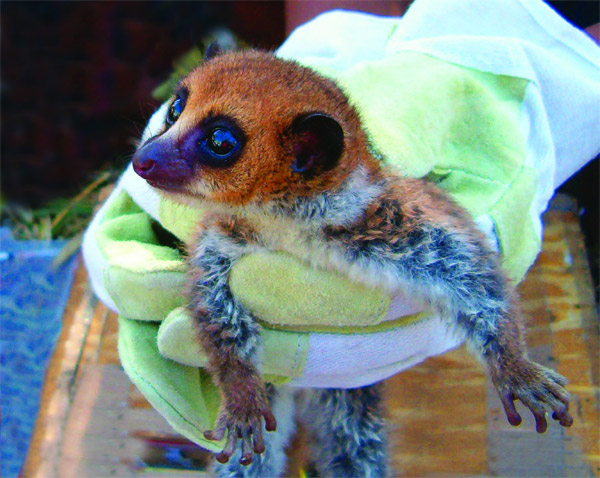 Researchers have discovered a new — and critically endangered — species of lemur on the island of Madagascar. The primate is formally described in the journal Molecular Phylogenetics and Evolution. The Lavasoa Dwarf Lemur (Cheirogaleus lavasoensis) inhabits three isolated forest fragments in the Lavasoa Mountains in southern Madagascar. Like other dwarf lemurs, the species is […]
Researchers have discovered a new — and critically endangered — species of lemur on the island of Madagascar. The primate is formally described in the journal Molecular Phylogenetics and Evolution. The Lavasoa Dwarf Lemur (Cheirogaleus lavasoensis) inhabits three isolated forest fragments in the Lavasoa Mountains in southern Madagascar. Like other dwarf lemurs, the species is […]
Madagascar occupied by humans 2,500 years earlier than previously thought
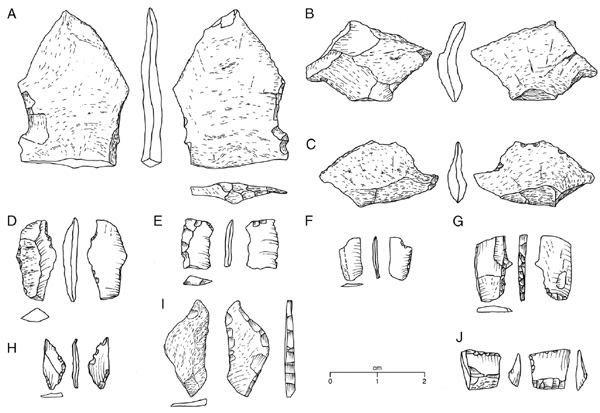 Madagascar’s first people may not have driven the island’s largest animals to extinction, suggests new study. New research indicates that Madagascar was occupied some 2,500 years earlier than previously established. The findings, published in Proceedings of the National Academy of Sciences, suggests a more complex view of the human role in the extinction of the […]
Madagascar’s first people may not have driven the island’s largest animals to extinction, suggests new study. New research indicates that Madagascar was occupied some 2,500 years earlier than previously established. The findings, published in Proceedings of the National Academy of Sciences, suggests a more complex view of the human role in the extinction of the […]
To protect themselves, lemurs learn alarm calls of other species
 Solitary lemurs in Madagascar rely on the alarm calls of birds and more social lemurs to evade predators, reports a study published in PLoS ONE. Researchers from Bristol University, Bristol Zoo and Torino University documented the response of the little-known nocturnal Sahamalaza sportive lemur (Lepilemur sahamalazensis) to the alarm calls of various animals that share […]
Solitary lemurs in Madagascar rely on the alarm calls of birds and more social lemurs to evade predators, reports a study published in PLoS ONE. Researchers from Bristol University, Bristol Zoo and Torino University documented the response of the little-known nocturnal Sahamalaza sportive lemur (Lepilemur sahamalazensis) to the alarm calls of various animals that share […]
Lemur has unexpectedly wide range, diversity of color variations
 An endangered lemur has a larger range than originally believed but is still at risk due to forest fragmentation and land clearing, reports a study published in the journal Primate Conservation. The study, conducted by researchers at The Aspinall Foundation and the Groupe d’Etude et de Recherche sur les Primates de Madagascar (GERP) in Antananarivo, […]
An endangered lemur has a larger range than originally believed but is still at risk due to forest fragmentation and land clearing, reports a study published in the journal Primate Conservation. The study, conducted by researchers at The Aspinall Foundation and the Groupe d’Etude et de Recherche sur les Primates de Madagascar (GERP) in Antananarivo, […]
Hibernating primates: scientists discover three lemur species sleep like bears
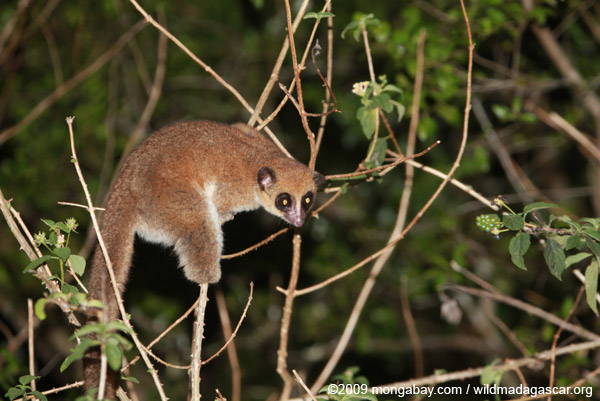 Bears do it, bats do it, and now we know lemurs do it too: hibernate, that is. Since 2005, scientists have known that the western fat-tailed dwarf lemur hibernates, but a new study in Scientific Reports finds that hibernation is more widespread among lemurs than expected. At least two additional lemur species—Crossley’s dwarf lemur and […]
Bears do it, bats do it, and now we know lemurs do it too: hibernate, that is. Since 2005, scientists have known that the western fat-tailed dwarf lemur hibernates, but a new study in Scientific Reports finds that hibernation is more widespread among lemurs than expected. At least two additional lemur species—Crossley’s dwarf lemur and […]
Featured video: in-depth look at Madagascar’s Ranomafauna National Park
 A new film Nosy Maitso takes a look at the people, researchers, and wildlife connected to Madagascar’s Ranomafauna National Park. Apart of a World Heritage Site, the park was established in 1991 after a new species of lemur, the golden bamboo lemur (Hapalemur aureus), was discovered in its forests in the 1980s. The golden bamboo […]
A new film Nosy Maitso takes a look at the people, researchers, and wildlife connected to Madagascar’s Ranomafauna National Park. Apart of a World Heritage Site, the park was established in 1991 after a new species of lemur, the golden bamboo lemur (Hapalemur aureus), was discovered in its forests in the 1980s. The golden bamboo […]
2 ‘giant’ yet tiny mouse lemurs identified in Madagascar
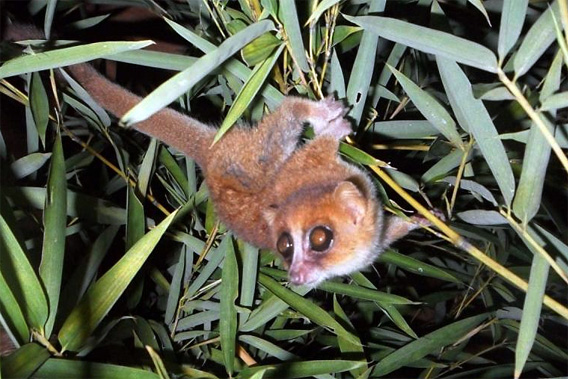 Scientists have discovered two new species of mouse lemurs in Madagascar, bringing the total number of diminutive primates known to science to 20, according to a paper published in the latest issue of the International Journal of Primatology. The lemurs were collected in 2003 and 2007 during field surveys to the eastern part of the […]
Scientists have discovered two new species of mouse lemurs in Madagascar, bringing the total number of diminutive primates known to science to 20, according to a paper published in the latest issue of the International Journal of Primatology. The lemurs were collected in 2003 and 2007 during field surveys to the eastern part of the […]
Researchers sequence Aye-aye genome – lemur is more genetically diverse than humans
 Scientists sequenced the genome of the aye-aye, a bizarre lemur species, for the first time. The research is published in the journal Proceedings of the National Academy of Sciences (PNAS). The researcher collected samples from aye-ayes in three distinct regions of regions of Madagascar: the northern, eastern and western zones. They then compared the results, […]
Scientists sequenced the genome of the aye-aye, a bizarre lemur species, for the first time. The research is published in the journal Proceedings of the National Academy of Sciences (PNAS). The researcher collected samples from aye-ayes in three distinct regions of regions of Madagascar: the northern, eastern and western zones. They then compared the results, […]
Travel in Madagascar: strange wildlife and stunning landscapes

UK authorizes guns for Madagascar despite threat of lemur extinctions
 Red-ruffed lemur, a commonly hunted but critically endangered lemur species. Photo by Rhett A. Butler Britain has authorized the export of thousands of guns to Madagascar, according to TanaNews.com, sparking concerns that the firearms could be used for hunting endangered lemurs. Data from the UK government’s Strategic Export Controls website shows that licenses for the […]
Red-ruffed lemur, a commonly hunted but critically endangered lemur species. Photo by Rhett A. Butler Britain has authorized the export of thousands of guns to Madagascar, according to TanaNews.com, sparking concerns that the firearms could be used for hunting endangered lemurs. Data from the UK government’s Strategic Export Controls website shows that licenses for the […]
Replacing lemur meat with insect protein in Madagascar
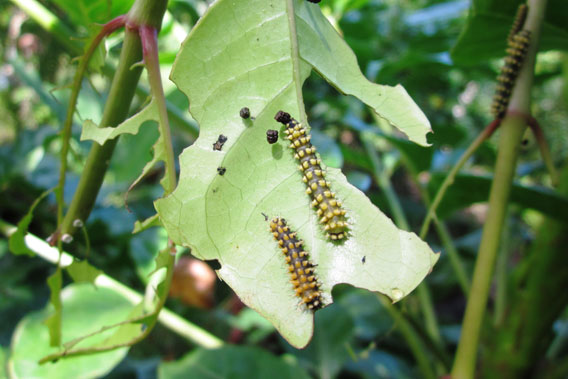 Moth larvae munching on a host plant. Photo by: Tom Corcoran. Poaching is a major threat to endangered lemurs in some parts of Madagascar, but a group has come up with an innovative solution to the problem: replace lemur meat with silkworm pupae, a byproduct of silk production. The Pupae for Protein (P4P) program, developed […]
Moth larvae munching on a host plant. Photo by: Tom Corcoran. Poaching is a major threat to endangered lemurs in some parts of Madagascar, but a group has come up with an innovative solution to the problem: replace lemur meat with silkworm pupae, a byproduct of silk production. The Pupae for Protein (P4P) program, developed […]
Despite small brains, gray mouse lemurs use calls to avoid inbreeding
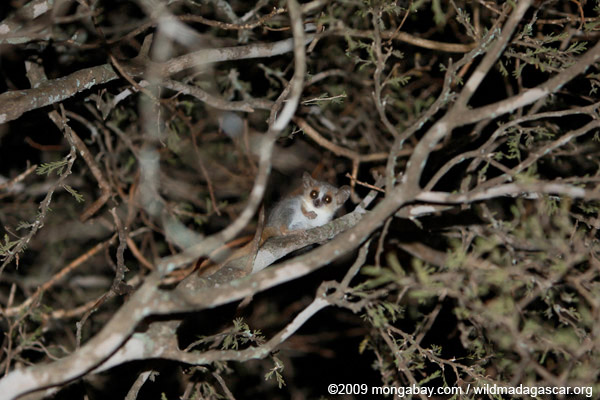 Gray mouse lemur in Madagascar. Photo by: Rhett A. Butler. As a small-brained and largely solitary primate, the gray mouse lemur (Microcebus murinus) wasn’t supposed to have the capacity to distinguish the calls of its kin calls from other lemurs. However, a new open-access study in BMC Ecology, finds that a female gray mouse lemur […]
Gray mouse lemur in Madagascar. Photo by: Rhett A. Butler. As a small-brained and largely solitary primate, the gray mouse lemur (Microcebus murinus) wasn’t supposed to have the capacity to distinguish the calls of its kin calls from other lemurs. However, a new open-access study in BMC Ecology, finds that a female gray mouse lemur […]
Greater bamboo lemur removed from ‘most endangered primates’ list
 Madagascar’s greater bamboo lemur has been removed from the list of the world’s 25 most endangered primates after conservationists discovered previously unknown populations of the rare creature, according to the Aspinall Foundation, a charity that set in motion a species survival plan for the lemur. Thought to be extinct as recently as the 1970s, scientific […]
Madagascar’s greater bamboo lemur has been removed from the list of the world’s 25 most endangered primates after conservationists discovered previously unknown populations of the rare creature, according to the Aspinall Foundation, a charity that set in motion a species survival plan for the lemur. Thought to be extinct as recently as the 1970s, scientific […]
Madagascar gets biggest protected area
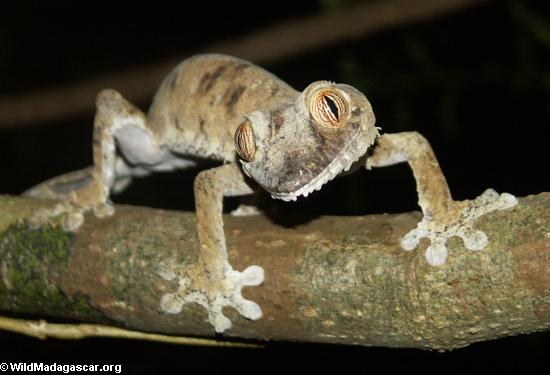 Leaf-tailed gecko in Madagascar. Photo by Rhett A. Butler Madagascar officially designated its largest protected area in a region renowned for its tropical rainforests and rich diversity of wildlife, including 20 species of lemurs, reports the Wildlife Conservation Society (WCS), a group that was instrumental in establishing the park. Makira Natural Park covers some 372,470 […]
Leaf-tailed gecko in Madagascar. Photo by Rhett A. Butler Madagascar officially designated its largest protected area in a region renowned for its tropical rainforests and rich diversity of wildlife, including 20 species of lemurs, reports the Wildlife Conservation Society (WCS), a group that was instrumental in establishing the park. Makira Natural Park covers some 372,470 […]
Past climate change reduced lemur population in Madagascar
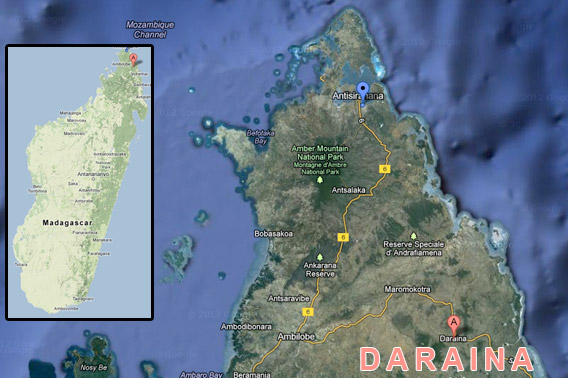 Climate threat to lemurs Daraina region in Madagascar. Background image from Google Earth. Climate change that took place 4,000-10,000 years ago may have contributed to the endangered status of one of Madagascar’s rarest lemurs by reducing the extent of its habitat, argues a new study published in the journal Proceedings of the Natural Academy of […]
Climate threat to lemurs Daraina region in Madagascar. Background image from Google Earth. Climate change that took place 4,000-10,000 years ago may have contributed to the endangered status of one of Madagascar’s rarest lemurs by reducing the extent of its habitat, argues a new study published in the journal Proceedings of the Natural Academy of […]
Cute animal picture of the day: baby bamboo lemur
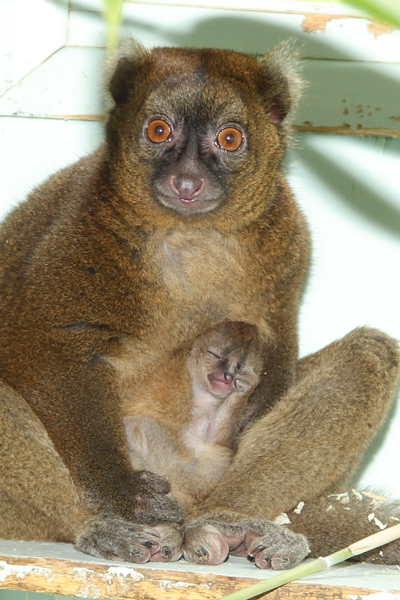 A newborn greater bamboo lemur baby at the Port Lympne Wild Animal Park. Photo by: Dave Rolfe. Greater bamboo lemurs (Prolemur simus) are one of over a hundred lemur species found only on the island of Madagascar. Listed as Critically Endangered, there are only around 150 individuals known in the wild, making them one of […]
A newborn greater bamboo lemur baby at the Port Lympne Wild Animal Park. Photo by: Dave Rolfe. Greater bamboo lemurs (Prolemur simus) are one of over a hundred lemur species found only on the island of Madagascar. Listed as Critically Endangered, there are only around 150 individuals known in the wild, making them one of […]
91% of Madagascar’s lemurs threatened with extinction
 Coquerel’s sifakas kissing. Photo by Rhett A. Butler 94 of the world’s 103 lemur species are at risk of extinction according to a new assessment by the International Union for Conservation of Nature (IUCN) released by the group’s Species Survival Commission during a workshop this week. Lemurs, a group of primates that is endemic to […]
Coquerel’s sifakas kissing. Photo by Rhett A. Butler 94 of the world’s 103 lemur species are at risk of extinction according to a new assessment by the International Union for Conservation of Nature (IUCN) released by the group’s Species Survival Commission during a workshop this week. Lemurs, a group of primates that is endemic to […]
Cutting-edge research center opens in Madagascar rainforest
 Mockup of the NamanaBe Hall. A high-tech research center opened today on the edge of a rainforest in Madagascar. The facility, known as the Centre Valbio, will support efforts to study Madagascar’s unique wildlife, deliver health care to impoverished communities, and understand links between the environment and the rural economy. The project was led by […]
Mockup of the NamanaBe Hall. A high-tech research center opened today on the edge of a rainforest in Madagascar. The facility, known as the Centre Valbio, will support efforts to study Madagascar’s unique wildlife, deliver health care to impoverished communities, and understand links between the environment and the rural economy. The project was led by […]
Picture: baby black lemur born at Howletts Wild Animal Park
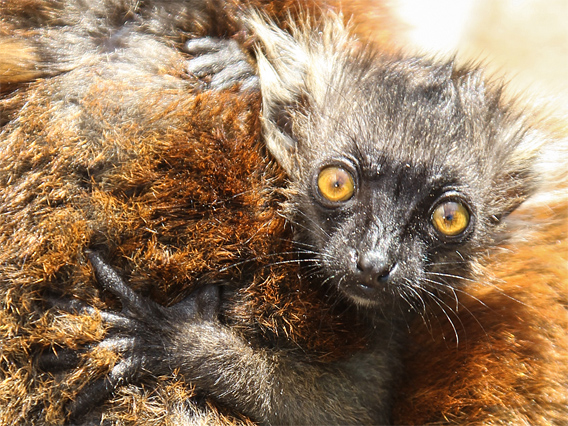 Baby black lemur. Picture by Dave Rolfe. Howletts Wild Animal Park in near Canterbury in Britain released photos of an infant black lemur born recently. The facility is holding a naming poll for the baby lemur at www.facebook.com/howletts. The poll opens July 4. Black lemurs are found only in the wild on the island of […]
Baby black lemur. Picture by Dave Rolfe. Howletts Wild Animal Park in near Canterbury in Britain released photos of an infant black lemur born recently. The facility is holding a naming poll for the baby lemur at www.facebook.com/howletts. The poll opens July 4. Black lemurs are found only in the wild on the island of […]
Photos: Mama lemurs with babies
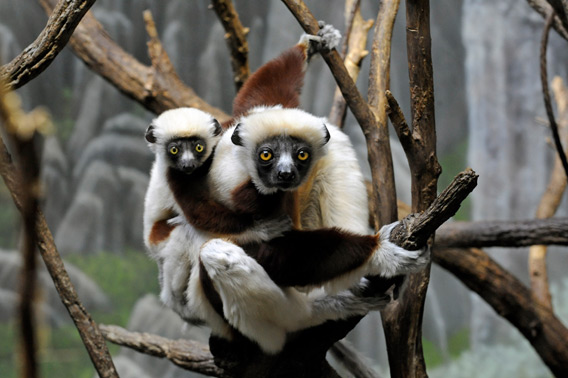 Coquerel’s Sifaka and Baby. Photo by Julie Larsen Maher © WCS Two baby lemurs were put on display this week in the Madagascar! exhibit at the Wildlife Conservation Society’s Bronx Zoo. The two baby lemurs are a Coquerel’s sifaka and a collared lemur. Both were born this year at the zoo. Like all lemurs, Coquerel’s […]
Coquerel’s Sifaka and Baby. Photo by Julie Larsen Maher © WCS Two baby lemurs were put on display this week in the Madagascar! exhibit at the Wildlife Conservation Society’s Bronx Zoo. The two baby lemurs are a Coquerel’s sifaka and a collared lemur. Both were born this year at the zoo. Like all lemurs, Coquerel’s […]
Picture: Shaq poses with tiny lemur
 Shaq with a mouse lemur. Photo courtesy of Mireya Mayor. One of the world’s most recognizable professional basketball players has used his stature to highlight one of the world’s smallest primates: the mouse lemur from Madagascar. Shaquille O’Neal, a NBA legend who retired last year and earned a doctorate degree in education from Barry University […]
Shaq with a mouse lemur. Photo courtesy of Mireya Mayor. One of the world’s most recognizable professional basketball players has used his stature to highlight one of the world’s smallest primates: the mouse lemur from Madagascar. Shaquille O’Neal, a NBA legend who retired last year and earned a doctorate degree in education from Barry University […]
Innovative conservation: wild silk, endangered species, and poverty in Madagascar
 Moth larvae munching on a host plant. Photo by: Tom Corcoran. For anyone who works in conservation in Madagascar, confronting the complex difficulties of widespread poverty is a part of the job. But with the wealth of Madagascar’s wildlife rapidly diminishing— such as lemurs, miniature chameleons, and hedgehog-looking tenrecs found no-where else in the world—the […]
Moth larvae munching on a host plant. Photo by: Tom Corcoran. For anyone who works in conservation in Madagascar, confronting the complex difficulties of widespread poverty is a part of the job. But with the wealth of Madagascar’s wildlife rapidly diminishing— such as lemurs, miniature chameleons, and hedgehog-looking tenrecs found no-where else in the world—the […]
How lemurs fight climate change
 An interview with Kara Moses, a part of our on-going Interviews with Young Scientists series. Kara Moses with the ruffed lemurs at Dudley Zoo, conducting undergraduate research. Kara Moses may have never become a biologist if not for a coin toss. The coin, which came up heads and decided Moses’ direction in college, has led […]
An interview with Kara Moses, a part of our on-going Interviews with Young Scientists series. Kara Moses with the ruffed lemurs at Dudley Zoo, conducting undergraduate research. Kara Moses may have never become a biologist if not for a coin toss. The coin, which came up heads and decided Moses’ direction in college, has led […]
Photo: Tiny lemur discovered in Madagascar forest
 A new species of mouse lemur has been discovered in eastern Madagascar, report researchers from Germany. The species is described in a recent issue of the journal Primates. The diminutive primate is named Gerp’s mouse lemur (Microcebus gerpi) after a GERP (Groupe d’Étude et de Recherche sur les Primates de Madagascar), a local lemur research […]
A new species of mouse lemur has been discovered in eastern Madagascar, report researchers from Germany. The species is described in a recent issue of the journal Primates. The diminutive primate is named Gerp’s mouse lemur (Microcebus gerpi) after a GERP (Groupe d’Étude et de Recherche sur les Primates de Madagascar), a local lemur research […]
Cultural shifts in Madagascar drive lemur-killing
 The indri lemur is one of the most commonly hunted for bushmeat, though it is listed as Endangered. Photo by: Rhett A. Butler . Conservationists have often found that some cultural norms, religious beliefs, and taboos play a role in holding back traditional peoples from overusing their environment. Examples of such beliefs include days wherein […]
The indri lemur is one of the most commonly hunted for bushmeat, though it is listed as Endangered. Photo by: Rhett A. Butler . Conservationists have often found that some cultural norms, religious beliefs, and taboos play a role in holding back traditional peoples from overusing their environment. Examples of such beliefs include days wherein […]
Forgoing bushmeat hunting has health toll in Madagascar, says study
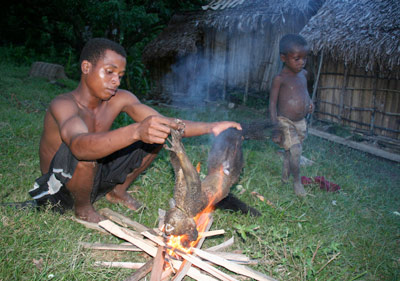 Conservationists shouldn’t overlook the detrimental health impacts of shifting local populations away from subsistence bushmeat hunting, says a new study. The paper, published in Proceedings of the National Academy of Sciences looked at the nutritional benefits of bushmeat consumption in the Makira Protected Areas in northern Madagascar. It found that wildlife is an important source […]
Conservationists shouldn’t overlook the detrimental health impacts of shifting local populations away from subsistence bushmeat hunting, says a new study. The paper, published in Proceedings of the National Academy of Sciences looked at the nutritional benefits of bushmeat consumption in the Makira Protected Areas in northern Madagascar. It found that wildlife is an important source […]
Critically Endangered lemurs disperse seeds, store carbon
 Black-and-white ruffed lemur (Varecia variegata) feeding on a tamarind. Photo by: Rhett A. Butler. Many tropical plants depend on other species to carry their progeny far-and-wide. Scientists are just beginning to unravel this phenomenon, known as seed dispersal, which is instrumental in supporting the diversity and richness of tropical forests. Researchers have identified a number […]
Black-and-white ruffed lemur (Varecia variegata) feeding on a tamarind. Photo by: Rhett A. Butler. Many tropical plants depend on other species to carry their progeny far-and-wide. Scientists are just beginning to unravel this phenomenon, known as seed dispersal, which is instrumental in supporting the diversity and richness of tropical forests. Researchers have identified a number […]
Animal picture of the day: crowned lemur and baby
 Female crowned lemur tackling a mango in Madagascar’s Tsingy stone forest. Photo by: Rhett A. Butler. Like all of the world’s hundred-plus lemur species, the crowned lemur (Eulemur coronatus) is only found on the island of Madagascar. They inhabit the northern tip of the island. Named for a yellowish crown on their head, this species […]
Female crowned lemur tackling a mango in Madagascar’s Tsingy stone forest. Photo by: Rhett A. Butler. Like all of the world’s hundred-plus lemur species, the crowned lemur (Eulemur coronatus) is only found on the island of Madagascar. They inhabit the northern tip of the island. Named for a yellowish crown on their head, this species […]
Tea Party rallies in favor of Gibson Guitar, ignores reasons instrument-maker is under investigation
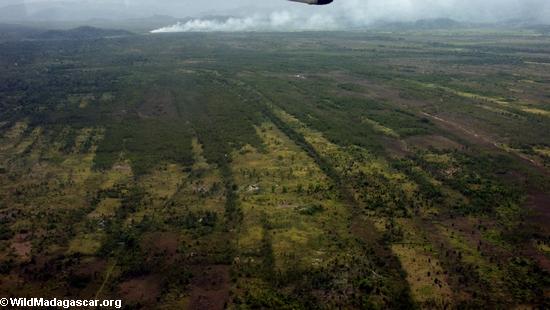 Deforested area in Madagascar in the western watershed of the Bay of Antongil. Photo by: Rhett A. Butler. This weekend around 500 people showed up for a rally and concert in Nashville, Tennessee. The rally was in support of Gibson Guitars, a US-company currently under investigation for allegedly importing illegally logged wood into the country, […]
Deforested area in Madagascar in the western watershed of the Bay of Antongil. Photo by: Rhett A. Butler. This weekend around 500 people showed up for a rally and concert in Nashville, Tennessee. The rally was in support of Gibson Guitars, a US-company currently under investigation for allegedly importing illegally logged wood into the country, […]
Animal picture of the day: ninja lemurs
 Two Verreaux’s Sifaka (Propithecus verreauxi) in a heated chase in Madagascar. Photo by: Rhett A. Butler. One the ground Verreaux’s Sifaka (Propithecus verreauxi) move in sideways jumps giving them the appearance of elegant dancers or dangerous ninjas. Verreaux’s Sifaka live in groups and are active during the day, consuming a variety of vegetation from to […]
Two Verreaux’s Sifaka (Propithecus verreauxi) in a heated chase in Madagascar. Photo by: Rhett A. Butler. One the ground Verreaux’s Sifaka (Propithecus verreauxi) move in sideways jumps giving them the appearance of elegant dancers or dangerous ninjas. Verreaux’s Sifaka live in groups and are active during the day, consuming a variety of vegetation from to […]
Featured video: Trouble in Lemur Land
A new film, Trouble in Lemur Land, showcases the Critically Endangered silky sifaka (Propithecus candidus). With only 300-2,000 silky sifaka’s surviving in the wild, this large and distinct lemur is considered one of the top 25 most endangered primates in the world. Primatologist, Erik Patel told mongabay.com that the film took months of filming in […]
Richard Branson’s pet lemur project won’t help save wildlife in Madagascar
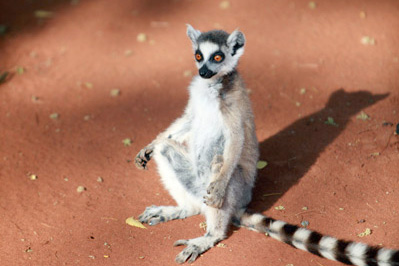 Richard Branson’s plan to introduce lemurs on one of his private islands in the Caribbean is a terrible idea if his aim is really to protect the primates from extinction. Beyond the much-discussed ecological impact of bringing in non-native primates, Branson’s scheme risks undermining conservation efforts where lemurs actually exist in the wild: Madagascar. As […]
Richard Branson’s plan to introduce lemurs on one of his private islands in the Caribbean is a terrible idea if his aim is really to protect the primates from extinction. Beyond the much-discussed ecological impact of bringing in non-native primates, Branson’s scheme risks undermining conservation efforts where lemurs actually exist in the wild: Madagascar. As […]
Saving Madagascar’s largest carnivorous mammal: the fossa
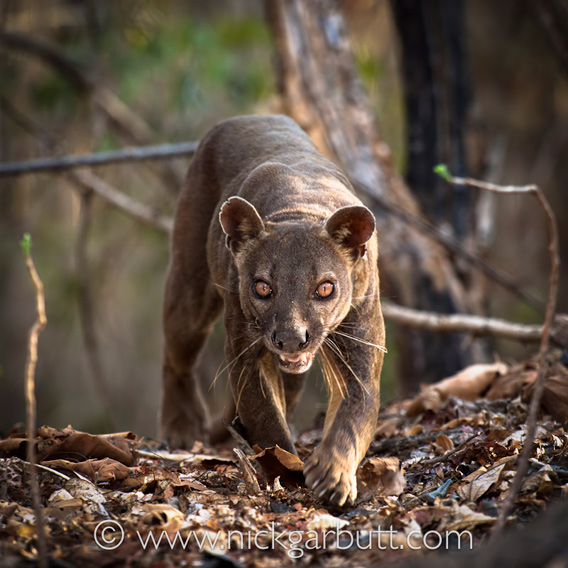 The fossa. Photo © Nick Garbutt . An interview with Mia-Lana Lührs, a part of our Interviews with Young Scientists series. Madagascar is a land of wonders: dancing lemurs, thumbnail-sized chameleons, the long-fingered aye-aye, great baobab trees, and the mighty fossa. Wait—what? What’s a fossa? It’s true that when people think of Madagascar rarely do […]
The fossa. Photo © Nick Garbutt . An interview with Mia-Lana Lührs, a part of our Interviews with Young Scientists series. Madagascar is a land of wonders: dancing lemurs, thumbnail-sized chameleons, the long-fingered aye-aye, great baobab trees, and the mighty fossa. Wait—what? What’s a fossa? It’s true that when people think of Madagascar rarely do […]
New hope for rare lemurs in Madagascar
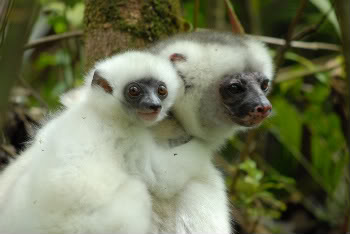 A survey of a remote forest area in Madagascar turned up seven new groups of silky sifaka, a critically endangered lemur threatened by habitat destruction. The finding raises hope that the species—which is listed as one of the world’s 25 most endangered primates—is surviving in Marojejy National Park despite an outbreak of illegal rosewood logging […]
A survey of a remote forest area in Madagascar turned up seven new groups of silky sifaka, a critically endangered lemur threatened by habitat destruction. The finding raises hope that the species—which is listed as one of the world’s 25 most endangered primates—is surviving in Marojejy National Park despite an outbreak of illegal rosewood logging […]
Lemur poaching continues in Madagascar [warning: graphic pictures]
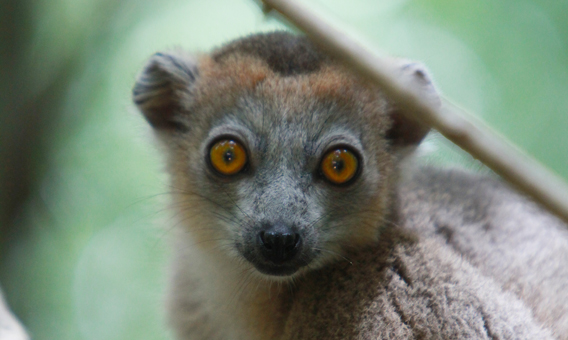 Crowned lemur in Ankarana, Madagascar. Photo by Rhett A. Butler 2009. A lemur poacher was intercepted with 32 dead lemurs on New Year’s Eve in Madagascar’s northeastern town of Vohemar, suggesting that killing of lemurs for the commercial bushmeat trade continues on the island nation, reports Fanamby, a Madagascar-based conservation group. The poacher, whose name […]
Crowned lemur in Ankarana, Madagascar. Photo by Rhett A. Butler 2009. A lemur poacher was intercepted with 32 dead lemurs on New Year’s Eve in Madagascar’s northeastern town of Vohemar, suggesting that killing of lemurs for the commercial bushmeat trade continues on the island nation, reports Fanamby, a Madagascar-based conservation group. The poacher, whose name […]
Lemur milestone: captive-born female successfully breeds with wild male
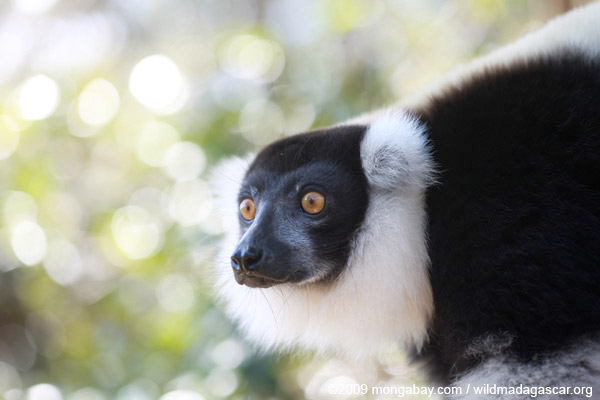 Authors note: although reported on in 2011, the lemur breeding as described below occurred in 2001. After years of releasing captive-born lemurs into the wild, the Madagascar Fauna Group (MFG) has finally succeeded in breeding a captive-born black-and-white ruffed lemur female with a wild male, a pairing that in October 2001 produced twins in Betampona […]
Authors note: although reported on in 2011, the lemur breeding as described below occurred in 2001. After years of releasing captive-born lemurs into the wild, the Madagascar Fauna Group (MFG) has finally succeeded in breeding a captive-born black-and-white ruffed lemur female with a wild male, a pairing that in October 2001 produced twins in Betampona […]
Picture: New lemur in Madagascar
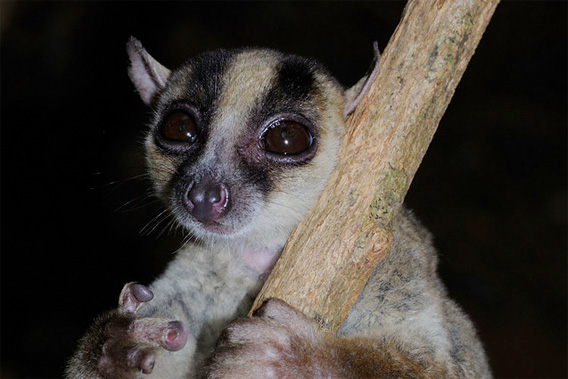 Close-up of a potentially new species of fork-marked lemur discovered in Madagascar, October 3, 2010. © Conservation International/ photo by Russell A. Mittermeier Researchers have discovered a new species of lemur in Madagascar. The squirrel-sized beast is a type of fork-marked lemur, a nocturnal species that feeds on nectar and bark. It belongs to the […]
Close-up of a potentially new species of fork-marked lemur discovered in Madagascar, October 3, 2010. © Conservation International/ photo by Russell A. Mittermeier Researchers have discovered a new species of lemur in Madagascar. The squirrel-sized beast is a type of fork-marked lemur, a nocturnal species that feeds on nectar and bark. It belongs to the […]
Photos: wild, weird, and rare mammals storm the conservation world
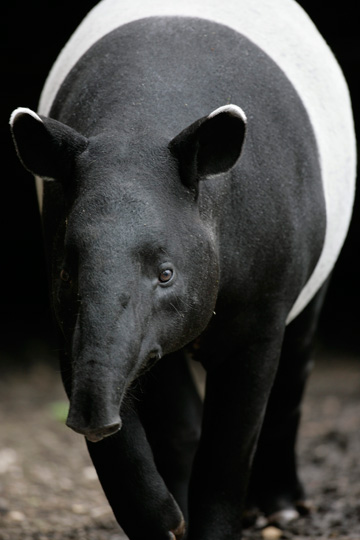 The conservation program, EDGE, takes a second look at the world’s unique and threatened mammals. What do the New Zealand greater short-tailed bat, the black-and-white ruffed lemur, and the numbat have in common? They are all new members of the Zoological Society of London’s EDGE’s top 100 most endangered and unique mammals list. Arguably the […]
The conservation program, EDGE, takes a second look at the world’s unique and threatened mammals. What do the New Zealand greater short-tailed bat, the black-and-white ruffed lemur, and the numbat have in common? They are all new members of the Zoological Society of London’s EDGE’s top 100 most endangered and unique mammals list. Arguably the […]
Extensive logging, lemur hunting in Madagascar national park despite moratorium
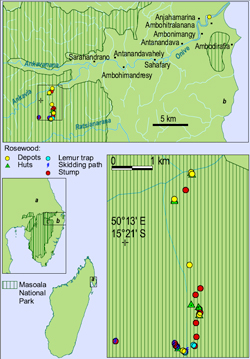 French version A biological survey in Northeastern Madagascar has turned up evidence of extensive logging in Masoala National Park, a UNESCO World Heritage Site renowned for its biologically-rich rainforest. The findings suggest that harvesting of valuable hardwoods—including rosewood, ebony, and palissander—continues despite an official ban on the logging and export of timber. A team of […]
French version A biological survey in Northeastern Madagascar has turned up evidence of extensive logging in Masoala National Park, a UNESCO World Heritage Site renowned for its biologically-rich rainforest. The findings suggest that harvesting of valuable hardwoods—including rosewood, ebony, and palissander—continues despite an official ban on the logging and export of timber. A team of […]
The $1M bed: why Madagascar’s rainforests are being destroyed
 Consumer demand for rosewood furniture and musical instruments is driving illegal logging in Madagascar’s national parks, endangering wildlife and undermining local community livelihoods, according to a new report from the Environmental Investigation Agency (EIA) and Global Witness. The report, based on more than a year of investigations, shows that Madagascar’s valuable hardwoods—including ebony, pallisander, and […]
Consumer demand for rosewood furniture and musical instruments is driving illegal logging in Madagascar’s national parks, endangering wildlife and undermining local community livelihoods, according to a new report from the Environmental Investigation Agency (EIA) and Global Witness. The report, based on more than a year of investigations, shows that Madagascar’s valuable hardwoods—including ebony, pallisander, and […]
Police in eastern Madagascar arrest foreign journalist investigating illegal timber trafficking
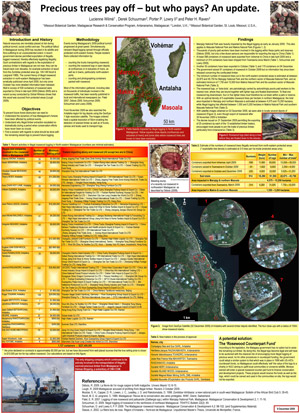 Authorities in eastern Madagascar arrested a foreign journalist investigating illegal rosewood trafficking. The arrest, which took place twelve days ago, comes as the central government claims to be cracking down on the illicit rosewood trade. The journalist, whose name and nationality is being withheld to protect his identity, had his camera equipment confiscated by the […]
Authorities in eastern Madagascar arrested a foreign journalist investigating illegal rosewood trafficking. The arrest, which took place twelve days ago, comes as the central government claims to be cracking down on the illicit rosewood trade. The journalist, whose name and nationality is being withheld to protect his identity, had his camera equipment confiscated by the […]
Logging crisis pushes Madagascar’s forests on to UNESCO’s Danger List
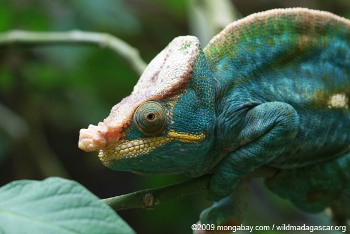 UNESCO’s World Heritage committee has added Madagascar’s unique tropical forests to its Danger List of threatened ecosystems. The move comes following a drawn-out illegal logging crisis that has seen loggers and traders infiltrating the island-nation’s national parks for rosewood. Bushmeat hunting of lemurs and other rare species also accompanied the crisis. “In adding this site […]
UNESCO’s World Heritage committee has added Madagascar’s unique tropical forests to its Danger List of threatened ecosystems. The move comes following a drawn-out illegal logging crisis that has seen loggers and traders infiltrating the island-nation’s national parks for rosewood. Bushmeat hunting of lemurs and other rare species also accompanied the crisis. “In adding this site […]
Already on the edge, lemurs could become victims of climate change
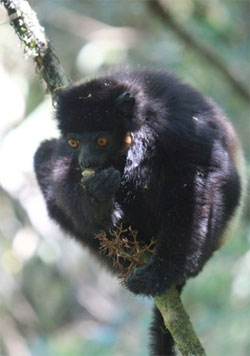 Expanding beyond well-known victims such as polar bears and coral reefs, the list is growing of species likely to be hard hit by climate change: from lizards to birds to amphibians. Now a new study has uncovered another group of species vulnerable to a warmer world: lemurs. New research in Global Change Biology finds that […]
Expanding beyond well-known victims such as polar bears and coral reefs, the list is growing of species likely to be hard hit by climate change: from lizards to birds to amphibians. Now a new study has uncovered another group of species vulnerable to a warmer world: lemurs. New research in Global Change Biology finds that […]
Researchers: Madagascar rosewoods deserve CITES protection
 A new policy paper in Science warns that several species of Madagascar’s rosewood could be pushed to extinction due to a current illegal logging crisis on the island. These hardwood species should be considered for protection under Convention of International Trade in Endangered Species of Wild Fauna and Flora (CITES), the researchers conclude. “Forty-seven of […]
A new policy paper in Science warns that several species of Madagascar’s rosewood could be pushed to extinction due to a current illegal logging crisis on the island. These hardwood species should be considered for protection under Convention of International Trade in Endangered Species of Wild Fauna and Flora (CITES), the researchers conclude. “Forty-seven of […]
Video: Madagascar could become “Haiti-like”
 Niall O’Connor from the World Wildlife Fund warns in a Carte Blanche production that if the ecological destruction of Madagascar continues, the poor island country could become “Haiti-like”, where he says, “most of the biodiversity, most of the forests are gone”. Carte Blanche, an African investigative journalism show, went to Madagascar to look into the […]
Niall O’Connor from the World Wildlife Fund warns in a Carte Blanche production that if the ecological destruction of Madagascar continues, the poor island country could become “Haiti-like”, where he says, “most of the biodiversity, most of the forests are gone”. Carte Blanche, an African investigative journalism show, went to Madagascar to look into the […]
Photo: Lemur species rediscovered after 100 years
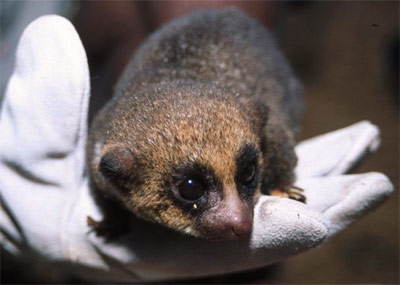 A species of lemur has been rediscovered more than a century after it was last spotted, report researchers from McGill University, the German Primate Centre in Göttingen Germany, the University of Antananarivo in Madagascar, and the University of Massachusetts. Sibree’s Dwarf Lemur was first described in 1896 but never studied during the 20th century. Over […]
A species of lemur has been rediscovered more than a century after it was last spotted, report researchers from McGill University, the German Primate Centre in Göttingen Germany, the University of Antananarivo in Madagascar, and the University of Massachusetts. Sibree’s Dwarf Lemur was first described in 1896 but never studied during the 20th century. Over […]
Photo: baby lemur at the Bronx Zoo
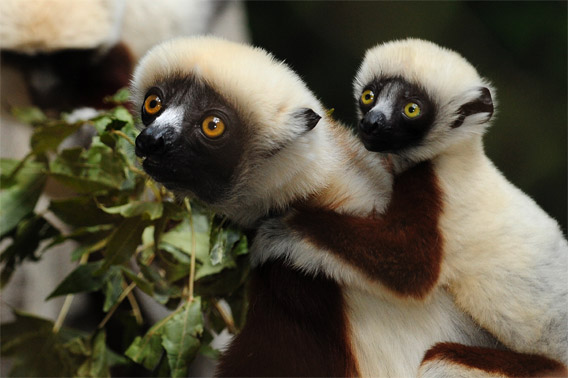 The Wildlife Conservation Society’s Bronx Zoo today announced the birth of an endangered Coquerel’s sifaka, a type of lemur native to the island of Madagascar. The baby boy lemur is named Ares and becomes one of 51 sifaka kept in captivity worldwide. While sifakas are generally found in trees where they are capable jumpers and […]
The Wildlife Conservation Society’s Bronx Zoo today announced the birth of an endangered Coquerel’s sifaka, a type of lemur native to the island of Madagascar. The baby boy lemur is named Ares and becomes one of 51 sifaka kept in captivity worldwide. While sifakas are generally found in trees where they are capable jumpers and […]
Environmental groups call on Delmas to cancel shipment of illegally logged wood from Madagascar
 Pressure is building on the French shipping company Delmas to cancel large shipments of rosewood, which was illegally logged in Madagascar during the nation’s recent coup. Today two environmental groups, Global Witness and the Environmental Investigation Agency (EIA) called on Delmas to cancel the shipment, which is currently being loaded onto the Delmas operated ship […]
Pressure is building on the French shipping company Delmas to cancel large shipments of rosewood, which was illegally logged in Madagascar during the nation’s recent coup. Today two environmental groups, Global Witness and the Environmental Investigation Agency (EIA) called on Delmas to cancel the shipment, which is currently being loaded onto the Delmas operated ship […]
Thousands of tons of illegal timber in Madagascar readied for export
 As the President of France, Nicholas Sarkozy, argues in Paris that more funding is needed to stop deforestation and mitigate climate change, a shipment of illegal rosewood is being readied for export in Madagascar by a French company with the tacit approval of the French government. The shipment of some 4,000-5,000 tons of rosewood will […]
As the President of France, Nicholas Sarkozy, argues in Paris that more funding is needed to stop deforestation and mitigate climate change, a shipment of illegal rosewood is being readied for export in Madagascar by a French company with the tacit approval of the French government. The shipment of some 4,000-5,000 tons of rosewood will […]
Humans push half of the world’s primates toward extinction, lemurs in particular trouble
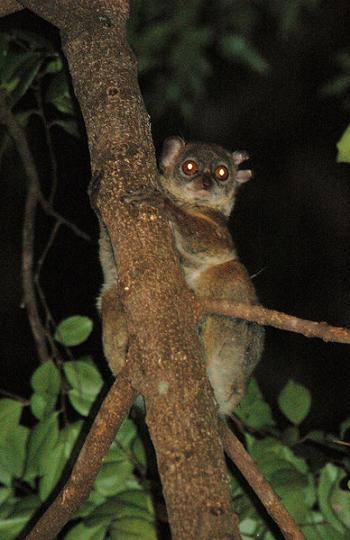 Experts release list of the world’s top 25 most endangered primates. Of the known 634 primate species in the world 48 percent are currently threatened with extinction, making mankind’s closes relatives one of the most endangered animal groups in the world. In order to bring awareness to the desperate state of primates, a new report […]
Experts release list of the world’s top 25 most endangered primates. Of the known 634 primate species in the world 48 percent are currently threatened with extinction, making mankind’s closes relatives one of the most endangered animal groups in the world. In order to bring awareness to the desperate state of primates, a new report […]
How to end Madagascar’s logging crisis
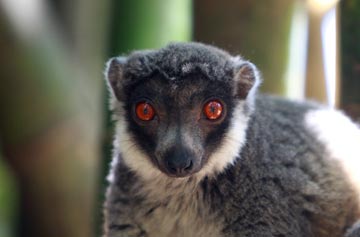 In the aftermath of a military coup last March, Madagascar’s rainforests have been pillaged for precious hardwoods, including rosewood and ebony. Tens of thousands of hectares have been affected, including some of the island’s most biologically diverse national parks: Marojejy, Masoala, and Makira. Illegal logging has also spurred the rise of a commercial bushmeat trade. […]
In the aftermath of a military coup last March, Madagascar’s rainforests have been pillaged for precious hardwoods, including rosewood and ebony. Tens of thousands of hectares have been affected, including some of the island’s most biologically diverse national parks: Marojejy, Masoala, and Makira. Illegal logging has also spurred the rise of a commercial bushmeat trade. […]
Coup leaders sell out Madagascar’s forests, people
- Madagascar is renowned for its biological richness.
- Located off the eastern coast of southern Africa and slightly larger than California, the island has an eclectic collection of plants and animals.
- But Madagascar’s biological bounty has been under siege for nearly a year in the aftermath of a political crisis which saw its president chased into exile at gunpoint; a collapse in its civil service, including its park management system; and evaporation of donor funds which provide half the government’s annual budget.
Natural rafts carried Madagascar’s unique wildlife to its shores
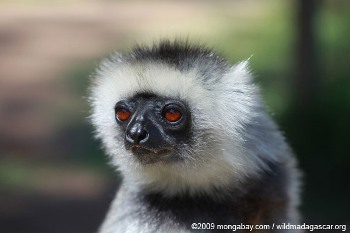 Imagine, forty million years ago a great tropical storm rises up on the eastern coast of Africa. Hundreds of trees are blown over and swept out to sea, but one harbors something special: inside a dry hollow rests a small lemur-like primate. Currents carry this tree and its passenger hundreds of miles until one gray […]
Imagine, forty million years ago a great tropical storm rises up on the eastern coast of Africa. Hundreds of trees are blown over and swept out to sea, but one harbors something special: inside a dry hollow rests a small lemur-like primate. Currents carry this tree and its passenger hundreds of miles until one gray […]
Madagascar sanctions logging of national parks
 Updates Madagascar has legalized the export of rosewood logs, possibly ushering in renewed logging of the country’s embattled rainforest parks. The transitional authority led by president Andry Rajoelina, who seized power during a military coup last March, today released a decree that allows the export of rosewood logs harvested from the Indian Ocean island’s national […]
Updates Madagascar has legalized the export of rosewood logs, possibly ushering in renewed logging of the country’s embattled rainforest parks. The transitional authority led by president Andry Rajoelina, who seized power during a military coup last March, today released a decree that allows the export of rosewood logs harvested from the Indian Ocean island’s national […]
Major international banks, shipping companies, and consumers play key role in Madagascar’s logging crisis
 Illegal Logging and Impotent Government in Madagascar’s Northeast In the midst of cyclone season, a ‘dead’ period for tourism to Madagascar’s east coast, Vohémar, a sleepy town dominated by the vanilla trade, is abuzz. Vanilla prices have hardly ever been lower, but the hotels are full and the port is busy. “This afternoon, it was […]
Illegal Logging and Impotent Government in Madagascar’s Northeast In the midst of cyclone season, a ‘dead’ period for tourism to Madagascar’s east coast, Vohémar, a sleepy town dominated by the vanilla trade, is abuzz. Vanilla prices have hardly ever been lower, but the hotels are full and the port is busy. “This afternoon, it was […]
Rosewood traffickers busted in Madagascar
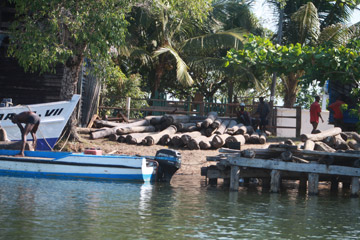 Authorities in Madagascar have sacked a local official, arrested several businessmen, and issued fines following the discovery of illegally harvested rosewood logs aboard a ship, reports L’Express de Madagascar. Hery Rajaonarimampianina, Madagascar’s Minister of Finance and Budget, said the Director of Environment and Forests of the Sava region (Northeastern Madagascar) has been suspended and several […]
Authorities in Madagascar have sacked a local official, arrested several businessmen, and issued fines following the discovery of illegally harvested rosewood logs aboard a ship, reports L’Express de Madagascar. Hery Rajaonarimampianina, Madagascar’s Minister of Finance and Budget, said the Director of Environment and Forests of the Sava region (Northeastern Madagascar) has been suspended and several […]
Government decree sanctions trafficking of rainforest timber in Madagascar
 A new decree by Madagascar’s transitional government may fuel continued destruction of the country’s tropical forests and biodiversity, warns a statement issued jointly by a dozen leading scientific and conservation groups. The decree, issued by Andry Rajoelina, a politician who seized the presidency during a March military coup, allows the export of hardoods illegally harvested […]
A new decree by Madagascar’s transitional government may fuel continued destruction of the country’s tropical forests and biodiversity, warns a statement issued jointly by a dozen leading scientific and conservation groups. The decree, issued by Andry Rajoelina, a politician who seized the presidency during a March military coup, allows the export of hardoods illegally harvested […]
Good news for the rarest lemur
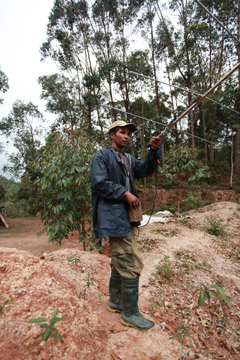 A scientific expedition has found one of the Madagascar’s rarest lemurs in a region where it was once thought to be extinct, report conservationists. With help from local communities, scientists spotted the Greater Bamboo Lemur (Prolemur simus) at 11 sites in Ankeniheny-Zahamena, a remote expanse of rainforest northeast of Madagascar’s capital city of Antananarivo. Ankeniheny-Zahamena […]
A scientific expedition has found one of the Madagascar’s rarest lemurs in a region where it was once thought to be extinct, report conservationists. With help from local communities, scientists spotted the Greater Bamboo Lemur (Prolemur simus) at 11 sites in Ankeniheny-Zahamena, a remote expanse of rainforest northeast of Madagascar’s capital city of Antananarivo. Ankeniheny-Zahamena […]
Innovative reforestation project threatened by ‘regime change’ in Madagascar, an interview with Rainer Dolch
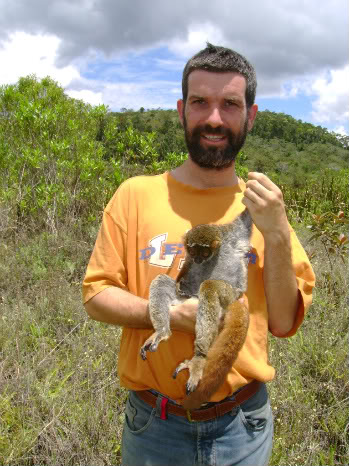 Third in a series of interviews with participants at the 2009 Association of Tropical Biology and Conservation (ATBC) conference. In Madagascar the TAMS Program (Tetik’asa Mampody Savoka, meaning “the project to bring back the forest”) is under threat due to the new government’s unwillingness to provide funding. The current government, after gaining power in a […]
Third in a series of interviews with participants at the 2009 Association of Tropical Biology and Conservation (ATBC) conference. In Madagascar the TAMS Program (Tetik’asa Mampody Savoka, meaning “the project to bring back the forest”) is under threat due to the new government’s unwillingness to provide funding. The current government, after gaining power in a […]
Crowned sifaka population on the verge of local extinction: dispatch from the field
 A small group of crowned sifaka lemurs Propithecus coronatus have been located in the corridor d’Amboloando-Dabolava, Miandrivazo district-Madagascar, but are immediately threatened with local extinction. The small, fragmented, and isolated forest shelters a group of only six adults and one baby. Interviews with local people revealed that once several groups of the species resided in […]
A small group of crowned sifaka lemurs Propithecus coronatus have been located in the corridor d’Amboloando-Dabolava, Miandrivazo district-Madagascar, but are immediately threatened with local extinction. The small, fragmented, and isolated forest shelters a group of only six adults and one baby. Interviews with local people revealed that once several groups of the species resided in […]
Destruction worsens in Madagascar
 local NGOs like
local NGOs like
Appalling photos reveal lemur carnage in Madagascar [warning: graphic images]
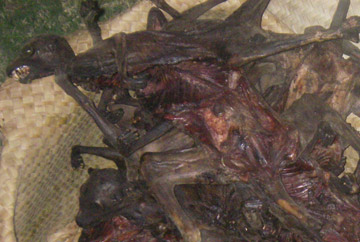 As governance collapses and aid disappears, commercial poaching emergesUpdate 13:00 PDT New pictures released by Conservation International depict a troubling development in Madagascar: the emergence of a commercial bushmeat market for lemurs. In the aftermath of a March coup that saw Madagascar’s president replaced at gunpoint by the capital city’s mayor, Madagascar’s reserves — especially […]
As governance collapses and aid disappears, commercial poaching emergesUpdate 13:00 PDT New pictures released by Conservation International depict a troubling development in Madagascar: the emergence of a commercial bushmeat market for lemurs. In the aftermath of a March coup that saw Madagascar’s president replaced at gunpoint by the capital city’s mayor, Madagascar’s reserves — especially […]
Lessons from the crisis in Madagascar, an interview with Erik Patel
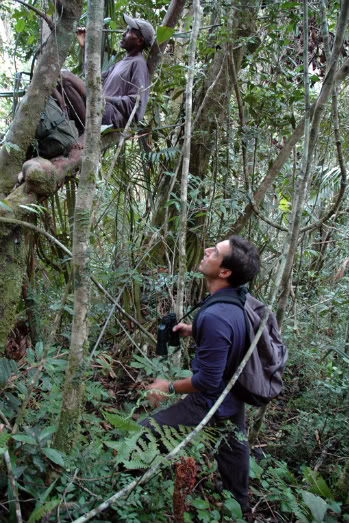
Photos: 5 baby lemurs born at the Bronx Zoo
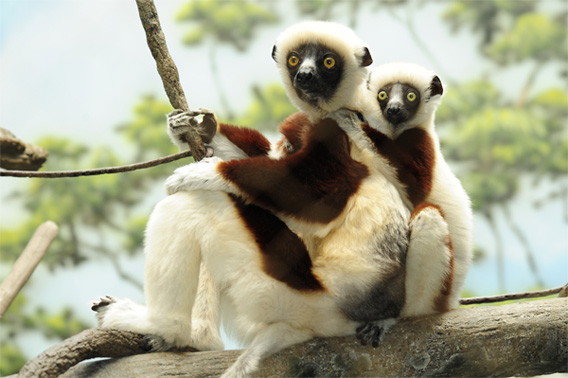 Five baby lemurs have been born at the Bronx Zoo’s Madagascar exhibit in the year since it opened, reports the Wildlife Conservation Society. Three red ruffed lemurs, one collared lemur and one Coquerel’s sifaka were born at the exhibit. Jim Breheny, Director of the Bronx Zoo and Senior Vice President of WCS’s Living Institutions, said […]
Five baby lemurs have been born at the Bronx Zoo’s Madagascar exhibit in the year since it opened, reports the Wildlife Conservation Society. Three red ruffed lemurs, one collared lemur and one Coquerel’s sifaka were born at the exhibit. Jim Breheny, Director of the Bronx Zoo and Senior Vice President of WCS’s Living Institutions, said […]
Forest Recovery Programs in Madagascar
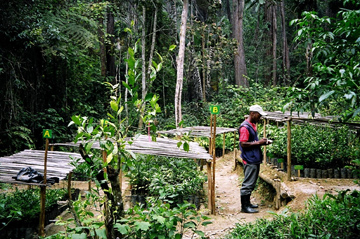 Despite being one of the last habitable land masses on earth to be settled by man, Madagascar has lost more of its forests than most countries; less than 10% of its original forest cover now remains, and much of that is degraded. Political turmoil that erupted earlier this year continues to rumble on and the […]
Despite being one of the last habitable land masses on earth to be settled by man, Madagascar has lost more of its forests than most countries; less than 10% of its original forest cover now remains, and much of that is degraded. Political turmoil that erupted earlier this year continues to rumble on and the […]
Conservation groups condemn ‘open and organized plundering’ of Madagascar’s natural resources
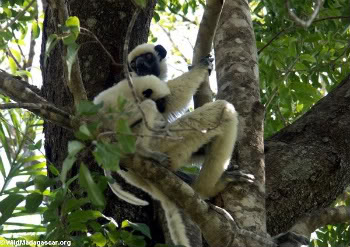 31-Mar update Eleven conservation organizations—including WWF, CI, and WCS—have banded together to condemn logging in Madagascar’s world renowned parks during a time of political crisis. Taking advantage of the turmoil after interim president Andry Rajoelina took control of the country in a bloodless coup from former president Marc Ravalomanana on March 17th, pristine forests have […]
31-Mar update Eleven conservation organizations—including WWF, CI, and WCS—have banded together to condemn logging in Madagascar’s world renowned parks during a time of political crisis. Taking advantage of the turmoil after interim president Andry Rajoelina took control of the country in a bloodless coup from former president Marc Ravalomanana on March 17th, pristine forests have […]
Political turmoil in Madagascar threatens lemurs, parks
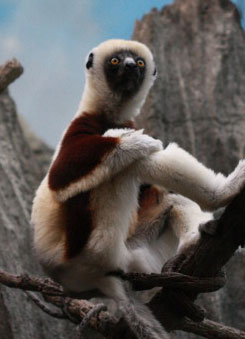 What’s happening in Madagascar and what does it mean for conservation? 31-Mar update | 30-Mar update | 23-Mar update Political turmoil in Madagascar has wrecked the country’s emerging ecotourism industry and is now threatening to undo decades of conservation work. The conflict between President Marc Ravalomanana and Andry Rajoelina, a former DJ who was, until […]
What’s happening in Madagascar and what does it mean for conservation? 31-Mar update | 30-Mar update | 23-Mar update Political turmoil in Madagascar has wrecked the country’s emerging ecotourism industry and is now threatening to undo decades of conservation work. The conflict between President Marc Ravalomanana and Andry Rajoelina, a former DJ who was, until […]
Nickel mine in Madagascar may threaten lemurs, undermine conservation efforts
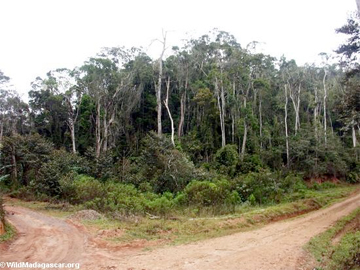 Sherritt’s response [added Jan 26, 20009] One of the world’s largest nickel mines will have adverse impacts on a threatened and biologically-rich forest in Madagascar, say conservationists. The $3.8 billion mining project, operated by Canada’s Sherritt, will tear up 1,300 to 1,700 hectares of primary rainforest that houses nearly 1,400 species of flowering plants, 14 […]
Sherritt’s response [added Jan 26, 20009] One of the world’s largest nickel mines will have adverse impacts on a threatened and biologically-rich forest in Madagascar, say conservationists. The $3.8 billion mining project, operated by Canada’s Sherritt, will tear up 1,300 to 1,700 hectares of primary rainforest that houses nearly 1,400 species of flowering plants, 14 […]
Madagascar denies ‘land grab’ by South Korean conglomerate
 Madagascar denies ‘land grab’ by South Korean conglomerate Madagascar denies ‘land grab’ by South Korean conglomerate mongabay.com November 22, 2008
Madagascar denies ‘land grab’ by South Korean conglomerate Madagascar denies ‘land grab’ by South Korean conglomerate mongabay.com November 22, 2008
An interview with ringtailed lemur expert Alison Jolly
 An interview with ringtailed lemur expert Alison Jolly An interview with ringtailed lemur expert Alison Jolly Rhett A. Butler, mongabay.com October 6, 2008 Madagascar has more than 100 types of lemurs, but the most famous species is the ringtailed lemur, a primate found widely in the southern part of the Indian Ocean island. The world’s […]
An interview with ringtailed lemur expert Alison Jolly An interview with ringtailed lemur expert Alison Jolly Rhett A. Butler, mongabay.com October 6, 2008 Madagascar has more than 100 types of lemurs, but the most famous species is the ringtailed lemur, a primate found widely in the southern part of the Indian Ocean island. The world’s […]
Dell becomes carbon neutral by saving endangered lemurs
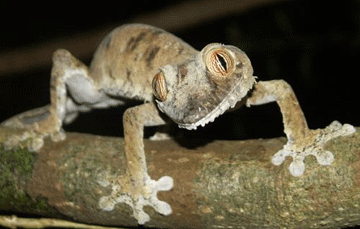 Dell becomes carbon neutral by saving endangered lemurs Dell becomes carbon neutral by saving endangered lemurs Rhett Butler, mongabay.com August 6, 2008 Dell, the world’s largest computer maker, announced it has become the first major technology company to achieve carbon neutrality. The Texas-based firm reached its goal through “an aggressive global energy-efficiency campaign and increasing […]
Dell becomes carbon neutral by saving endangered lemurs Dell becomes carbon neutral by saving endangered lemurs Rhett Butler, mongabay.com August 6, 2008 Dell, the world’s largest computer maker, announced it has become the first major technology company to achieve carbon neutrality. The Texas-based firm reached its goal through “an aggressive global energy-efficiency campaign and increasing […]
Developing the world’s most sophisticated program for mapping endangered species
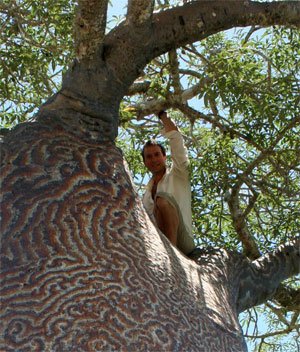 How a researcher developed the world’s most sophisticated program for mapping endangered species Developing the world’s most sophisticated programfor mapping endangered species: An Interview with Steven Phillips of AT&T Labs Jemery Hance, mongabay.com August 4, 2008 It was big news in April when a comprehensive map of Madagascar’s rich and unique biodiversity was unveiled. The […]
How a researcher developed the world’s most sophisticated program for mapping endangered species Developing the world’s most sophisticated programfor mapping endangered species: An Interview with Steven Phillips of AT&T Labs Jemery Hance, mongabay.com August 4, 2008 It was big news in April when a comprehensive map of Madagascar’s rich and unique biodiversity was unveiled. The […]
Population of critically endangered lemurs discovered in Madagascar
 Population of critically endangered lemurs discovered in Madagascar Population of critically endangered lemurs discovered in Madagascar mongabay.com July 22, 2008 Scientists in Madagascar have discovered a population of greater bamboo lemurs (Prolemur simus), a critically endangered species of primate, in an area more than 400 kilometers away from its only known refuge, reports Conservation International. […]
Population of critically endangered lemurs discovered in Madagascar Population of critically endangered lemurs discovered in Madagascar mongabay.com July 22, 2008 Scientists in Madagascar have discovered a population of greater bamboo lemurs (Prolemur simus), a critically endangered species of primate, in an area more than 400 kilometers away from its only known refuge, reports Conservation International. […]
Tiny lemur species discovered in Madagascar
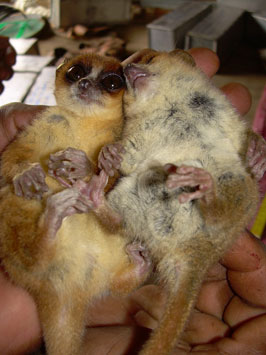 Tiny lemur species discovered in Madagascar Tiny lemur species discovered in Madagascar mongabay.com July 14, 2008 Researchers have discovered a previously unknown species of mouse lemur on the island of Madagascar. The find brings the global number of mouse lemurs to 16. The tiny primate was discovered by local scientists inventorying the tropical rainforests of […]
Tiny lemur species discovered in Madagascar Tiny lemur species discovered in Madagascar mongabay.com July 14, 2008 Researchers have discovered a previously unknown species of mouse lemur on the island of Madagascar. The find brings the global number of mouse lemurs to 16. The tiny primate was discovered by local scientists inventorying the tropical rainforests of […]
Lemurs are key to health of Madagascar’s rainforests
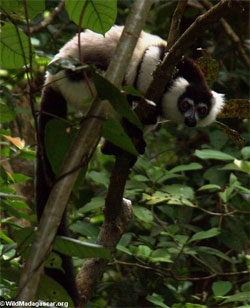 Lemurs are key to health of Madagascar’s rainforests Lemurs are key to health of Madagascar’s rainforests Rhett A. Butler, mongabay.com June 12, 2008 Lemurs play a key role in the health of Madagascar’s tropical rainforests said a renowned primatologist speaking at a meeting of conservation biologists in Paramaribo, Suriname. Analyzing 20 years of data on […]
Lemurs are key to health of Madagascar’s rainforests Lemurs are key to health of Madagascar’s rainforests Rhett A. Butler, mongabay.com June 12, 2008 Lemurs play a key role in the health of Madagascar’s tropical rainforests said a renowned primatologist speaking at a meeting of conservation biologists in Paramaribo, Suriname. Analyzing 20 years of data on […]
Madagascar signs big carbon deal to fund rainforest conservation
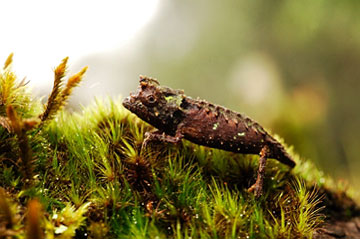 Madagascar signs big carbon deal to fund rainforest conservation Madagascar signs big carbon deal to fund rainforest conservation Rhett A. Butler, mongabay.com June 11, 2008 Madagascar will sell more than nine million tons of carbon offsets to fund rainforest conservation in a newly established protected area. Conservationists say the deal will protect endangered wildlife, promote […]
Madagascar signs big carbon deal to fund rainforest conservation Madagascar signs big carbon deal to fund rainforest conservation Rhett A. Butler, mongabay.com June 11, 2008 Madagascar will sell more than nine million tons of carbon offsets to fund rainforest conservation in a newly established protected area. Conservationists say the deal will protect endangered wildlife, promote […]
Madagascar’s deforestation rate drops 8-fold in parks
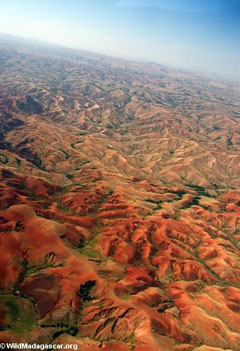 Madagascar’s deforestation rate drops 8-fold in parks Madagascar’s deforestation rate drops 8-fold in parks mongabay.com March 10, 2008 Madagascar’s deforestation rate in protected areas has fallen by eight-fold since the 1990s according to Conservation International and the Malagasy government. Reuters reports that satellite images reveal a drop in deforestation rate in reserves from 0.8 percent […]
Madagascar’s deforestation rate drops 8-fold in parks Madagascar’s deforestation rate drops 8-fold in parks mongabay.com March 10, 2008 Madagascar’s deforestation rate in protected areas has fallen by eight-fold since the 1990s according to Conservation International and the Malagasy government. Reuters reports that satellite images reveal a drop in deforestation rate in reserves from 0.8 percent […]
Aye-aye diverged from other lemurs 66M years ago
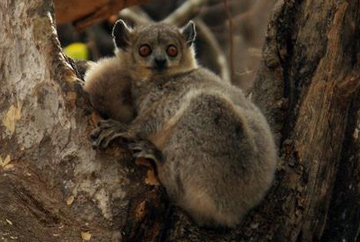 Aye-aye diverged from other lemurs 66M years ago Aye-aye diverged from other lemurs 66M years ago wildmadagascar.org February 25, 2008 The aye-aye — a bizarre, nocturnal lemur that taps on trees with its fingers to find its insect prey — was the first of its family to branch off from the rest of the lemur […]
Aye-aye diverged from other lemurs 66M years ago Aye-aye diverged from other lemurs 66M years ago wildmadagascar.org February 25, 2008 The aye-aye — a bizarre, nocturnal lemur that taps on trees with its fingers to find its insect prey — was the first of its family to branch off from the rest of the lemur […]
Photos: rare aye-aye lemur born at Bristol Zoo Gardens
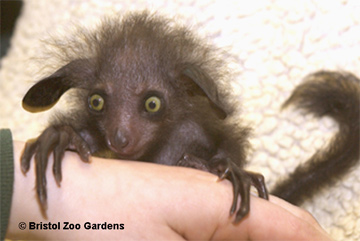 Photos: rare aye-aye lemur born at Bristol Zoo Gardens Photos: rare aye-aye lemur born at Bristol Zoo Gardens Jeremy Hance, mongabay.com January 16, 2008 Photos courtesy of Bristol Zoo Gardens Born on November 23rd, 2007 at Bristol Zoo Gardens this baby Aye-aye was given the name Raz. According to the EDGE (Evolutionary Distinct and Globally […]
Photos: rare aye-aye lemur born at Bristol Zoo Gardens Photos: rare aye-aye lemur born at Bristol Zoo Gardens Jeremy Hance, mongabay.com January 16, 2008 Photos courtesy of Bristol Zoo Gardens Born on November 23rd, 2007 at Bristol Zoo Gardens this baby Aye-aye was given the name Raz. According to the EDGE (Evolutionary Distinct and Globally […]
UNESCO lists rainforest parks of Madagascar as Heritage sites
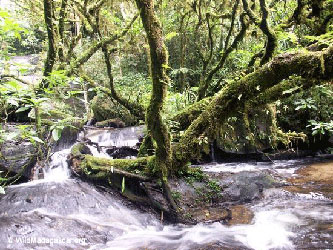 UNESCO lists rainforests of Madagascar as Heritage sites UNESCO lists rainforests of Madagascar as Heritage sites Rhett A. Butler, mongabay.com July 3, 2007 UNESCO has listed six rainforest parks in Madagascar as World Heritage sites. The announcement comes as the Indian Ocean island nation has moved aggressively to protect its biologically-rich forests from further degradation. […]
UNESCO lists rainforests of Madagascar as Heritage sites UNESCO lists rainforests of Madagascar as Heritage sites Rhett A. Butler, mongabay.com July 3, 2007 UNESCO has listed six rainforest parks in Madagascar as World Heritage sites. The announcement comes as the Indian Ocean island nation has moved aggressively to protect its biologically-rich forests from further degradation. […]
conservation is saving lemurs and helping people in Madagascar
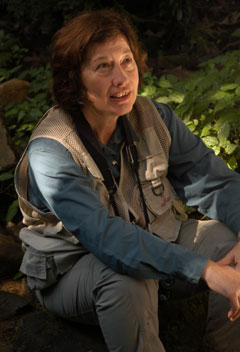 An interview with lemur expert Dr. Patricia Wright Conservation is saving lemurs and helping people in Madagascar: An interview with lemur expert Dr. Patricia Wright wildmadagascar.org May 7, 2007 Madagascar, an island nation that lies off the coast of southeastern Africa, has long been famous for its unique and diverse species of wildlife, especially lemurs—primates […]
An interview with lemur expert Dr. Patricia Wright Conservation is saving lemurs and helping people in Madagascar: An interview with lemur expert Dr. Patricia Wright wildmadagascar.org May 7, 2007 Madagascar, an island nation that lies off the coast of southeastern Africa, has long been famous for its unique and diverse species of wildlife, especially lemurs—primates […]
Lemurs at risk due to invasion of feral beasts, global warming
 Lemurs at risk due to invasion of feral beasts, global warming Feral beasts threaten lemurs in Madagascar: An interview with lemur expert Dr. Michelle Sauther Rhett A. Butler, wildmadagascar.org February 7, 2007 The lemurs of Madagascar are among the world’s most threatened primates. Extensive habitat destruction, hunting, and the introduction of alien species have doomed […]
Lemurs at risk due to invasion of feral beasts, global warming Feral beasts threaten lemurs in Madagascar: An interview with lemur expert Dr. Michelle Sauther Rhett A. Butler, wildmadagascar.org February 7, 2007 The lemurs of Madagascar are among the world’s most threatened primates. Extensive habitat destruction, hunting, and the introduction of alien species have doomed […]
In search of wildlife, while dodging leeches, in Madagascar’s unexplored rainforest
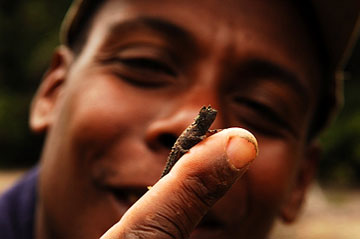 Dodging leeches in Madagascar’s unexplored rainforest Adventures with Julie Larsen Maher, staff photographer of WCS It is called a rainforest for a reason—because it rains…. and rains. As my field partner, Angelin Razafimanantsoa, and I make our way down muddy mountainsides in the endless downpour, we stop only long enough to pick squirming, bloodthirsty leeches […]
Dodging leeches in Madagascar’s unexplored rainforest Adventures with Julie Larsen Maher, staff photographer of WCS It is called a rainforest for a reason—because it rains…. and rains. As my field partner, Angelin Razafimanantsoa, and I make our way down muddy mountainsides in the endless downpour, we stop only long enough to pick squirming, bloodthirsty leeches […]
Lemurs communicate by scent
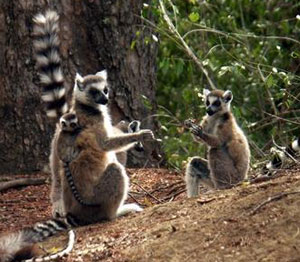 Ringtailed lemurs can recognize each other by scent according to a study published in the current issue of the journal Animal Behaviour. The research, conducted by Elizabeth S. Scordato and Christine M. Drea of Duke University, looked at olfactory communication in the ringtailed lemur, a charismatic primate that forms complex social groups led by a […]
Ringtailed lemurs can recognize each other by scent according to a study published in the current issue of the journal Animal Behaviour. The research, conducted by Elizabeth S. Scordato and Christine M. Drea of Duke University, looked at olfactory communication in the ringtailed lemur, a charismatic primate that forms complex social groups led by a […]
3 new lemur species identified in Madagascar
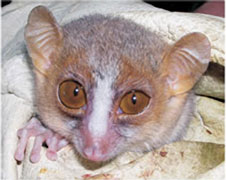 3 new lemur species identified in Madagascar 3 new lemur species identified in Madagascar wildmadagascar.org November 27, 2006 Genetic analysis has revealed three previously unknown species of lemurs on the Indian Ocean island of Madagascar. The newly described lemurs are all mouse lemurs, one of the world’s smallest primates. These lively lemurs are found in […]
3 new lemur species identified in Madagascar 3 new lemur species identified in Madagascar wildmadagascar.org November 27, 2006 Genetic analysis has revealed three previously unknown species of lemurs on the Indian Ocean island of Madagascar. The newly described lemurs are all mouse lemurs, one of the world’s smallest primates. These lively lemurs are found in […]
Lemur conservation in Madagascar requires poverty alleviation initiatives
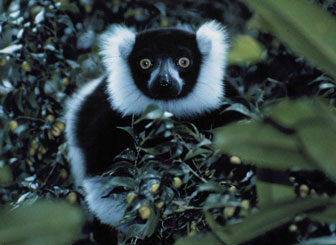 Lemur conservation requires poverty alleviation initiatives in Madagascar An interview with lemur expert Charlie Welch: Lemur conservation requires poverty alleviation initiatives in Madagascar Patience and a sense of humor help too Rhett A. Butler, mongabay.com November 5, 2006 Madagascar, an island larger than France that lies off the southeastern coast of Africa, is perhaps best […]
Lemur conservation requires poverty alleviation initiatives in Madagascar An interview with lemur expert Charlie Welch: Lemur conservation requires poverty alleviation initiatives in Madagascar Patience and a sense of humor help too Rhett A. Butler, mongabay.com November 5, 2006 Madagascar, an island larger than France that lies off the southeastern coast of Africa, is perhaps best […]
Climate Change Threatens Lemurs
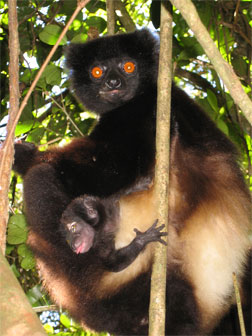 Climate Change Threatens Lemurs Climate Change Threatens Lemurs Earthwatch Institute September 18, 2006 Tropical rainforests are among the most stable environments on Earth, but they are still no match for global climate change. Dr. Patricia Wright, the widely admired primatologist and Professor of Anthropology at Stony Brook University, finds that climate change could mean the […]
Climate Change Threatens Lemurs Climate Change Threatens Lemurs Earthwatch Institute September 18, 2006 Tropical rainforests are among the most stable environments on Earth, but they are still no match for global climate change. Dr. Patricia Wright, the widely admired primatologist and Professor of Anthropology at Stony Brook University, finds that climate change could mean the […]
Orangutans and chimps are smarter than monkeys and lemurs
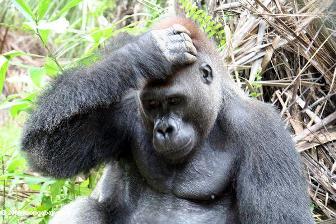 Orangutans and chimps are smarter than monkeys and lemurs Orangutans and chimps are smarter than monkeys and lemurs mongabay.com August 1, 2006 The great apes are the smartest of all nonhuman primates according to scientists at Duke University Medical Center. The researchers found that orangutans and chimpanzees consistently outperformed monkeys and lemurs on a variety […]
Orangutans and chimps are smarter than monkeys and lemurs Orangutans and chimps are smarter than monkeys and lemurs mongabay.com August 1, 2006 The great apes are the smartest of all nonhuman primates according to scientists at Duke University Medical Center. The researchers found that orangutans and chimpanzees consistently outperformed monkeys and lemurs on a variety […]
Rare indri lemur born in forest reserve in Madagascar
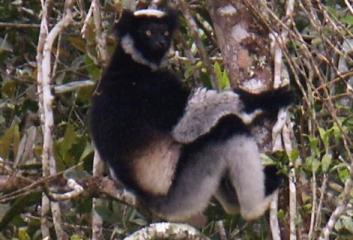 Rare indri lemur born in forest reserve in Madagascar Rare indri lemur born in forest reserve in Madagascar wildmadagascar.org July 13, 2006 A rare lemur known for its haunting whale-like call has given birth in a reserve outside its native forest. The news is significant because the Indri, as the world’s largest living lemur is […]
Rare indri lemur born in forest reserve in Madagascar Rare indri lemur born in forest reserve in Madagascar wildmadagascar.org July 13, 2006 A rare lemur known for its haunting whale-like call has given birth in a reserve outside its native forest. The news is significant because the Indri, as the world’s largest living lemur is […]
3 new lemurs named in Madagascar
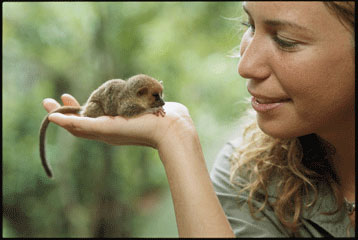 3 new lemurs named in Madagascar 3 new lemurs named in Madagascar Conservation International June 21, 2006 To recognize an internationally renowned primatologist and champion of Madagascar’s unique biodiversity, scientists who discovered three new species of mouse lemur on the island nation have named one in honor of Russell A. Mittermeier, the president of Conservation […]
3 new lemurs named in Madagascar 3 new lemurs named in Madagascar Conservation International June 21, 2006 To recognize an internationally renowned primatologist and champion of Madagascar’s unique biodiversity, scientists who discovered three new species of mouse lemur on the island nation have named one in honor of Russell A. Mittermeier, the president of Conservation […]
Why does Madagascar have so many unique animals?
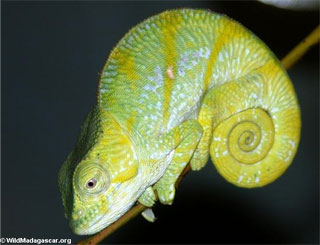 Why does Madagascar have so many unique animals?y Climate Change May be Responsible for Madagascar’s Biodiversity Why does Madagascar have so many unique animals? wildmadagascar.org May 24, 2006 Scientists have developed the first comprehensive theory to explain Madagascar’s rich biodiversity. Madagascar, larger than California and about size the size of Texas or France, is the […]
Why does Madagascar have so many unique animals?y Climate Change May be Responsible for Madagascar’s Biodiversity Why does Madagascar have so many unique animals? wildmadagascar.org May 24, 2006 Scientists have developed the first comprehensive theory to explain Madagascar’s rich biodiversity. Madagascar, larger than California and about size the size of Texas or France, is the […]
Madagascar establishes new park system to protect lemurs, benefit people
 Madagascar establishes new park system to protect lemurs, benefit people Madagascar establishes new park system to protect lemurs, benefit people IRIN, a UN humanitarian news and information service January 17, 2006 MAHITSIARONGANA, 17 January (IRIN) – President Marc Ravalomanana’s government has embarked on an ambitious national effort to protect Madagascar’s remaining biodiversity while simultaneously reducing […]
Madagascar establishes new park system to protect lemurs, benefit people Madagascar establishes new park system to protect lemurs, benefit people IRIN, a UN humanitarian news and information service January 17, 2006 MAHITSIARONGANA, 17 January (IRIN) – President Marc Ravalomanana’s government has embarked on an ambitious national effort to protect Madagascar’s remaining biodiversity while simultaneously reducing […]
Lemur land, Madagascar now protected
 Lemur land, Madagascar now protected Lemur land, Madagascar now protected Rhett A. Butler, wildmadagascar.org January 8, 2006 Madagascar is one of the world’s most special places. An island slightly larger than the state of California, Madagascar is home to a bewildering array of wildlife from dancing lemurs to absurdly colorful chameleons. Eighty percent of the […]
Lemur land, Madagascar now protected Lemur land, Madagascar now protected Rhett A. Butler, wildmadagascar.org January 8, 2006 Madagascar is one of the world’s most special places. An island slightly larger than the state of California, Madagascar is home to a bewildering array of wildlife from dancing lemurs to absurdly colorful chameleons. Eighty percent of the […]
Rain key to survival of baby lemurs
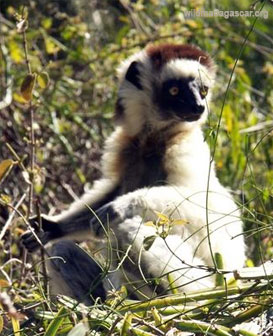 Rain key to survival of baby lemurs Rain key to survival of baby lemurs Stony Brook University news release November 14, 2005 STONY BROOK, N.Y., November 14, 2005—Researchers studying lemurs in Madagascar have discovered a link between tooth deterioration and rainfall amounts that suggests long-lived mammals may be particularly sensitive to changing environmental conditions—and that […]
Rain key to survival of baby lemurs Rain key to survival of baby lemurs Stony Brook University news release November 14, 2005 STONY BROOK, N.Y., November 14, 2005—Researchers studying lemurs in Madagascar have discovered a link between tooth deterioration and rainfall amounts that suggests long-lived mammals may be particularly sensitive to changing environmental conditions—and that […]
Humans hunted giant lemurs to extinction
 Humans ate giant lemurs to extinction Humans ate giant lemurs to extinction wildmadagascar.org November 14, 2005 Madagascar’s first inhabitants probably hunted the island’s largest animals to extinction according to research published in the November issue of the Journal of Human Evolution. Madagascar, an island a little larger than California, has long been known for its […]
Humans ate giant lemurs to extinction Humans ate giant lemurs to extinction wildmadagascar.org November 14, 2005 Madagascar’s first inhabitants probably hunted the island’s largest animals to extinction according to research published in the November issue of the Journal of Human Evolution. Madagascar, an island a little larger than California, has long been known for its […]
Lemur species named after British comedian
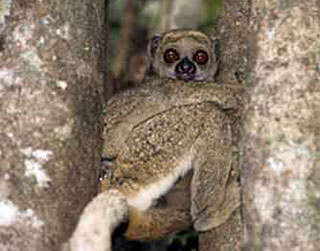 Lemur species named after British comedian New lemur species named after British comedian wildmadagascar.org November 12, 2005 Researchers from the University of Zurich have named a newly discovered species of lemur after British comedian John Cleese in honor of his work with the primates from Madagascar. According to the university, the lemur’s name is a […]
Lemur species named after British comedian New lemur species named after British comedian wildmadagascar.org November 12, 2005 Researchers from the University of Zurich have named a newly discovered species of lemur after British comedian John Cleese in honor of his work with the primates from Madagascar. According to the university, the lemur’s name is a […]
Two tiny lemur species discovered in Madagascar
 Two tiny lemur species discovered in Madagascar Two tiny lemur species discovered in Madagascar Field Museum release August 9, 2005 Finding follows discovery of two other new species of lemurs earlier this year. CHICAGO–German and Malagasy primatologists have discovered two new species of lemurs, naming one of them after Steve Goodman, a Field Museum scientist […]
Two tiny lemur species discovered in Madagascar Two tiny lemur species discovered in Madagascar Field Museum release August 9, 2005 Finding follows discovery of two other new species of lemurs earlier this year. CHICAGO–German and Malagasy primatologists have discovered two new species of lemurs, naming one of them after Steve Goodman, a Field Museum scientist […]
Lemur hunting persists in Madagascar, rare primates fall victim to hunger
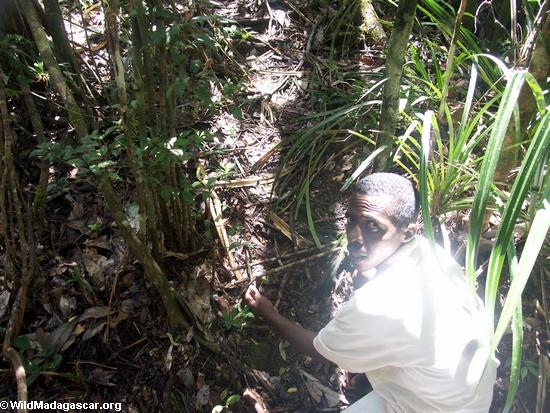 Lemur hunting persists in Madagascar, rare primates fall victim to hunger Lemur hunting persists in Madagascar, rare primates fall victim to hunger Rhett Butler July 17, 2005 Armand stares down at the trap made from sticks and ropes in the rainforest of Masoala. “For carnivores,” he says. Armand examining a trap set for carnivores in […]
Lemur hunting persists in Madagascar, rare primates fall victim to hunger Lemur hunting persists in Madagascar, rare primates fall victim to hunger Rhett Butler July 17, 2005 Armand stares down at the trap made from sticks and ropes in the rainforest of Masoala. “For carnivores,” he says. Armand examining a trap set for carnivores in […]
Madagascar lemurs descended from single primate ancestor, finds study
 Madagascar lemurs descended from single primate ancestor, finds study Madagascar lemurs descended from single primate ancestor, finds study YALE News Release July 11, 2005 Yale biologists have managed to extract and analyze DNA from giant, extinct lemurs, according to a Yale study published in a recent issue of the Proceedings of the National Academy of […]
Madagascar lemurs descended from single primate ancestor, finds study Madagascar lemurs descended from single primate ancestor, finds study YALE News Release July 11, 2005 Yale biologists have managed to extract and analyze DNA from giant, extinct lemurs, according to a Yale study published in a recent issue of the Proceedings of the National Academy of […]
Dancing lemur attracts tourists to island of Madagascar
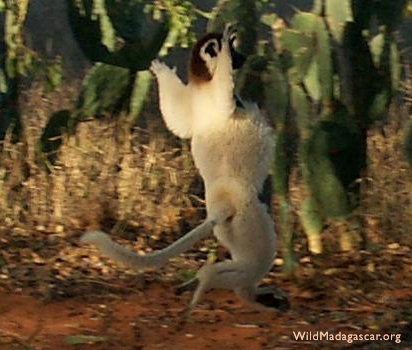 Dancing lemur attracts tourists to island of Madagascar Dancing lemur attracts tourists to island of Madagascar By Rhett Butler, mongabay.com / wildmadagascar.org May 30, 2005 Updated September 7, 2005 Verreaux’s Sifaka (Propithecus verreauxi verreauxi) doing its dance In the dry deciduous forests of south western Madagascar there lives a lemur that loudly cusses but “dances” […]
Dancing lemur attracts tourists to island of Madagascar Dancing lemur attracts tourists to island of Madagascar By Rhett Butler, mongabay.com / wildmadagascar.org May 30, 2005 Updated September 7, 2005 Verreaux’s Sifaka (Propithecus verreauxi verreauxi) doing its dance In the dry deciduous forests of south western Madagascar there lives a lemur that loudly cusses but “dances” […]
Seeking the world’s strangest primate on a tropical island paradise
 Madagascar has been called the “land that time forgot” for its collection of unique and often downright bizarre plants and animals. Around 75% of the species on the island are found nowhere else on Earth, putting Madagascar atop the list among the world’s most biologically diverse countries. Madagascar is famous for its lemurs, a group […]
Madagascar has been called the “land that time forgot” for its collection of unique and often downright bizarre plants and animals. Around 75% of the species on the island are found nowhere else on Earth, putting Madagascar atop the list among the world’s most biologically diverse countries. Madagascar is famous for its lemurs, a group […]
Feeds: news | india | latam | brasil | indonesia
 Chocolate company collaborates with NGO to conserve Madagascar’s iconic wildlife while helping bolster the prospects of a long-overlooked reserve Madécasse produces chocolate bars from cocoa grown and processed in Madagascar. Photo courtesy of Christi Turner. Madécasse (pronounced “mah-DAY-kas”), which brands itself as an eco-conscious and socially responsible company known for its bean-to-bar-in-Madagascar chocolate,, has teamed […]
Chocolate company collaborates with NGO to conserve Madagascar’s iconic wildlife while helping bolster the prospects of a long-overlooked reserve Madécasse produces chocolate bars from cocoa grown and processed in Madagascar. Photo courtesy of Christi Turner. Madécasse (pronounced “mah-DAY-kas”), which brands itself as an eco-conscious and socially responsible company known for its bean-to-bar-in-Madagascar chocolate,, has teamed […] Could a website save the world’s lemurs? Indri lemur (Indri indri). Photo by: Rhett A. Butler. Last year, scientists released an emergency three-year plan that they argued could, quite literally, save the world’s lemurs from mass extinction. Costing just $7.6 million, the plan focused on setting up better protections and conservation programs in 30 lemur […]
Could a website save the world’s lemurs? Indri lemur (Indri indri). Photo by: Rhett A. Butler. Last year, scientists released an emergency three-year plan that they argued could, quite literally, save the world’s lemurs from mass extinction. Costing just $7.6 million, the plan focused on setting up better protections and conservation programs in 30 lemur […] Coquerel’s Sifaka (Propithecus coquereli) September 1 is World Primate Day, a designation intended to raise awareness about apes, monkeys, and prosimians like lemurs, lorises, and tarsiers. Many non-human primates are threatened by habitat loss, the pet trade, and hunting. There are more than 440 species of primate worldwide, the majority of which live in the […]
Coquerel’s Sifaka (Propithecus coquereli) September 1 is World Primate Day, a designation intended to raise awareness about apes, monkeys, and prosimians like lemurs, lorises, and tarsiers. Many non-human primates are threatened by habitat loss, the pet trade, and hunting. There are more than 440 species of primate worldwide, the majority of which live in the […] Innovation in Tropical Forest Conservation: Q&A with Susie McGuire and Dr. Ed Louis Jr. Ed Louis (left) and Susie McGuire (right) with aye-aye. Photo courtesy of the Madagascar Biodiversity Partnership and Conservation Fusion. Susie McGuire and Dr. Edward Louis Jr. are the powerhouse team behind the Madagascar Biodiversity Partnership (MBP), an NGO that involves local […]
Innovation in Tropical Forest Conservation: Q&A with Susie McGuire and Dr. Ed Louis Jr. Ed Louis (left) and Susie McGuire (right) with aye-aye. Photo courtesy of the Madagascar Biodiversity Partnership and Conservation Fusion. Susie McGuire and Dr. Edward Louis Jr. are the powerhouse team behind the Madagascar Biodiversity Partnership (MBP), an NGO that involves local […] The famous ring-tailed lemur (Lemur catta) is now listed as Endangered, one of 90 lemur species currently considered threatened with extinction. Photo by: Rhett A. Butler. Experts have added 817 species to the threatened categories of the IUCN Red List in the latest update. Those added include 51 mammals—mostly lemurs—and over 400 plants. The new […]
The famous ring-tailed lemur (Lemur catta) is now listed as Endangered, one of 90 lemur species currently considered threatened with extinction. Photo by: Rhett A. Butler. Experts have added 817 species to the threatened categories of the IUCN Red List in the latest update. Those added include 51 mammals—mostly lemurs—and over 400 plants. The new […] Patricia Wright attends a cocktail reception at the Mission to the UN of Madagascar, May 15, 2014 in New York. INSIDER IMAGES/Gary He. Lemur expert Patricia C. Wright has become the first woman to win the prestigious Indianapolis Prize, an award granted every two years for achievement in wildlife conservation. Wright was selected among six […]
Patricia Wright attends a cocktail reception at the Mission to the UN of Madagascar, May 15, 2014 in New York. INSIDER IMAGES/Gary He. Lemur expert Patricia C. Wright has become the first woman to win the prestigious Indianapolis Prize, an award granted every two years for achievement in wildlife conservation. Wright was selected among six […] Ring-talked lemur: the national animal symbol of Madagascar. Photo by: Rhett A. Butler. In the fight for conservation Madagascar is without a doubt on the front lines. Not only are most of its forests already destroyed—with a mere 10% of intact forest remaining at best—but there’s still much to lose in what remains. Madagascar is […]
Ring-talked lemur: the national animal symbol of Madagascar. Photo by: Rhett A. Butler. In the fight for conservation Madagascar is without a doubt on the front lines. Not only are most of its forests already destroyed—with a mere 10% of intact forest remaining at best—but there’s still much to lose in what remains. Madagascar is […] Left to right – Soundtrack artist Hanitrarivo Rasoanaivo, director David Douglas, writer/producer Drew Fellman, narrator Morgan Freeman and Patricia C. Wright greet the gathered crowd outside the California Science Center IMAX Theater in Los Angeles on March 29, 2014. Tomorrow’s opening of the IMAX film Island of Lemurs: Madagascar showcases not only endangered primates, but […]
Left to right – Soundtrack artist Hanitrarivo Rasoanaivo, director David Douglas, writer/producer Drew Fellman, narrator Morgan Freeman and Patricia C. Wright greet the gathered crowd outside the California Science Center IMAX Theater in Los Angeles on March 29, 2014. Tomorrow’s opening of the IMAX film Island of Lemurs: Madagascar showcases not only endangered primates, but […] One of the world’s biggest populations of greater bamboo lemurs (Prolemur simus)—sometimes known as the panda lemur—has doubled in just three years, giving conservationists new hope that the species can be kept from extinction. With the recent arrival of twenty babies, a community conservation project run by the Aspinall Foundation has boosted the local population […]
One of the world’s biggest populations of greater bamboo lemurs (Prolemur simus)—sometimes known as the panda lemur—has doubled in just three years, giving conservationists new hope that the species can be kept from extinction. With the recent arrival of twenty babies, a community conservation project run by the Aspinall Foundation has boosted the local population […] Verreaux’s Sifaka (Propithecus verreauxi), listed as Vulnerable, in a heated chase. Photo by: Rhett A. Butler. Due to the wonderful idiosyncrasies of evolution, there is one country on Earth that houses 20 percent of the world’s primates. More astounding still, every single one of these primates—an entire distinct family in fact—are found no-where else. The […]
Verreaux’s Sifaka (Propithecus verreauxi), listed as Vulnerable, in a heated chase. Photo by: Rhett A. Butler. Due to the wonderful idiosyncrasies of evolution, there is one country on Earth that houses 20 percent of the world’s primates. More astounding still, every single one of these primates—an entire distinct family in fact—are found no-where else. The […] The ring-tailed lemur (Lemur catta), perhaps the most well-known of Madagascar’s endemic animals, is facing a “very high” risk of extinction in the wild. The Madagascar Section of the IUCN Primate Specialist Group reassessed the Red List status of ring-tailed lemurs and upgraded the species from Near-Threatened (2008) to Endangered (2012). Ring-tailed lemurs are facing […]
The ring-tailed lemur (Lemur catta), perhaps the most well-known of Madagascar’s endemic animals, is facing a “very high” risk of extinction in the wild. The Madagascar Section of the IUCN Primate Specialist Group reassessed the Red List status of ring-tailed lemurs and upgraded the species from Near-Threatened (2008) to Endangered (2012). Ring-tailed lemurs are facing […] Lemurs in a cave in Madagascar. Photo by Rhett A. Butler After playing, feeding, and socializing in trees all day, some ring-tailed lemurs (Lemur catta) take their nightly respite in caves, according to a new study in Madagascar Conservation and Development. The findings are important because this is the first time scientists have ever recorded […]
Lemurs in a cave in Madagascar. Photo by Rhett A. Butler After playing, feeding, and socializing in trees all day, some ring-tailed lemurs (Lemur catta) take their nightly respite in caves, according to a new study in Madagascar Conservation and Development. The findings are important because this is the first time scientists have ever recorded […] Raising young lemurs in communal crèches benefits both mothers and offspring, a new study has found. Andrea Baden and colleagues, of Yale University, studied a group of black-and-white ruffed lemurs (Varecia variegata) in Ranomafana National Park, Madagascar. This is the first study to examine the consequences of different parenting strategies in the ruffed lemur. By […]
Raising young lemurs in communal crèches benefits both mothers and offspring, a new study has found. Andrea Baden and colleagues, of Yale University, studied a group of black-and-white ruffed lemurs (Varecia variegata) in Ranomafana National Park, Madagascar. This is the first study to examine the consequences of different parenting strategies in the ruffed lemur. By […] Primatologists and researchers have devised a wide-ranging plan to protect Madagascar’s most endangered lemurs from extinction. The plan, produced by the IUCN/SSC Primate Specialist Group, aims to reverse declining population trends among lemurs, 94 percent of which are considered at risk of extinction due to habitat loss and hunting. Strategies outlined in the report including […]
Primatologists and researchers have devised a wide-ranging plan to protect Madagascar’s most endangered lemurs from extinction. The plan, produced by the IUCN/SSC Primate Specialist Group, aims to reverse declining population trends among lemurs, 94 percent of which are considered at risk of extinction due to habitat loss and hunting. Strategies outlined in the report including […] Does size matter? When referring to primate brain size and its relation to social intelligence, scientists at Duke University do not think the answer is a simple yes or no. In the past, scientists have correlated large brain size to large group size. However, in a new study published in PLoS ONE, scientists at Duke […]
Does size matter? When referring to primate brain size and its relation to social intelligence, scientists at Duke University do not think the answer is a simple yes or no. In the past, scientists have correlated large brain size to large group size. However, in a new study published in PLoS ONE, scientists at Duke […] Researchers have discovered a new — and critically endangered — species of lemur on the island of Madagascar. The primate is formally described in the journal Molecular Phylogenetics and Evolution. The Lavasoa Dwarf Lemur (Cheirogaleus lavasoensis) inhabits three isolated forest fragments in the Lavasoa Mountains in southern Madagascar. Like other dwarf lemurs, the species is […]
Researchers have discovered a new — and critically endangered — species of lemur on the island of Madagascar. The primate is formally described in the journal Molecular Phylogenetics and Evolution. The Lavasoa Dwarf Lemur (Cheirogaleus lavasoensis) inhabits three isolated forest fragments in the Lavasoa Mountains in southern Madagascar. Like other dwarf lemurs, the species is […] Madagascar’s first people may not have driven the island’s largest animals to extinction, suggests new study. New research indicates that Madagascar was occupied some 2,500 years earlier than previously established. The findings, published in Proceedings of the National Academy of Sciences, suggests a more complex view of the human role in the extinction of the […]
Madagascar’s first people may not have driven the island’s largest animals to extinction, suggests new study. New research indicates that Madagascar was occupied some 2,500 years earlier than previously established. The findings, published in Proceedings of the National Academy of Sciences, suggests a more complex view of the human role in the extinction of the […] Solitary lemurs in Madagascar rely on the alarm calls of birds and more social lemurs to evade predators, reports a study published in PLoS ONE. Researchers from Bristol University, Bristol Zoo and Torino University documented the response of the little-known nocturnal Sahamalaza sportive lemur (Lepilemur sahamalazensis) to the alarm calls of various animals that share […]
Solitary lemurs in Madagascar rely on the alarm calls of birds and more social lemurs to evade predators, reports a study published in PLoS ONE. Researchers from Bristol University, Bristol Zoo and Torino University documented the response of the little-known nocturnal Sahamalaza sportive lemur (Lepilemur sahamalazensis) to the alarm calls of various animals that share […] An endangered lemur has a larger range than originally believed but is still at risk due to forest fragmentation and land clearing, reports a study published in the journal Primate Conservation. The study, conducted by researchers at The Aspinall Foundation and the Groupe d’Etude et de Recherche sur les Primates de Madagascar (GERP) in Antananarivo, […]
An endangered lemur has a larger range than originally believed but is still at risk due to forest fragmentation and land clearing, reports a study published in the journal Primate Conservation. The study, conducted by researchers at The Aspinall Foundation and the Groupe d’Etude et de Recherche sur les Primates de Madagascar (GERP) in Antananarivo, […] Bears do it, bats do it, and now we know lemurs do it too: hibernate, that is. Since 2005, scientists have known that the western fat-tailed dwarf lemur hibernates, but a new study in Scientific Reports finds that hibernation is more widespread among lemurs than expected. At least two additional lemur species—Crossley’s dwarf lemur and […]
Bears do it, bats do it, and now we know lemurs do it too: hibernate, that is. Since 2005, scientists have known that the western fat-tailed dwarf lemur hibernates, but a new study in Scientific Reports finds that hibernation is more widespread among lemurs than expected. At least two additional lemur species—Crossley’s dwarf lemur and […] Scientists have discovered two new species of mouse lemurs in Madagascar, bringing the total number of diminutive primates known to science to 20, according to a paper published in the latest issue of the International Journal of Primatology. The lemurs were collected in 2003 and 2007 during field surveys to the eastern part of the […]
Scientists have discovered two new species of mouse lemurs in Madagascar, bringing the total number of diminutive primates known to science to 20, according to a paper published in the latest issue of the International Journal of Primatology. The lemurs were collected in 2003 and 2007 during field surveys to the eastern part of the […] Scientists sequenced the genome of the aye-aye, a bizarre lemur species, for the first time. The research is published in the journal Proceedings of the National Academy of Sciences (PNAS). The researcher collected samples from aye-ayes in three distinct regions of regions of Madagascar: the northern, eastern and western zones. They then compared the results, […]
Scientists sequenced the genome of the aye-aye, a bizarre lemur species, for the first time. The research is published in the journal Proceedings of the National Academy of Sciences (PNAS). The researcher collected samples from aye-ayes in three distinct regions of regions of Madagascar: the northern, eastern and western zones. They then compared the results, […]
 Red-ruffed lemur, a commonly hunted but critically endangered lemur species. Photo by Rhett A. Butler Britain has authorized the export of thousands of guns to Madagascar, according to TanaNews.com, sparking concerns that the firearms could be used for hunting endangered lemurs. Data from the UK government’s Strategic Export Controls website shows that licenses for the […]
Red-ruffed lemur, a commonly hunted but critically endangered lemur species. Photo by Rhett A. Butler Britain has authorized the export of thousands of guns to Madagascar, according to TanaNews.com, sparking concerns that the firearms could be used for hunting endangered lemurs. Data from the UK government’s Strategic Export Controls website shows that licenses for the […] Moth larvae munching on a host plant. Photo by: Tom Corcoran. Poaching is a major threat to endangered lemurs in some parts of Madagascar, but a group has come up with an innovative solution to the problem: replace lemur meat with silkworm pupae, a byproduct of silk production. The Pupae for Protein (P4P) program, developed […]
Moth larvae munching on a host plant. Photo by: Tom Corcoran. Poaching is a major threat to endangered lemurs in some parts of Madagascar, but a group has come up with an innovative solution to the problem: replace lemur meat with silkworm pupae, a byproduct of silk production. The Pupae for Protein (P4P) program, developed […] Gray mouse lemur in Madagascar. Photo by: Rhett A. Butler. As a small-brained and largely solitary primate, the gray mouse lemur (Microcebus murinus) wasn’t supposed to have the capacity to distinguish the calls of its kin calls from other lemurs. However, a new open-access study in BMC Ecology, finds that a female gray mouse lemur […]
Gray mouse lemur in Madagascar. Photo by: Rhett A. Butler. As a small-brained and largely solitary primate, the gray mouse lemur (Microcebus murinus) wasn’t supposed to have the capacity to distinguish the calls of its kin calls from other lemurs. However, a new open-access study in BMC Ecology, finds that a female gray mouse lemur […] Madagascar’s greater bamboo lemur has been removed from the list of the world’s 25 most endangered primates after conservationists discovered previously unknown populations of the rare creature, according to the Aspinall Foundation, a charity that set in motion a species survival plan for the lemur. Thought to be extinct as recently as the 1970s, scientific […]
Madagascar’s greater bamboo lemur has been removed from the list of the world’s 25 most endangered primates after conservationists discovered previously unknown populations of the rare creature, according to the Aspinall Foundation, a charity that set in motion a species survival plan for the lemur. Thought to be extinct as recently as the 1970s, scientific […] Leaf-tailed gecko in Madagascar. Photo by Rhett A. Butler Madagascar officially designated its largest protected area in a region renowned for its tropical rainforests and rich diversity of wildlife, including 20 species of lemurs, reports the Wildlife Conservation Society (WCS), a group that was instrumental in establishing the park. Makira Natural Park covers some 372,470 […]
Leaf-tailed gecko in Madagascar. Photo by Rhett A. Butler Madagascar officially designated its largest protected area in a region renowned for its tropical rainforests and rich diversity of wildlife, including 20 species of lemurs, reports the Wildlife Conservation Society (WCS), a group that was instrumental in establishing the park. Makira Natural Park covers some 372,470 […] Climate threat to lemurs Daraina region in Madagascar. Background image from Google Earth. Climate change that took place 4,000-10,000 years ago may have contributed to the endangered status of one of Madagascar’s rarest lemurs by reducing the extent of its habitat, argues a new study published in the journal Proceedings of the Natural Academy of […]
Climate threat to lemurs Daraina region in Madagascar. Background image from Google Earth. Climate change that took place 4,000-10,000 years ago may have contributed to the endangered status of one of Madagascar’s rarest lemurs by reducing the extent of its habitat, argues a new study published in the journal Proceedings of the Natural Academy of […] A newborn greater bamboo lemur baby at the Port Lympne Wild Animal Park. Photo by: Dave Rolfe. Greater bamboo lemurs (Prolemur simus) are one of over a hundred lemur species found only on the island of Madagascar. Listed as Critically Endangered, there are only around 150 individuals known in the wild, making them one of […]
A newborn greater bamboo lemur baby at the Port Lympne Wild Animal Park. Photo by: Dave Rolfe. Greater bamboo lemurs (Prolemur simus) are one of over a hundred lemur species found only on the island of Madagascar. Listed as Critically Endangered, there are only around 150 individuals known in the wild, making them one of […] Coquerel’s sifakas kissing. Photo by Rhett A. Butler 94 of the world’s 103 lemur species are at risk of extinction according to a new assessment by the International Union for Conservation of Nature (IUCN) released by the group’s Species Survival Commission during a workshop this week. Lemurs, a group of primates that is endemic to […]
Coquerel’s sifakas kissing. Photo by Rhett A. Butler 94 of the world’s 103 lemur species are at risk of extinction according to a new assessment by the International Union for Conservation of Nature (IUCN) released by the group’s Species Survival Commission during a workshop this week. Lemurs, a group of primates that is endemic to […] Mockup of the NamanaBe Hall. A high-tech research center opened today on the edge of a rainforest in Madagascar. The facility, known as the Centre Valbio, will support efforts to study Madagascar’s unique wildlife, deliver health care to impoverished communities, and understand links between the environment and the rural economy. The project was led by […]
Mockup of the NamanaBe Hall. A high-tech research center opened today on the edge of a rainforest in Madagascar. The facility, known as the Centre Valbio, will support efforts to study Madagascar’s unique wildlife, deliver health care to impoverished communities, and understand links between the environment and the rural economy. The project was led by […] Baby black lemur. Picture by Dave Rolfe. Howletts Wild Animal Park in near Canterbury in Britain released photos of an infant black lemur born recently. The facility is holding a naming poll for the baby lemur at www.facebook.com/howletts. The poll opens July 4. Black lemurs are found only in the wild on the island of […]
Baby black lemur. Picture by Dave Rolfe. Howletts Wild Animal Park in near Canterbury in Britain released photos of an infant black lemur born recently. The facility is holding a naming poll for the baby lemur at www.facebook.com/howletts. The poll opens July 4. Black lemurs are found only in the wild on the island of […] Coquerel’s Sifaka and Baby. Photo by Julie Larsen Maher © WCS Two baby lemurs were put on display this week in the Madagascar! exhibit at the Wildlife Conservation Society’s Bronx Zoo. The two baby lemurs are a Coquerel’s sifaka and a collared lemur. Both were born this year at the zoo. Like all lemurs, Coquerel’s […]
Coquerel’s Sifaka and Baby. Photo by Julie Larsen Maher © WCS Two baby lemurs were put on display this week in the Madagascar! exhibit at the Wildlife Conservation Society’s Bronx Zoo. The two baby lemurs are a Coquerel’s sifaka and a collared lemur. Both were born this year at the zoo. Like all lemurs, Coquerel’s […] Shaq with a mouse lemur. Photo courtesy of Mireya Mayor. One of the world’s most recognizable professional basketball players has used his stature to highlight one of the world’s smallest primates: the mouse lemur from Madagascar. Shaquille O’Neal, a NBA legend who retired last year and earned a doctorate degree in education from Barry University […]
Shaq with a mouse lemur. Photo courtesy of Mireya Mayor. One of the world’s most recognizable professional basketball players has used his stature to highlight one of the world’s smallest primates: the mouse lemur from Madagascar. Shaquille O’Neal, a NBA legend who retired last year and earned a doctorate degree in education from Barry University […] Moth larvae munching on a host plant. Photo by: Tom Corcoran. For anyone who works in conservation in Madagascar, confronting the complex difficulties of widespread poverty is a part of the job. But with the wealth of Madagascar’s wildlife rapidly diminishing— such as lemurs, miniature chameleons, and hedgehog-looking tenrecs found no-where else in the world—the […]
Moth larvae munching on a host plant. Photo by: Tom Corcoran. For anyone who works in conservation in Madagascar, confronting the complex difficulties of widespread poverty is a part of the job. But with the wealth of Madagascar’s wildlife rapidly diminishing— such as lemurs, miniature chameleons, and hedgehog-looking tenrecs found no-where else in the world—the […] An interview with Kara Moses, a part of our on-going Interviews with Young Scientists series. Kara Moses with the ruffed lemurs at Dudley Zoo, conducting undergraduate research. Kara Moses may have never become a biologist if not for a coin toss. The coin, which came up heads and decided Moses’ direction in college, has led […]
An interview with Kara Moses, a part of our on-going Interviews with Young Scientists series. Kara Moses with the ruffed lemurs at Dudley Zoo, conducting undergraduate research. Kara Moses may have never become a biologist if not for a coin toss. The coin, which came up heads and decided Moses’ direction in college, has led […] A new species of mouse lemur has been discovered in eastern Madagascar, report researchers from Germany. The species is described in a recent issue of the journal Primates. The diminutive primate is named Gerp’s mouse lemur (Microcebus gerpi) after a GERP (Groupe d’Étude et de Recherche sur les Primates de Madagascar), a local lemur research […]
A new species of mouse lemur has been discovered in eastern Madagascar, report researchers from Germany. The species is described in a recent issue of the journal Primates. The diminutive primate is named Gerp’s mouse lemur (Microcebus gerpi) after a GERP (Groupe d’Étude et de Recherche sur les Primates de Madagascar), a local lemur research […] The indri lemur is one of the most commonly hunted for bushmeat, though it is listed as Endangered. Photo by: Rhett A. Butler . Conservationists have often found that some cultural norms, religious beliefs, and taboos play a role in holding back traditional peoples from overusing their environment. Examples of such beliefs include days wherein […]
The indri lemur is one of the most commonly hunted for bushmeat, though it is listed as Endangered. Photo by: Rhett A. Butler . Conservationists have often found that some cultural norms, religious beliefs, and taboos play a role in holding back traditional peoples from overusing their environment. Examples of such beliefs include days wherein […] Conservationists shouldn’t overlook the detrimental health impacts of shifting local populations away from subsistence bushmeat hunting, says a new study. The paper, published in Proceedings of the National Academy of Sciences looked at the nutritional benefits of bushmeat consumption in the Makira Protected Areas in northern Madagascar. It found that wildlife is an important source […]
Conservationists shouldn’t overlook the detrimental health impacts of shifting local populations away from subsistence bushmeat hunting, says a new study. The paper, published in Proceedings of the National Academy of Sciences looked at the nutritional benefits of bushmeat consumption in the Makira Protected Areas in northern Madagascar. It found that wildlife is an important source […] Black-and-white ruffed lemur (Varecia variegata) feeding on a tamarind. Photo by: Rhett A. Butler. Many tropical plants depend on other species to carry their progeny far-and-wide. Scientists are just beginning to unravel this phenomenon, known as seed dispersal, which is instrumental in supporting the diversity and richness of tropical forests. Researchers have identified a number […]
Black-and-white ruffed lemur (Varecia variegata) feeding on a tamarind. Photo by: Rhett A. Butler. Many tropical plants depend on other species to carry their progeny far-and-wide. Scientists are just beginning to unravel this phenomenon, known as seed dispersal, which is instrumental in supporting the diversity and richness of tropical forests. Researchers have identified a number […] Female crowned lemur tackling a mango in Madagascar’s Tsingy stone forest. Photo by: Rhett A. Butler. Like all of the world’s hundred-plus lemur species, the crowned lemur (Eulemur coronatus) is only found on the island of Madagascar. They inhabit the northern tip of the island. Named for a yellowish crown on their head, this species […]
Female crowned lemur tackling a mango in Madagascar’s Tsingy stone forest. Photo by: Rhett A. Butler. Like all of the world’s hundred-plus lemur species, the crowned lemur (Eulemur coronatus) is only found on the island of Madagascar. They inhabit the northern tip of the island. Named for a yellowish crown on their head, this species […] Deforested area in Madagascar in the western watershed of the Bay of Antongil. Photo by: Rhett A. Butler. This weekend around 500 people showed up for a rally and concert in Nashville, Tennessee. The rally was in support of Gibson Guitars, a US-company currently under investigation for allegedly importing illegally logged wood into the country, […]
Deforested area in Madagascar in the western watershed of the Bay of Antongil. Photo by: Rhett A. Butler. This weekend around 500 people showed up for a rally and concert in Nashville, Tennessee. The rally was in support of Gibson Guitars, a US-company currently under investigation for allegedly importing illegally logged wood into the country, […] Two Verreaux’s Sifaka (Propithecus verreauxi) in a heated chase in Madagascar. Photo by: Rhett A. Butler. One the ground Verreaux’s Sifaka (Propithecus verreauxi) move in sideways jumps giving them the appearance of elegant dancers or dangerous ninjas. Verreaux’s Sifaka live in groups and are active during the day, consuming a variety of vegetation from to […]
Two Verreaux’s Sifaka (Propithecus verreauxi) in a heated chase in Madagascar. Photo by: Rhett A. Butler. One the ground Verreaux’s Sifaka (Propithecus verreauxi) move in sideways jumps giving them the appearance of elegant dancers or dangerous ninjas. Verreaux’s Sifaka live in groups and are active during the day, consuming a variety of vegetation from to […] Richard Branson’s plan to introduce lemurs on one of his private islands in the Caribbean is a terrible idea if his aim is really to protect the primates from extinction. Beyond the much-discussed ecological impact of bringing in non-native primates, Branson’s scheme risks undermining conservation efforts where lemurs actually exist in the wild: Madagascar. As […]
Richard Branson’s plan to introduce lemurs on one of his private islands in the Caribbean is a terrible idea if his aim is really to protect the primates from extinction. Beyond the much-discussed ecological impact of bringing in non-native primates, Branson’s scheme risks undermining conservation efforts where lemurs actually exist in the wild: Madagascar. As […] The fossa. Photo © Nick Garbutt . An interview with Mia-Lana Lührs, a part of our Interviews with Young Scientists series. Madagascar is a land of wonders: dancing lemurs, thumbnail-sized chameleons, the long-fingered aye-aye, great baobab trees, and the mighty fossa. Wait—what? What’s a fossa? It’s true that when people think of Madagascar rarely do […]
The fossa. Photo © Nick Garbutt . An interview with Mia-Lana Lührs, a part of our Interviews with Young Scientists series. Madagascar is a land of wonders: dancing lemurs, thumbnail-sized chameleons, the long-fingered aye-aye, great baobab trees, and the mighty fossa. Wait—what? What’s a fossa? It’s true that when people think of Madagascar rarely do […] A survey of a remote forest area in Madagascar turned up seven new groups of silky sifaka, a critically endangered lemur threatened by habitat destruction. The finding raises hope that the species—which is listed as one of the world’s 25 most endangered primates—is surviving in Marojejy National Park despite an outbreak of illegal rosewood logging […]
A survey of a remote forest area in Madagascar turned up seven new groups of silky sifaka, a critically endangered lemur threatened by habitat destruction. The finding raises hope that the species—which is listed as one of the world’s 25 most endangered primates—is surviving in Marojejy National Park despite an outbreak of illegal rosewood logging […] Crowned lemur in Ankarana, Madagascar. Photo by Rhett A. Butler 2009. A lemur poacher was intercepted with 32 dead lemurs on New Year’s Eve in Madagascar’s northeastern town of Vohemar, suggesting that killing of lemurs for the commercial bushmeat trade continues on the island nation, reports Fanamby, a Madagascar-based conservation group. The poacher, whose name […]
Crowned lemur in Ankarana, Madagascar. Photo by Rhett A. Butler 2009. A lemur poacher was intercepted with 32 dead lemurs on New Year’s Eve in Madagascar’s northeastern town of Vohemar, suggesting that killing of lemurs for the commercial bushmeat trade continues on the island nation, reports Fanamby, a Madagascar-based conservation group. The poacher, whose name […] Authors note: although reported on in 2011, the lemur breeding as described below occurred in 2001. After years of releasing captive-born lemurs into the wild, the Madagascar Fauna Group (MFG) has finally succeeded in breeding a captive-born black-and-white ruffed lemur female with a wild male, a pairing that in October 2001 produced twins in Betampona […]
Authors note: although reported on in 2011, the lemur breeding as described below occurred in 2001. After years of releasing captive-born lemurs into the wild, the Madagascar Fauna Group (MFG) has finally succeeded in breeding a captive-born black-and-white ruffed lemur female with a wild male, a pairing that in October 2001 produced twins in Betampona […] Close-up of a potentially new species of fork-marked lemur discovered in Madagascar, October 3, 2010. © Conservation International/ photo by Russell A. Mittermeier Researchers have discovered a new species of lemur in Madagascar. The squirrel-sized beast is a type of fork-marked lemur, a nocturnal species that feeds on nectar and bark. It belongs to the […]
Close-up of a potentially new species of fork-marked lemur discovered in Madagascar, October 3, 2010. © Conservation International/ photo by Russell A. Mittermeier Researchers have discovered a new species of lemur in Madagascar. The squirrel-sized beast is a type of fork-marked lemur, a nocturnal species that feeds on nectar and bark. It belongs to the […] The conservation program, EDGE, takes a second look at the world’s unique and threatened mammals. What do the New Zealand greater short-tailed bat, the black-and-white ruffed lemur, and the numbat have in common? They are all new members of the Zoological Society of London’s EDGE’s top 100 most endangered and unique mammals list. Arguably the […]
The conservation program, EDGE, takes a second look at the world’s unique and threatened mammals. What do the New Zealand greater short-tailed bat, the black-and-white ruffed lemur, and the numbat have in common? They are all new members of the Zoological Society of London’s EDGE’s top 100 most endangered and unique mammals list. Arguably the […] French version A biological survey in Northeastern Madagascar has turned up evidence of extensive logging in Masoala National Park, a UNESCO World Heritage Site renowned for its biologically-rich rainforest. The findings suggest that harvesting of valuable hardwoods—including rosewood, ebony, and palissander—continues despite an official ban on the logging and export of timber. A team of […]
French version A biological survey in Northeastern Madagascar has turned up evidence of extensive logging in Masoala National Park, a UNESCO World Heritage Site renowned for its biologically-rich rainforest. The findings suggest that harvesting of valuable hardwoods—including rosewood, ebony, and palissander—continues despite an official ban on the logging and export of timber. A team of […] Consumer demand for rosewood furniture and musical instruments is driving illegal logging in Madagascar’s national parks, endangering wildlife and undermining local community livelihoods, according to a new report from the Environmental Investigation Agency (EIA) and Global Witness. The report, based on more than a year of investigations, shows that Madagascar’s valuable hardwoods—including ebony, pallisander, and […]
Consumer demand for rosewood furniture and musical instruments is driving illegal logging in Madagascar’s national parks, endangering wildlife and undermining local community livelihoods, according to a new report from the Environmental Investigation Agency (EIA) and Global Witness. The report, based on more than a year of investigations, shows that Madagascar’s valuable hardwoods—including ebony, pallisander, and […] Authorities in eastern Madagascar arrested a foreign journalist investigating illegal rosewood trafficking. The arrest, which took place twelve days ago, comes as the central government claims to be cracking down on the illicit rosewood trade. The journalist, whose name and nationality is being withheld to protect his identity, had his camera equipment confiscated by the […]
Authorities in eastern Madagascar arrested a foreign journalist investigating illegal rosewood trafficking. The arrest, which took place twelve days ago, comes as the central government claims to be cracking down on the illicit rosewood trade. The journalist, whose name and nationality is being withheld to protect his identity, had his camera equipment confiscated by the […] UNESCO’s World Heritage committee has added Madagascar’s unique tropical forests to its Danger List of threatened ecosystems. The move comes following a drawn-out illegal logging crisis that has seen loggers and traders infiltrating the island-nation’s national parks for rosewood. Bushmeat hunting of lemurs and other rare species also accompanied the crisis. “In adding this site […]
UNESCO’s World Heritage committee has added Madagascar’s unique tropical forests to its Danger List of threatened ecosystems. The move comes following a drawn-out illegal logging crisis that has seen loggers and traders infiltrating the island-nation’s national parks for rosewood. Bushmeat hunting of lemurs and other rare species also accompanied the crisis. “In adding this site […] Expanding beyond well-known victims such as polar bears and coral reefs, the list is growing of species likely to be hard hit by climate change: from lizards to birds to amphibians. Now a new study has uncovered another group of species vulnerable to a warmer world: lemurs. New research in Global Change Biology finds that […]
Expanding beyond well-known victims such as polar bears and coral reefs, the list is growing of species likely to be hard hit by climate change: from lizards to birds to amphibians. Now a new study has uncovered another group of species vulnerable to a warmer world: lemurs. New research in Global Change Biology finds that […] A new policy paper in Science warns that several species of Madagascar’s rosewood could be pushed to extinction due to a current illegal logging crisis on the island. These hardwood species should be considered for protection under Convention of International Trade in Endangered Species of Wild Fauna and Flora (CITES), the researchers conclude. “Forty-seven of […]
A new policy paper in Science warns that several species of Madagascar’s rosewood could be pushed to extinction due to a current illegal logging crisis on the island. These hardwood species should be considered for protection under Convention of International Trade in Endangered Species of Wild Fauna and Flora (CITES), the researchers conclude. “Forty-seven of […] Niall O’Connor from the World Wildlife Fund warns in a Carte Blanche production that if the ecological destruction of Madagascar continues, the poor island country could become “Haiti-like”, where he says, “most of the biodiversity, most of the forests are gone”. Carte Blanche, an African investigative journalism show, went to Madagascar to look into the […]
Niall O’Connor from the World Wildlife Fund warns in a Carte Blanche production that if the ecological destruction of Madagascar continues, the poor island country could become “Haiti-like”, where he says, “most of the biodiversity, most of the forests are gone”. Carte Blanche, an African investigative journalism show, went to Madagascar to look into the […] A species of lemur has been rediscovered more than a century after it was last spotted, report researchers from McGill University, the German Primate Centre in Göttingen Germany, the University of Antananarivo in Madagascar, and the University of Massachusetts. Sibree’s Dwarf Lemur was first described in 1896 but never studied during the 20th century. Over […]
A species of lemur has been rediscovered more than a century after it was last spotted, report researchers from McGill University, the German Primate Centre in Göttingen Germany, the University of Antananarivo in Madagascar, and the University of Massachusetts. Sibree’s Dwarf Lemur was first described in 1896 but never studied during the 20th century. Over […] The Wildlife Conservation Society’s Bronx Zoo today announced the birth of an endangered Coquerel’s sifaka, a type of lemur native to the island of Madagascar. The baby boy lemur is named Ares and becomes one of 51 sifaka kept in captivity worldwide. While sifakas are generally found in trees where they are capable jumpers and […]
The Wildlife Conservation Society’s Bronx Zoo today announced the birth of an endangered Coquerel’s sifaka, a type of lemur native to the island of Madagascar. The baby boy lemur is named Ares and becomes one of 51 sifaka kept in captivity worldwide. While sifakas are generally found in trees where they are capable jumpers and […] Pressure is building on the French shipping company Delmas to cancel large shipments of rosewood, which was illegally logged in Madagascar during the nation’s recent coup. Today two environmental groups, Global Witness and the Environmental Investigation Agency (EIA) called on Delmas to cancel the shipment, which is currently being loaded onto the Delmas operated ship […]
Pressure is building on the French shipping company Delmas to cancel large shipments of rosewood, which was illegally logged in Madagascar during the nation’s recent coup. Today two environmental groups, Global Witness and the Environmental Investigation Agency (EIA) called on Delmas to cancel the shipment, which is currently being loaded onto the Delmas operated ship […] As the President of France, Nicholas Sarkozy, argues in Paris that more funding is needed to stop deforestation and mitigate climate change, a shipment of illegal rosewood is being readied for export in Madagascar by a French company with the tacit approval of the French government. The shipment of some 4,000-5,000 tons of rosewood will […]
As the President of France, Nicholas Sarkozy, argues in Paris that more funding is needed to stop deforestation and mitigate climate change, a shipment of illegal rosewood is being readied for export in Madagascar by a French company with the tacit approval of the French government. The shipment of some 4,000-5,000 tons of rosewood will […] Experts release list of the world’s top 25 most endangered primates. Of the known 634 primate species in the world 48 percent are currently threatened with extinction, making mankind’s closes relatives one of the most endangered animal groups in the world. In order to bring awareness to the desperate state of primates, a new report […]
Experts release list of the world’s top 25 most endangered primates. Of the known 634 primate species in the world 48 percent are currently threatened with extinction, making mankind’s closes relatives one of the most endangered animal groups in the world. In order to bring awareness to the desperate state of primates, a new report […] In the aftermath of a military coup last March, Madagascar’s rainforests have been pillaged for precious hardwoods, including rosewood and ebony. Tens of thousands of hectares have been affected, including some of the island’s most biologically diverse national parks: Marojejy, Masoala, and Makira. Illegal logging has also spurred the rise of a commercial bushmeat trade. […]
In the aftermath of a military coup last March, Madagascar’s rainforests have been pillaged for precious hardwoods, including rosewood and ebony. Tens of thousands of hectares have been affected, including some of the island’s most biologically diverse national parks: Marojejy, Masoala, and Makira. Illegal logging has also spurred the rise of a commercial bushmeat trade. […] Imagine, forty million years ago a great tropical storm rises up on the eastern coast of Africa. Hundreds of trees are blown over and swept out to sea, but one harbors something special: inside a dry hollow rests a small lemur-like primate. Currents carry this tree and its passenger hundreds of miles until one gray […]
Imagine, forty million years ago a great tropical storm rises up on the eastern coast of Africa. Hundreds of trees are blown over and swept out to sea, but one harbors something special: inside a dry hollow rests a small lemur-like primate. Currents carry this tree and its passenger hundreds of miles until one gray […] Updates Madagascar has legalized the export of rosewood logs, possibly ushering in renewed logging of the country’s embattled rainforest parks. The transitional authority led by president Andry Rajoelina, who seized power during a military coup last March, today released a decree that allows the export of rosewood logs harvested from the Indian Ocean island’s national […]
Updates Madagascar has legalized the export of rosewood logs, possibly ushering in renewed logging of the country’s embattled rainforest parks. The transitional authority led by president Andry Rajoelina, who seized power during a military coup last March, today released a decree that allows the export of rosewood logs harvested from the Indian Ocean island’s national […] Illegal Logging and Impotent Government in Madagascar’s Northeast In the midst of cyclone season, a ‘dead’ period for tourism to Madagascar’s east coast, Vohémar, a sleepy town dominated by the vanilla trade, is abuzz. Vanilla prices have hardly ever been lower, but the hotels are full and the port is busy. “This afternoon, it was […]
Illegal Logging and Impotent Government in Madagascar’s Northeast In the midst of cyclone season, a ‘dead’ period for tourism to Madagascar’s east coast, Vohémar, a sleepy town dominated by the vanilla trade, is abuzz. Vanilla prices have hardly ever been lower, but the hotels are full and the port is busy. “This afternoon, it was […] Authorities in Madagascar have sacked a local official, arrested several businessmen, and issued fines following the discovery of illegally harvested rosewood logs aboard a ship, reports L’Express de Madagascar. Hery Rajaonarimampianina, Madagascar’s Minister of Finance and Budget, said the Director of Environment and Forests of the Sava region (Northeastern Madagascar) has been suspended and several […]
Authorities in Madagascar have sacked a local official, arrested several businessmen, and issued fines following the discovery of illegally harvested rosewood logs aboard a ship, reports L’Express de Madagascar. Hery Rajaonarimampianina, Madagascar’s Minister of Finance and Budget, said the Director of Environment and Forests of the Sava region (Northeastern Madagascar) has been suspended and several […] A new decree by Madagascar’s transitional government may fuel continued destruction of the country’s tropical forests and biodiversity, warns a statement issued jointly by a dozen leading scientific and conservation groups. The decree, issued by Andry Rajoelina, a politician who seized the presidency during a March military coup, allows the export of hardoods illegally harvested […]
A new decree by Madagascar’s transitional government may fuel continued destruction of the country’s tropical forests and biodiversity, warns a statement issued jointly by a dozen leading scientific and conservation groups. The decree, issued by Andry Rajoelina, a politician who seized the presidency during a March military coup, allows the export of hardoods illegally harvested […] A scientific expedition has found one of the Madagascar’s rarest lemurs in a region where it was once thought to be extinct, report conservationists. With help from local communities, scientists spotted the Greater Bamboo Lemur (Prolemur simus) at 11 sites in Ankeniheny-Zahamena, a remote expanse of rainforest northeast of Madagascar’s capital city of Antananarivo. Ankeniheny-Zahamena […]
A scientific expedition has found one of the Madagascar’s rarest lemurs in a region where it was once thought to be extinct, report conservationists. With help from local communities, scientists spotted the Greater Bamboo Lemur (Prolemur simus) at 11 sites in Ankeniheny-Zahamena, a remote expanse of rainforest northeast of Madagascar’s capital city of Antananarivo. Ankeniheny-Zahamena […] Third in a series of interviews with participants at the 2009 Association of Tropical Biology and Conservation (ATBC) conference. In Madagascar the TAMS Program (Tetik’asa Mampody Savoka, meaning “the project to bring back the forest”) is under threat due to the new government’s unwillingness to provide funding. The current government, after gaining power in a […]
Third in a series of interviews with participants at the 2009 Association of Tropical Biology and Conservation (ATBC) conference. In Madagascar the TAMS Program (Tetik’asa Mampody Savoka, meaning “the project to bring back the forest”) is under threat due to the new government’s unwillingness to provide funding. The current government, after gaining power in a […] A small group of crowned sifaka lemurs Propithecus coronatus have been located in the corridor d’Amboloando-Dabolava, Miandrivazo district-Madagascar, but are immediately threatened with local extinction. The small, fragmented, and isolated forest shelters a group of only six adults and one baby. Interviews with local people revealed that once several groups of the species resided in […]
A small group of crowned sifaka lemurs Propithecus coronatus have been located in the corridor d’Amboloando-Dabolava, Miandrivazo district-Madagascar, but are immediately threatened with local extinction. The small, fragmented, and isolated forest shelters a group of only six adults and one baby. Interviews with local people revealed that once several groups of the species resided in […] local NGOs like
local NGOs like As governance collapses and aid disappears, commercial poaching emergesUpdate 13:00 PDT New pictures released by Conservation International depict a troubling development in Madagascar: the emergence of a commercial bushmeat market for lemurs. In the aftermath of a March coup that saw Madagascar’s president replaced at gunpoint by the capital city’s mayor, Madagascar’s reserves — especially […]
As governance collapses and aid disappears, commercial poaching emergesUpdate 13:00 PDT New pictures released by Conservation International depict a troubling development in Madagascar: the emergence of a commercial bushmeat market for lemurs. In the aftermath of a March coup that saw Madagascar’s president replaced at gunpoint by the capital city’s mayor, Madagascar’s reserves — especially […]
 Five baby lemurs have been born at the Bronx Zoo’s Madagascar exhibit in the year since it opened, reports the Wildlife Conservation Society. Three red ruffed lemurs, one collared lemur and one Coquerel’s sifaka were born at the exhibit. Jim Breheny, Director of the Bronx Zoo and Senior Vice President of WCS’s Living Institutions, said […]
Five baby lemurs have been born at the Bronx Zoo’s Madagascar exhibit in the year since it opened, reports the Wildlife Conservation Society. Three red ruffed lemurs, one collared lemur and one Coquerel’s sifaka were born at the exhibit. Jim Breheny, Director of the Bronx Zoo and Senior Vice President of WCS’s Living Institutions, said […] Despite being one of the last habitable land masses on earth to be settled by man, Madagascar has lost more of its forests than most countries; less than 10% of its original forest cover now remains, and much of that is degraded. Political turmoil that erupted earlier this year continues to rumble on and the […]
Despite being one of the last habitable land masses on earth to be settled by man, Madagascar has lost more of its forests than most countries; less than 10% of its original forest cover now remains, and much of that is degraded. Political turmoil that erupted earlier this year continues to rumble on and the […] 31-Mar update Eleven conservation organizations—including WWF, CI, and WCS—have banded together to condemn logging in Madagascar’s world renowned parks during a time of political crisis. Taking advantage of the turmoil after interim president Andry Rajoelina took control of the country in a bloodless coup from former president Marc Ravalomanana on March 17th, pristine forests have […]
31-Mar update Eleven conservation organizations—including WWF, CI, and WCS—have banded together to condemn logging in Madagascar’s world renowned parks during a time of political crisis. Taking advantage of the turmoil after interim president Andry Rajoelina took control of the country in a bloodless coup from former president Marc Ravalomanana on March 17th, pristine forests have […] What’s happening in Madagascar and what does it mean for conservation? 31-Mar update | 30-Mar update | 23-Mar update Political turmoil in Madagascar has wrecked the country’s emerging ecotourism industry and is now threatening to undo decades of conservation work. The conflict between President Marc Ravalomanana and Andry Rajoelina, a former DJ who was, until […]
What’s happening in Madagascar and what does it mean for conservation? 31-Mar update | 30-Mar update | 23-Mar update Political turmoil in Madagascar has wrecked the country’s emerging ecotourism industry and is now threatening to undo decades of conservation work. The conflict between President Marc Ravalomanana and Andry Rajoelina, a former DJ who was, until […] Sherritt’s response [added Jan 26, 20009] One of the world’s largest nickel mines will have adverse impacts on a threatened and biologically-rich forest in Madagascar, say conservationists. The $3.8 billion mining project, operated by Canada’s Sherritt, will tear up 1,300 to 1,700 hectares of primary rainforest that houses nearly 1,400 species of flowering plants, 14 […]
Sherritt’s response [added Jan 26, 20009] One of the world’s largest nickel mines will have adverse impacts on a threatened and biologically-rich forest in Madagascar, say conservationists. The $3.8 billion mining project, operated by Canada’s Sherritt, will tear up 1,300 to 1,700 hectares of primary rainforest that houses nearly 1,400 species of flowering plants, 14 […] Madagascar denies ‘land grab’ by South Korean conglomerate Madagascar denies ‘land grab’ by South Korean conglomerate mongabay.com November 22, 2008
Madagascar denies ‘land grab’ by South Korean conglomerate Madagascar denies ‘land grab’ by South Korean conglomerate mongabay.com November 22, 2008 An interview with ringtailed lemur expert Alison Jolly An interview with ringtailed lemur expert Alison Jolly Rhett A. Butler, mongabay.com October 6, 2008 Madagascar has more than 100 types of lemurs, but the most famous species is the ringtailed lemur, a primate found widely in the southern part of the Indian Ocean island. The world’s […]
An interview with ringtailed lemur expert Alison Jolly An interview with ringtailed lemur expert Alison Jolly Rhett A. Butler, mongabay.com October 6, 2008 Madagascar has more than 100 types of lemurs, but the most famous species is the ringtailed lemur, a primate found widely in the southern part of the Indian Ocean island. The world’s […] Dell becomes carbon neutral by saving endangered lemurs Dell becomes carbon neutral by saving endangered lemurs Rhett Butler, mongabay.com August 6, 2008 Dell, the world’s largest computer maker, announced it has become the first major technology company to achieve carbon neutrality. The Texas-based firm reached its goal through “an aggressive global energy-efficiency campaign and increasing […]
Dell becomes carbon neutral by saving endangered lemurs Dell becomes carbon neutral by saving endangered lemurs Rhett Butler, mongabay.com August 6, 2008 Dell, the world’s largest computer maker, announced it has become the first major technology company to achieve carbon neutrality. The Texas-based firm reached its goal through “an aggressive global energy-efficiency campaign and increasing […] How a researcher developed the world’s most sophisticated program for mapping endangered species Developing the world’s most sophisticated programfor mapping endangered species: An Interview with Steven Phillips of AT&T Labs Jemery Hance, mongabay.com August 4, 2008 It was big news in April when a comprehensive map of Madagascar’s rich and unique biodiversity was unveiled. The […]
How a researcher developed the world’s most sophisticated program for mapping endangered species Developing the world’s most sophisticated programfor mapping endangered species: An Interview with Steven Phillips of AT&T Labs Jemery Hance, mongabay.com August 4, 2008 It was big news in April when a comprehensive map of Madagascar’s rich and unique biodiversity was unveiled. The […] Population of critically endangered lemurs discovered in Madagascar Population of critically endangered lemurs discovered in Madagascar mongabay.com July 22, 2008 Scientists in Madagascar have discovered a population of greater bamboo lemurs (Prolemur simus), a critically endangered species of primate, in an area more than 400 kilometers away from its only known refuge, reports Conservation International. […]
Population of critically endangered lemurs discovered in Madagascar Population of critically endangered lemurs discovered in Madagascar mongabay.com July 22, 2008 Scientists in Madagascar have discovered a population of greater bamboo lemurs (Prolemur simus), a critically endangered species of primate, in an area more than 400 kilometers away from its only known refuge, reports Conservation International. […] Tiny lemur species discovered in Madagascar Tiny lemur species discovered in Madagascar mongabay.com July 14, 2008 Researchers have discovered a previously unknown species of mouse lemur on the island of Madagascar. The find brings the global number of mouse lemurs to 16. The tiny primate was discovered by local scientists inventorying the tropical rainforests of […]
Tiny lemur species discovered in Madagascar Tiny lemur species discovered in Madagascar mongabay.com July 14, 2008 Researchers have discovered a previously unknown species of mouse lemur on the island of Madagascar. The find brings the global number of mouse lemurs to 16. The tiny primate was discovered by local scientists inventorying the tropical rainforests of […] Lemurs are key to health of Madagascar’s rainforests Lemurs are key to health of Madagascar’s rainforests Rhett A. Butler, mongabay.com June 12, 2008 Lemurs play a key role in the health of Madagascar’s tropical rainforests said a renowned primatologist speaking at a meeting of conservation biologists in Paramaribo, Suriname. Analyzing 20 years of data on […]
Lemurs are key to health of Madagascar’s rainforests Lemurs are key to health of Madagascar’s rainforests Rhett A. Butler, mongabay.com June 12, 2008 Lemurs play a key role in the health of Madagascar’s tropical rainforests said a renowned primatologist speaking at a meeting of conservation biologists in Paramaribo, Suriname. Analyzing 20 years of data on […] Madagascar signs big carbon deal to fund rainforest conservation Madagascar signs big carbon deal to fund rainforest conservation Rhett A. Butler, mongabay.com June 11, 2008 Madagascar will sell more than nine million tons of carbon offsets to fund rainforest conservation in a newly established protected area. Conservationists say the deal will protect endangered wildlife, promote […]
Madagascar signs big carbon deal to fund rainforest conservation Madagascar signs big carbon deal to fund rainforest conservation Rhett A. Butler, mongabay.com June 11, 2008 Madagascar will sell more than nine million tons of carbon offsets to fund rainforest conservation in a newly established protected area. Conservationists say the deal will protect endangered wildlife, promote […] Madagascar’s deforestation rate drops 8-fold in parks Madagascar’s deforestation rate drops 8-fold in parks mongabay.com March 10, 2008 Madagascar’s deforestation rate in protected areas has fallen by eight-fold since the 1990s according to Conservation International and the Malagasy government. Reuters reports that satellite images reveal a drop in deforestation rate in reserves from 0.8 percent […]
Madagascar’s deforestation rate drops 8-fold in parks Madagascar’s deforestation rate drops 8-fold in parks mongabay.com March 10, 2008 Madagascar’s deforestation rate in protected areas has fallen by eight-fold since the 1990s according to Conservation International and the Malagasy government. Reuters reports that satellite images reveal a drop in deforestation rate in reserves from 0.8 percent […] Aye-aye diverged from other lemurs 66M years ago Aye-aye diverged from other lemurs 66M years ago wildmadagascar.org February 25, 2008 The aye-aye — a bizarre, nocturnal lemur that taps on trees with its fingers to find its insect prey — was the first of its family to branch off from the rest of the lemur […]
Aye-aye diverged from other lemurs 66M years ago Aye-aye diverged from other lemurs 66M years ago wildmadagascar.org February 25, 2008 The aye-aye — a bizarre, nocturnal lemur that taps on trees with its fingers to find its insect prey — was the first of its family to branch off from the rest of the lemur […] Photos: rare aye-aye lemur born at Bristol Zoo Gardens Photos: rare aye-aye lemur born at Bristol Zoo Gardens Jeremy Hance, mongabay.com January 16, 2008 Photos courtesy of Bristol Zoo Gardens Born on November 23rd, 2007 at Bristol Zoo Gardens this baby Aye-aye was given the name Raz. According to the EDGE (Evolutionary Distinct and Globally […]
Photos: rare aye-aye lemur born at Bristol Zoo Gardens Photos: rare aye-aye lemur born at Bristol Zoo Gardens Jeremy Hance, mongabay.com January 16, 2008 Photos courtesy of Bristol Zoo Gardens Born on November 23rd, 2007 at Bristol Zoo Gardens this baby Aye-aye was given the name Raz. According to the EDGE (Evolutionary Distinct and Globally […] UNESCO lists rainforests of Madagascar as Heritage sites UNESCO lists rainforests of Madagascar as Heritage sites Rhett A. Butler, mongabay.com July 3, 2007 UNESCO has listed six rainforest parks in Madagascar as World Heritage sites. The announcement comes as the Indian Ocean island nation has moved aggressively to protect its biologically-rich forests from further degradation. […]
UNESCO lists rainforests of Madagascar as Heritage sites UNESCO lists rainforests of Madagascar as Heritage sites Rhett A. Butler, mongabay.com July 3, 2007 UNESCO has listed six rainforest parks in Madagascar as World Heritage sites. The announcement comes as the Indian Ocean island nation has moved aggressively to protect its biologically-rich forests from further degradation. […] An interview with lemur expert Dr. Patricia Wright Conservation is saving lemurs and helping people in Madagascar: An interview with lemur expert Dr. Patricia Wright wildmadagascar.org May 7, 2007 Madagascar, an island nation that lies off the coast of southeastern Africa, has long been famous for its unique and diverse species of wildlife, especially lemurs—primates […]
An interview with lemur expert Dr. Patricia Wright Conservation is saving lemurs and helping people in Madagascar: An interview with lemur expert Dr. Patricia Wright wildmadagascar.org May 7, 2007 Madagascar, an island nation that lies off the coast of southeastern Africa, has long been famous for its unique and diverse species of wildlife, especially lemurs—primates […] Lemurs at risk due to invasion of feral beasts, global warming Feral beasts threaten lemurs in Madagascar: An interview with lemur expert Dr. Michelle Sauther Rhett A. Butler, wildmadagascar.org February 7, 2007 The lemurs of Madagascar are among the world’s most threatened primates. Extensive habitat destruction, hunting, and the introduction of alien species have doomed […]
Lemurs at risk due to invasion of feral beasts, global warming Feral beasts threaten lemurs in Madagascar: An interview with lemur expert Dr. Michelle Sauther Rhett A. Butler, wildmadagascar.org February 7, 2007 The lemurs of Madagascar are among the world’s most threatened primates. Extensive habitat destruction, hunting, and the introduction of alien species have doomed […] Dodging leeches in Madagascar’s unexplored rainforest Adventures with Julie Larsen Maher, staff photographer of WCS It is called a rainforest for a reason—because it rains…. and rains. As my field partner, Angelin Razafimanantsoa, and I make our way down muddy mountainsides in the endless downpour, we stop only long enough to pick squirming, bloodthirsty leeches […]
Dodging leeches in Madagascar’s unexplored rainforest Adventures with Julie Larsen Maher, staff photographer of WCS It is called a rainforest for a reason—because it rains…. and rains. As my field partner, Angelin Razafimanantsoa, and I make our way down muddy mountainsides in the endless downpour, we stop only long enough to pick squirming, bloodthirsty leeches […] Ringtailed lemurs can recognize each other by scent according to a study published in the current issue of the journal Animal Behaviour. The research, conducted by Elizabeth S. Scordato and Christine M. Drea of Duke University, looked at olfactory communication in the ringtailed lemur, a charismatic primate that forms complex social groups led by a […]
Ringtailed lemurs can recognize each other by scent according to a study published in the current issue of the journal Animal Behaviour. The research, conducted by Elizabeth S. Scordato and Christine M. Drea of Duke University, looked at olfactory communication in the ringtailed lemur, a charismatic primate that forms complex social groups led by a […] 3 new lemur species identified in Madagascar 3 new lemur species identified in Madagascar wildmadagascar.org November 27, 2006 Genetic analysis has revealed three previously unknown species of lemurs on the Indian Ocean island of Madagascar. The newly described lemurs are all mouse lemurs, one of the world’s smallest primates. These lively lemurs are found in […]
3 new lemur species identified in Madagascar 3 new lemur species identified in Madagascar wildmadagascar.org November 27, 2006 Genetic analysis has revealed three previously unknown species of lemurs on the Indian Ocean island of Madagascar. The newly described lemurs are all mouse lemurs, one of the world’s smallest primates. These lively lemurs are found in […] Lemur conservation requires poverty alleviation initiatives in Madagascar An interview with lemur expert Charlie Welch: Lemur conservation requires poverty alleviation initiatives in Madagascar Patience and a sense of humor help too Rhett A. Butler, mongabay.com November 5, 2006 Madagascar, an island larger than France that lies off the southeastern coast of Africa, is perhaps best […]
Lemur conservation requires poverty alleviation initiatives in Madagascar An interview with lemur expert Charlie Welch: Lemur conservation requires poverty alleviation initiatives in Madagascar Patience and a sense of humor help too Rhett A. Butler, mongabay.com November 5, 2006 Madagascar, an island larger than France that lies off the southeastern coast of Africa, is perhaps best […] Climate Change Threatens Lemurs Climate Change Threatens Lemurs Earthwatch Institute September 18, 2006 Tropical rainforests are among the most stable environments on Earth, but they are still no match for global climate change. Dr. Patricia Wright, the widely admired primatologist and Professor of Anthropology at Stony Brook University, finds that climate change could mean the […]
Climate Change Threatens Lemurs Climate Change Threatens Lemurs Earthwatch Institute September 18, 2006 Tropical rainforests are among the most stable environments on Earth, but they are still no match for global climate change. Dr. Patricia Wright, the widely admired primatologist and Professor of Anthropology at Stony Brook University, finds that climate change could mean the […] Orangutans and chimps are smarter than monkeys and lemurs Orangutans and chimps are smarter than monkeys and lemurs mongabay.com August 1, 2006 The great apes are the smartest of all nonhuman primates according to scientists at Duke University Medical Center. The researchers found that orangutans and chimpanzees consistently outperformed monkeys and lemurs on a variety […]
Orangutans and chimps are smarter than monkeys and lemurs Orangutans and chimps are smarter than monkeys and lemurs mongabay.com August 1, 2006 The great apes are the smartest of all nonhuman primates according to scientists at Duke University Medical Center. The researchers found that orangutans and chimpanzees consistently outperformed monkeys and lemurs on a variety […] Rare indri lemur born in forest reserve in Madagascar Rare indri lemur born in forest reserve in Madagascar wildmadagascar.org July 13, 2006 A rare lemur known for its haunting whale-like call has given birth in a reserve outside its native forest. The news is significant because the Indri, as the world’s largest living lemur is […]
Rare indri lemur born in forest reserve in Madagascar Rare indri lemur born in forest reserve in Madagascar wildmadagascar.org July 13, 2006 A rare lemur known for its haunting whale-like call has given birth in a reserve outside its native forest. The news is significant because the Indri, as the world’s largest living lemur is […] 3 new lemurs named in Madagascar 3 new lemurs named in Madagascar Conservation International June 21, 2006 To recognize an internationally renowned primatologist and champion of Madagascar’s unique biodiversity, scientists who discovered three new species of mouse lemur on the island nation have named one in honor of Russell A. Mittermeier, the president of Conservation […]
3 new lemurs named in Madagascar 3 new lemurs named in Madagascar Conservation International June 21, 2006 To recognize an internationally renowned primatologist and champion of Madagascar’s unique biodiversity, scientists who discovered three new species of mouse lemur on the island nation have named one in honor of Russell A. Mittermeier, the president of Conservation […] Why does Madagascar have so many unique animals?y Climate Change May be Responsible for Madagascar’s Biodiversity Why does Madagascar have so many unique animals? wildmadagascar.org May 24, 2006 Scientists have developed the first comprehensive theory to explain Madagascar’s rich biodiversity. Madagascar, larger than California and about size the size of Texas or France, is the […]
Why does Madagascar have so many unique animals?y Climate Change May be Responsible for Madagascar’s Biodiversity Why does Madagascar have so many unique animals? wildmadagascar.org May 24, 2006 Scientists have developed the first comprehensive theory to explain Madagascar’s rich biodiversity. Madagascar, larger than California and about size the size of Texas or France, is the […] Madagascar establishes new park system to protect lemurs, benefit people Madagascar establishes new park system to protect lemurs, benefit people IRIN, a UN humanitarian news and information service January 17, 2006 MAHITSIARONGANA, 17 January (IRIN) – President Marc Ravalomanana’s government has embarked on an ambitious national effort to protect Madagascar’s remaining biodiversity while simultaneously reducing […]
Madagascar establishes new park system to protect lemurs, benefit people Madagascar establishes new park system to protect lemurs, benefit people IRIN, a UN humanitarian news and information service January 17, 2006 MAHITSIARONGANA, 17 January (IRIN) – President Marc Ravalomanana’s government has embarked on an ambitious national effort to protect Madagascar’s remaining biodiversity while simultaneously reducing […] Lemur land, Madagascar now protected Lemur land, Madagascar now protected Rhett A. Butler, wildmadagascar.org January 8, 2006 Madagascar is one of the world’s most special places. An island slightly larger than the state of California, Madagascar is home to a bewildering array of wildlife from dancing lemurs to absurdly colorful chameleons. Eighty percent of the […]
Lemur land, Madagascar now protected Lemur land, Madagascar now protected Rhett A. Butler, wildmadagascar.org January 8, 2006 Madagascar is one of the world’s most special places. An island slightly larger than the state of California, Madagascar is home to a bewildering array of wildlife from dancing lemurs to absurdly colorful chameleons. Eighty percent of the […] Rain key to survival of baby lemurs Rain key to survival of baby lemurs Stony Brook University news release November 14, 2005 STONY BROOK, N.Y., November 14, 2005—Researchers studying lemurs in Madagascar have discovered a link between tooth deterioration and rainfall amounts that suggests long-lived mammals may be particularly sensitive to changing environmental conditions—and that […]
Rain key to survival of baby lemurs Rain key to survival of baby lemurs Stony Brook University news release November 14, 2005 STONY BROOK, N.Y., November 14, 2005—Researchers studying lemurs in Madagascar have discovered a link between tooth deterioration and rainfall amounts that suggests long-lived mammals may be particularly sensitive to changing environmental conditions—and that […] Humans ate giant lemurs to extinction Humans ate giant lemurs to extinction wildmadagascar.org November 14, 2005 Madagascar’s first inhabitants probably hunted the island’s largest animals to extinction according to research published in the November issue of the Journal of Human Evolution. Madagascar, an island a little larger than California, has long been known for its […]
Humans ate giant lemurs to extinction Humans ate giant lemurs to extinction wildmadagascar.org November 14, 2005 Madagascar’s first inhabitants probably hunted the island’s largest animals to extinction according to research published in the November issue of the Journal of Human Evolution. Madagascar, an island a little larger than California, has long been known for its […] Lemur species named after British comedian New lemur species named after British comedian wildmadagascar.org November 12, 2005 Researchers from the University of Zurich have named a newly discovered species of lemur after British comedian John Cleese in honor of his work with the primates from Madagascar. According to the university, the lemur’s name is a […]
Lemur species named after British comedian New lemur species named after British comedian wildmadagascar.org November 12, 2005 Researchers from the University of Zurich have named a newly discovered species of lemur after British comedian John Cleese in honor of his work with the primates from Madagascar. According to the university, the lemur’s name is a […] Two tiny lemur species discovered in Madagascar Two tiny lemur species discovered in Madagascar Field Museum release August 9, 2005 Finding follows discovery of two other new species of lemurs earlier this year. CHICAGO–German and Malagasy primatologists have discovered two new species of lemurs, naming one of them after Steve Goodman, a Field Museum scientist […]
Two tiny lemur species discovered in Madagascar Two tiny lemur species discovered in Madagascar Field Museum release August 9, 2005 Finding follows discovery of two other new species of lemurs earlier this year. CHICAGO–German and Malagasy primatologists have discovered two new species of lemurs, naming one of them after Steve Goodman, a Field Museum scientist […] Lemur hunting persists in Madagascar, rare primates fall victim to hunger Lemur hunting persists in Madagascar, rare primates fall victim to hunger Rhett Butler July 17, 2005 Armand stares down at the trap made from sticks and ropes in the rainforest of Masoala. “For carnivores,” he says. Armand examining a trap set for carnivores in […]
Lemur hunting persists in Madagascar, rare primates fall victim to hunger Lemur hunting persists in Madagascar, rare primates fall victim to hunger Rhett Butler July 17, 2005 Armand stares down at the trap made from sticks and ropes in the rainforest of Masoala. “For carnivores,” he says. Armand examining a trap set for carnivores in […] Madagascar lemurs descended from single primate ancestor, finds study Madagascar lemurs descended from single primate ancestor, finds study YALE News Release July 11, 2005 Yale biologists have managed to extract and analyze DNA from giant, extinct lemurs, according to a Yale study published in a recent issue of the Proceedings of the National Academy of […]
Madagascar lemurs descended from single primate ancestor, finds study Madagascar lemurs descended from single primate ancestor, finds study YALE News Release July 11, 2005 Yale biologists have managed to extract and analyze DNA from giant, extinct lemurs, according to a Yale study published in a recent issue of the Proceedings of the National Academy of […] Dancing lemur attracts tourists to island of Madagascar Dancing lemur attracts tourists to island of Madagascar By Rhett Butler, mongabay.com / wildmadagascar.org May 30, 2005 Updated September 7, 2005 Verreaux’s Sifaka (Propithecus verreauxi verreauxi) doing its dance In the dry deciduous forests of south western Madagascar there lives a lemur that loudly cusses but “dances” […]
Dancing lemur attracts tourists to island of Madagascar Dancing lemur attracts tourists to island of Madagascar By Rhett Butler, mongabay.com / wildmadagascar.org May 30, 2005 Updated September 7, 2005 Verreaux’s Sifaka (Propithecus verreauxi verreauxi) doing its dance In the dry deciduous forests of south western Madagascar there lives a lemur that loudly cusses but “dances” […] Madagascar has been called the “land that time forgot” for its collection of unique and often downright bizarre plants and animals. Around 75% of the species on the island are found nowhere else on Earth, putting Madagascar atop the list among the world’s most biologically diverse countries. Madagascar is famous for its lemurs, a group […]
Madagascar has been called the “land that time forgot” for its collection of unique and often downright bizarre plants and animals. Around 75% of the species on the island are found nowhere else on Earth, putting Madagascar atop the list among the world’s most biologically diverse countries. Madagascar is famous for its lemurs, a group […]